Eric Dubay's Blog
June 2, 2022
The Axis Mundi Navel of Earth

Every day in Mecca, Saudi Arabia, thousands of Muslims gather and walk westward circles around a tall black stone cube called the Kaaba. This Kaaba stone lies at the very center of Islam's most important Mosque, the Great Mosque of Mecca, and is the most sacred site in Islam, said to be the "Bayt Allah" (House of God), where all Muslims must turn to face before daily prayers. The most common epithet often used for Kaaba translates to "the center of the Earth," and in the 9th century, Islamic scholar al-Kisa'i argued that the true Kaaba was actually located directly beneath the North Pole Star. This would mean the true Kaaba is actually Mount Meru, and not the large black stone worshipped in Saudi Arabia. This would mean that every day thousands of Muslims walk westward circles around Kaaba, just like every night thousands of stars rotate westward circles around Mount Meru. This would mean that just like the ancient Chinese and Greeks would face North before commencing prayer, that Muslims too are meant to be facing the North Pole, rather than Saudi Arabia. Many legends of Mount Meru claim it to be a mountain composed of black magnetite stone (Mercator's "Rupes Nigra") surrounded by four directional rivers and islands, and this is again echoed symbolically by the black stone (4-sided) cube at Mecca. Why does this black cube in Mecca so perfectly mirror the ancient myths of Mount Meru? Could this manmade construction in Saudi Arabia be usurping the placement of the true "House of God" at the North Pole?

"Many sacred centers are aligned to the four cardinal directions: the Purple Forbidden City has four gates opening out to the four cardinal directions; the Throne Room of the Royal Palace of King Mindon, a perfect square oriented to the cardinal directions, was in the middle of Mandalay, which is thought to be the center of Burma, and hence of creation; above the throne room rose a gold-plated, seven-story, 256 ft tower or pyathat, which was thought to funnel the wisdom of the universe to the king in its center. The Great Temple Tenochtitlan (now Mexico City) was at the center of the island, the first spot colonized, and the spot where the eagle eating the serpent on the cactus was seen, and the sacred precinct had gates in the four directions. And many other examples of sacred centers oriented to the cardinal directions come to mind - not least the Garden of Eden with its four streams. The city of Beijing is known as the 'Pivot of the Four Quarters,' and the sacred center of the city, the Forbidden City, is more precisely known as the 'Purple Forbidden City', purple being the symbolic color of the North Star, and the designation 'Purple Forbidden City' thus signifying that the emperor's residence is the center of the world. Where is the center of the world? Is it the omphalos in the adytumof Apollo's temple at Delphi? The 'Navel of the World' pillar in the catholicon of the Church of the Holy Sepulcher in Jerusalem? The temple of Madhyameshrava, 'The Lord of the Center,' in the holy city of Benares, India? Easter Island in the South Pacific, whose ancient name, 'To Pito o Te Henua,' means 'The Navel of the World'? The stone marking Kilomètre Zéro on the Ile de la Cité, Paris, just in front of Notre Dame? The Kanro-dai pillar at the Tenrikyo Main Sanctuary in Tenri, Japan? The monument at El Mitad del Mundo, 22 km north of Quito, Ecuador? Lake Poso in the center of the island of Sulawesi, Indonesia, the pivot of the earth and heavens, and the spot where a rope once joined the two?" -Chet Van Duzer, "The Mythic Geography of the Northern Polar Regions"

It is of course impossible for these pillars, temples and churches to all be "the centers of the world," which only further proves the point that none of them are authentic, and they are each merely symbolic representations. The one and only true centerpoint of all creation, the navel of both the heavens and Earth, is undeniably the North Pole, but by giving us all these symbolic facsimiles and by turning Earth into a gigantic tilting sphere spun around the Sun, the North Pole has effectively been nullified in the minds of the masses as being the true natural sacred center of the universe.

Ritual, reverential circumambulation, like that of the Muslims around Kaaba, is a practice found in many cultures throughout history. Hindus in India plant sacred Tulasi shrubs in their courtyards with ample space around for reverential circumambulation, known as domestic pradakshina. They repeat this perambulation 108 times while reciting the 108 names of Vishnu keeping their right shoulder turned towards the plant, mimicking the revolution of the celestial bodies around Polaris. Similarly at Vishnu temples, devotees walk circles around the outside either 7 or 108 times always keeping their right shoulder towards it. Buddhists in Sri Lanka circumambulate their dagoba shrines the same way. The sacred Adi Granth, the Sikh bible, is kept at the Golden Temple of Amritsar where devotees perform ritual reverential circumambulation around the sanctuary that houses the book, 3, 5 or 7 times. Christian bishops when consecrating a church make 3 circuits around the building sprinkling holy water and priests perambulate the altar incensing it while reciting a prayer which includes mention of this circular worship: circumdato altare tuum, Domine. Several initiation rituals of the Freemasons include circumambulation around central-placed shrines. The stringing of lights around a Christmas tree topped with a star is another example of this tradition mimicking the luminaries revolution around Polaris, and the reason a god-like figure "Santa Claus" resides at the North Pole.
 "Then there is the old Highlanders' ceremony of going deisiil, 'sunwise,' round chapels, houses, people, and cattle; now done for luck, but preserving for us a lingering trace of the worship practised by their ancestors. It is also done round graves, and it was a common custom to turn oneself round to the right at the beginning and end of journeys for luck, as well as at weddings, and on other occasions. The 'turn round three times and catch who you may' of children's games will here occur to any one; and the catching may hang on to the practice of securing a victim for human sacrifice pointed to in the Welsh stampede, after the quenching of the Halloween bonefires, to the cry of 'The cutty black sow catch the hindmost!'; just our own 'devil take the hindmost!' To turn the reverse way, to the left, still well-known in Scotland by the expressive term 'wither shins,' is evil and unlucky. Witches dance that way, and it is like the Bible upside down." -John O’Neill, “Night of the Gods vol ii” (700)
"Then there is the old Highlanders' ceremony of going deisiil, 'sunwise,' round chapels, houses, people, and cattle; now done for luck, but preserving for us a lingering trace of the worship practised by their ancestors. It is also done round graves, and it was a common custom to turn oneself round to the right at the beginning and end of journeys for luck, as well as at weddings, and on other occasions. The 'turn round three times and catch who you may' of children's games will here occur to any one; and the catching may hang on to the practice of securing a victim for human sacrifice pointed to in the Welsh stampede, after the quenching of the Halloween bonefires, to the cry of 'The cutty black sow catch the hindmost!'; just our own 'devil take the hindmost!' To turn the reverse way, to the left, still well-known in Scotland by the expressive term 'wither shins,' is evil and unlucky. Witches dance that way, and it is like the Bible upside down." -John O’Neill, “Night of the Gods vol ii” (700)
The Lapp or Sami people of Scandanavia tell a folktale about a man who disappeared in the winter-time. His wife tracked him in the snow finding that he had walked repeatedly in circles around a bush, and that after several circuits around the bush, his human footsteps suddenly turned into bear-tracks. She then repeatedly circumambulated the bush herself and magically transformed into a bear as well. When she finally found her husband in a nearby cave, he was sorrowful and lamented that now he was prophecized to be murdered by his own son, but warned her that if she jumped into his empty skin as soon as he was flayed, she would and did magically recover her human form. This folktale preserves the tradition of polar/stellar (Ursa Major) "Great Bear" worship and the perambulation of a sacred tree in the far North.
"The 'dance of the stars' was an ancient classic idea in Greece and Rome. Plato spoke of the turnings and dances of the stars. Manilius too used the words signorumque choros, which are to be understood as the dance of the signs or constellations, and which is like the Zoroastrians calling the Great Bear the leader of the stars in the North. The word 'chorus' seems originally to have meant a round dance. According to Aratos, the two other stars next to Polaris in the Little Bear's tail were called 'the dancers.'" -John O’Neill, “Night of the Gods vol ii” (723)
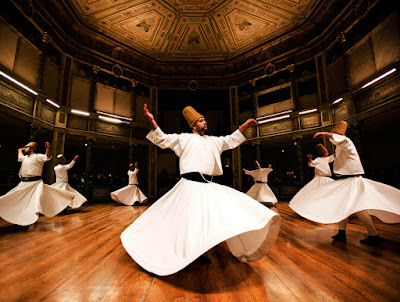
The idea of "the dance of the stars" has survived in modern popular culture with the long-running hit television show "Dancing with the Stars," but the concept was far more prevalent in ancient times. The traditional European "Maypole Dance," for example, features a central tree or pillar topped with a cross and two equal-sized circles on either side representing the Sun and Moon. Dancers circle around the Maypole holding long colorful streamers which wrap and weave around the central pillar causing the dancers to narrow their circles. The pillar is Polaris at the Pole, the dancers represent the fixed and wandering stars, while the spiraling streamers show the paths of the Sun and Moon over and around the Earth. During this summer celebration, like the ever-narrowing spiraling streamers, the Sun has actually just narrowed its spiral path from its greatest southern extent at the Tropic of Capricorn during December winter solstice and fast approaches its arrival at the northern Tropic of Cancer during the upcoming summer solstice. In fact, originally, and still today in many countries, the "May"pole dance is not performed in May at all, but rather on June 21st, the very day the Sun reaches its northern-most peak.
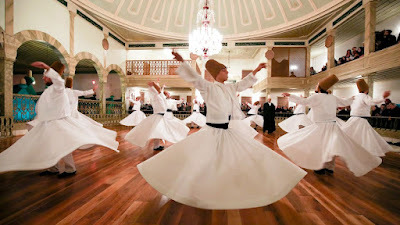
The Sufi Muslim sect known as the Mevlevi Order, or the "whirling dervishes," have also preserved a form of polar worship with their circular dance which is said to represent "the harmonious movement of the universe." The dervishes wear a conical cap directed to the zenith, point their right hand to heaven and their left to Earth, then spin circles in place causing their robes to flair out making another conical circle around them, all while internally incessently intoning the name of God (Allah). The founder of the Mevlevi himself wrote that "He who is above all combination, all distinction, is a Tree without branches, or trunk, or roots to which the mind can be attached." This references a concept found all over the ancient world, regarding a macrocosmic and microcosmic World Tree - what the Norse called "Yggdrasil," the Germans called "Irmensul," the Hindu "Jambudvipa," the Taoist paradisical Tung tree, the Buddhist Bodhi Tree of Wisdom, the giant tree of the Finnish Kalevala, the Celtic Golden Apple Tree of Avalon, the Egyptian Tree of Life, and the tree at the center of the biblical Garden of Eden.

"In the centre of the Garden of Eden, according to Genesis 3, there was a tree exceptional in position, in character, and in its relations to men. Its fruit was 'good for food,' it was 'pleasant to the eyes,' and 'a tree to be desired.' At first sight it would not perhaps appear how a study of this tree in the different mythologies of the ancient world could assist us in locating primitive Paradise. In the discussions of such sites as have usually been proposed it could not; but if the Garden of Eden was precisely at the North Pole, it is plain that a goodly tree standing in the centre of that Garden would have had a visible and obvious cosmical significance which could by no possibility belong to any other. Its fair stem shooting up as arrow-straight as the body of one of the 'giant trees of California,' far overtopping, it may be, even such gigantic growths as these, would to any one beneath have seemed the living pillar of the very heavens. Around it would have turned the 'stars of God,' as if in homage; through its topmost branches the human worshiper would have looked up to that unmoving centre-point where stood the changeless throne of the Creator. How conceivable that that Creator should have reserved for sacred uses this one natural altar-height of the Earth, and that by special command He should have guarded its one particular adornment from desecration! If anywhere in the temple of nature there was to be an altar, it could only be here. That it was here finds a fresh and unexpected confirmation in the singular agreement of many ancient religions and mythologies in associating their Paradise-Tree with the axis of the world, or otherwise, with equal unmistakableness, locating it at the Arctic Pole of the Earth." -Dr. William Warren, “Paradise Found: The Cradle of the Human Race at the North Pole” (262-3)
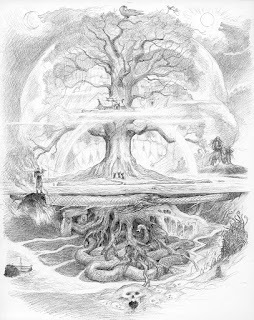 The Norse Yggdrasil tree exists at the very center of their world and cosmology, with its roots descending into hell, its midbranches overarching the Earth, and its top reaching to heaven. Likewise the medieval legend of Seth's visit to the Garden of Eden sees a central Tree of Life with its crown in heaven and roots in hell, distilling a life-saving "Oil of Mercy" obtained for his dying father. The Hindu world tree also provided their gods with an immortality drink called "Soma," and existed at the North Pole with its roots reaching to the underworld of Yama god of death, its top extending to the heavenly realm of benevolent gods, and its body the central sustaining axis of the universe. The Mayan world tree similarly was called "yaax-chel-cab" which means "the first tree of the world," and was a gigantic central cosmic ceiba tree with its trunk planted on Earth reaching straight upwards through circular holes made in seven heavenly celestial planes that souls of the dead ascend according to merit. The Lenni Lenape Native Americans even perform religious rituals in large tree houses using living trunks as the central post to physically embody this symbolism. To this day, many Mayan village centers have a single sacred Ceiba tree growing due to these surviving ancient beliefs. They always plant them within sight of the town hall, offer incense to them, elect their mayors beneath them, and have done so for countless centuries.
The Norse Yggdrasil tree exists at the very center of their world and cosmology, with its roots descending into hell, its midbranches overarching the Earth, and its top reaching to heaven. Likewise the medieval legend of Seth's visit to the Garden of Eden sees a central Tree of Life with its crown in heaven and roots in hell, distilling a life-saving "Oil of Mercy" obtained for his dying father. The Hindu world tree also provided their gods with an immortality drink called "Soma," and existed at the North Pole with its roots reaching to the underworld of Yama god of death, its top extending to the heavenly realm of benevolent gods, and its body the central sustaining axis of the universe. The Mayan world tree similarly was called "yaax-chel-cab" which means "the first tree of the world," and was a gigantic central cosmic ceiba tree with its trunk planted on Earth reaching straight upwards through circular holes made in seven heavenly celestial planes that souls of the dead ascend according to merit. The Lenni Lenape Native Americans even perform religious rituals in large tree houses using living trunks as the central post to physically embody this symbolism. To this day, many Mayan village centers have a single sacred Ceiba tree growing due to these surviving ancient beliefs. They always plant them within sight of the town hall, offer incense to them, elect their mayors beneath them, and have done so for countless centuries. 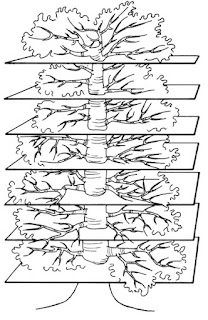 "The cosmic image of the ancient Nahua tribes of Texcoco, Chalco, and Tlaxcala distinguished nine underworlds and as many heavens, while the Aztec sometimes spoke of thirteen heavens. According to the original concept, these heavens were the steps by which the sun ascended from east to west during the morning, and by which he descended in the afternoon in order to effect a parallel journey at night when passing through the kingdom of the dead. In this way, the highest heaven and the lowest underworld were not to be found at the end but in the center of the two series of steps. The thirteen gods of the diurnal hours and the nine gods of the nocturnal ones correspond to the steps or levels of the heavens and of the underworld. The sun god reigns over the central (seventh) hour of the day, and the god of death rules over the central (fifth) hour of the night. Once again, spatial and temporal concepts have been coordinated." -Walter Krickeberg
"The cosmic image of the ancient Nahua tribes of Texcoco, Chalco, and Tlaxcala distinguished nine underworlds and as many heavens, while the Aztec sometimes spoke of thirteen heavens. According to the original concept, these heavens were the steps by which the sun ascended from east to west during the morning, and by which he descended in the afternoon in order to effect a parallel journey at night when passing through the kingdom of the dead. In this way, the highest heaven and the lowest underworld were not to be found at the end but in the center of the two series of steps. The thirteen gods of the diurnal hours and the nine gods of the nocturnal ones correspond to the steps or levels of the heavens and of the underworld. The sun god reigns over the central (seventh) hour of the day, and the god of death rules over the central (fifth) hour of the night. Once again, spatial and temporal concepts have been coordinated." -Walter KrickebergAnthropologist William R. Holland wrote of the Maya, that they: "consider the heavens the home of benevolent deities, creators and makers of all human, animal, and vegetable life. Conversely, the lower world is the residence of evil gods who eternally fight to undo the work of the heavenly gods and try to win over new occupants for the world of the dead. Life is a constant struggle between the forces of good and evil." In 1982 anthropologist Peter Roe completed an exhaustive study of 105 Amazonian tribes and found their cosmologies strikingly similar. He sumarized their worldviews as follows: “There is a disk-shaped earth surrounded by ocean. This disk is sandwiched between upper and lower worlds which are often subdivided into several levels. There is also a world tree with its roots in the underworld and its crown in the heavens.”
 Yet another example of this nearly ubiquitous concept is the Buddhist sacred Bodhi Tree of Wisdom under which the Buddha was enlightened. Nowadays associated with a local tree in India, the original legend of the Bodhi Tree of Wisdom placed it at the center of the Earth, where it helped Gautama Buddha pass over the celestial water to reach Nirvana. When Buddha was unable to cross from one bank to the other, the spirit of the Bodhi tree stretched its arms to aid him across, and then sitting underneath the tree he gained enlightenment. In Buddhist art and sculpture the Bodhi tree is often pictured with the "Chattra" umbrella symbol above it. According to scholars Dr. William Warren and Gerald Massey, this ornate parasol symbolizes the dome of the heavens and the north polar home of the gods.
Yet another example of this nearly ubiquitous concept is the Buddhist sacred Bodhi Tree of Wisdom under which the Buddha was enlightened. Nowadays associated with a local tree in India, the original legend of the Bodhi Tree of Wisdom placed it at the center of the Earth, where it helped Gautama Buddha pass over the celestial water to reach Nirvana. When Buddha was unable to cross from one bank to the other, the spirit of the Bodhi tree stretched its arms to aid him across, and then sitting underneath the tree he gained enlightenment. In Buddhist art and sculpture the Bodhi tree is often pictured with the "Chattra" umbrella symbol above it. According to scholars Dr. William Warren and Gerald Massey, this ornate parasol symbolizes the dome of the heavens and the north polar home of the gods. "The Paradise-tree of the Chinese Tauists is also a World-tree. It is found in the centre of the enchanting Garden of the Gods on the summit of the polar Kwen-lun. Its name is Tong, and its location is further denned by the expression that it grows 'hard by the closed Gate of Heaven.' As in many of the ancient religions, the mount on which, after the Flood, the ark rested was considered the same as that from which in the beginning the first man came forth, it is not strange to find the tree on the top of the mountain of Paradise remembered in some of the legends of the Deluge. In the Tauist legend it seems to take the place of the ark. Thus we are told that 'one extraordinary antediluvian saved his life by climbing up a mountain, and there and then, in the manner of birds plaiting a nest, he passed his days on a tree, whilst all the country below him was one sheet of water. He afterwards lived to a very old age, and could testify to his late posterity that a whole race of human beings had been swept from the face of the earth. It is at least suggestive to find this same idea of salvation from a universal deluge by means of a miraculous tree growing on the top of the divine Mountain of the North among the Navajo Indians of our own country. Speaking of the men of the world before our own, and of the warning they had received of the approaching flood, their legends go on: Then they took soil from all the four corner mountains of the world, and placed it on top of the mountain that stood in the North; and thither they all went, including the people of the mountains, the salt-woman, and such animals as then lived in the third world. When the soil was laid on the mountain, the latter began to grow higher and higher, but the waters continued to rise, and the people climbed upwards to escape the flood." -Dr. William Warren, “Paradise Found: The Cradle of the Human Race at the North Pole” (274-5)
 The ancient Egyptians, Phoenicians, Persians, Greeks, Syrians and Assyrians all had their own versions of a world tree as well. The Greek Winged Oak of Pherecydes and the Holy Palm of Apollo in the Hyperborean Garden of Hesperides were two stories of this sacred tree. The Egyptian Tree of Life was located at the axis of Earth and was home to Bennu, the sun-bird, who sat upon its branches. The Northwind from his polar perch yielded a life-sustaining celestial rain upon the Earth and down to Duat, the underworld. The Persian Zoroastrian tree grew atop the summit of "Hara-berezaiti," the world's tallest mountain at the geographic center-point of the universe, around which the stars revolved, and behind which the Sun hid at night. It was home to "Ardvi-Sura," the polar head-spring source of all waters, falling from heavenly rivers to Earth before descending to the underworld.
The ancient Egyptians, Phoenicians, Persians, Greeks, Syrians and Assyrians all had their own versions of a world tree as well. The Greek Winged Oak of Pherecydes and the Holy Palm of Apollo in the Hyperborean Garden of Hesperides were two stories of this sacred tree. The Egyptian Tree of Life was located at the axis of Earth and was home to Bennu, the sun-bird, who sat upon its branches. The Northwind from his polar perch yielded a life-sustaining celestial rain upon the Earth and down to Duat, the underworld. The Persian Zoroastrian tree grew atop the summit of "Hara-berezaiti," the world's tallest mountain at the geographic center-point of the universe, around which the stars revolved, and behind which the Sun hid at night. It was home to "Ardvi-Sura," the polar head-spring source of all waters, falling from heavenly rivers to Earth before descending to the underworld."In our interpretation the original river is from the sky; the division takes place on the heights at the Pole, and the four resulting rivers are the chief streams of the circumpolar continent as they descend in different directions to the surrounding sea. Does such a view find any support in the traditions of the ancient world? That it does will be clear to anyone who has carefully read thus far. Let us take the rivers of the Persian cradle of the race. Where do they rise? If the investigator of this question have made no previous studies in Comparative Sacred Hydrography, he will be surprised to find that in Persian thought, not only the Paradise rivers, but also all the rivers of the whole earth, have but one headspring and but one place of discharge. This head-spring is the Ardvi-Sura, situated in heaven, the heaven of the Pole. 'This heavenly fountain,' says Haug, summarizing the contents of the Aban Yasht, 'has a thousand springs and a thousand canals, each of them forty days journey long. Thence a channel goes through all the seven keshvares, or regions of the earth, conveying everywhere pure celestial waters.'" -Dr. William Warren, “Paradise Found: The Cradle of the Human Race at the North Pole” (250-1)
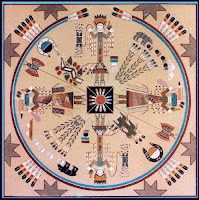 These concepts of celestial rainfall and heavenly rivers are found concurrent with most World Tree myths. In the Mexican version, Tlaloc, the god of water, lives atop the world's tallest mountain whence come all the Earth's rains and streams. In the Indian version, the heaven-spring Ganga falls upon Mount Meru, first watering the land of gods at the pole, then flowing outward towards the cardinal points from four main rivers into the Arctic ocean. The Hindu epic Mahabharata says the head-spring exists in the highest heaven of Vishnu, high above the highest star Druva (Polaris). During their descent the waters first wash Druva, then the Seven Rishis (Big Dipper), and then fall atop Mount Meru, where the heavenly Ganga river "divides into four mighty rivers, flowing in opposite directions," and feeds the world's oceans.
These concepts of celestial rainfall and heavenly rivers are found concurrent with most World Tree myths. In the Mexican version, Tlaloc, the god of water, lives atop the world's tallest mountain whence come all the Earth's rains and streams. In the Indian version, the heaven-spring Ganga falls upon Mount Meru, first watering the land of gods at the pole, then flowing outward towards the cardinal points from four main rivers into the Arctic ocean. The Hindu epic Mahabharata says the head-spring exists in the highest heaven of Vishnu, high above the highest star Druva (Polaris). During their descent the waters first wash Druva, then the Seven Rishis (Big Dipper), and then fall atop Mount Meru, where the heavenly Ganga river "divides into four mighty rivers, flowing in opposite directions," and feeds the world's oceans. "And all this lays bare for us the origin of the Iranian and Hindu holiness of water; 'river-water is everywhere throughout India held to be instinct with divinity,' says Sir Monier Williams. Among primaeval peoples, who observed the connection between the rains and the springs and watercourses which were manifestly swelled by them, all waters became of supernal origin, the gift of the heavens-god. And thus the heavens-river, clearly discerned by the eye of faith in the heavens as the Milky Way became the generation and sanctifier of all earthly rivers. According to Josephus, the Ganges, Tigris, Euphrates and Nile were but members of the one great ocean-River of the Greeks, which ran about the whole earth; which Aristotle described as having its origin in the upper heavens, descending in rain upon the earth, feeding, as Hesiod, Homer, and Euripides said, all fountains and rivers, and every sea; then branching out into the Rivers of the underworld, to be returned fire-purged and sublimated to the upper heavens, there to recommence its round." -John O’Neill, “Night of the Gods vol ii” (866)
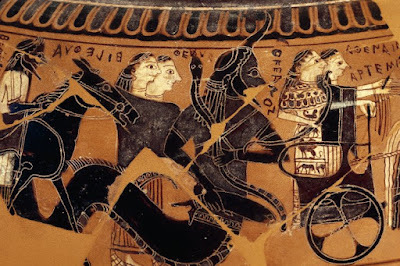
The ancient Greek poets also often alluded to this concept with "Okeanos," the great Earth encircling river. Homer wrote that Okeanos was where "all rivers and every sea and all fountains flow." Hesiod in his Theogony similarly wrote that "all rivers, as sons, and all fountains and brooks, as daughters, are traced back to Okeanos." The Greek poets personified Okeanos as a god, "the great sea-god who girdles the entire world," or as Aeschylus wrote, "He who with his sleepless current encircles the whole earth." Plato also wrote of Okeanos directly connecting it with the four polar rivers in his Phaedo, stating, "among the many are four streams, the greatest and outermost of which is that called Okeanos, which flows round in a circle." And if any doubt remains, Orphic Hymn 83 explicitly mentions the fountain at the Pole: "Okeanos whose nature ever flows, from whom at first both gods and men arose; sire incorruptible, whose waves surround, and earth's all-terminating circle bound: hence every river, hence the spreading sea, and earth's pure bubbling fountains spring from thee. Hear, mighty sire, for boundless bliss is thine, greatest cathartic of the powers divine: earth's friendly limit, fountain of the pole, whose waves wide spreading and circumfluent roll. Approach benevolent, with placid mind, and be forever to thy mystics kind."
The Chinese story of Mount Kunlun and the Tong tree also features "T'ien Ho," the many channeled river, or river of eight, which falls and separates at the pole. The head-spring of these celestial waters and source of this mythology is none other than that area of the heavens known to the ancients as the Dark Rift, and better known to us as the Milky Way. In the Chinese version, celestial rainfall from the Milky Way descends on the North Pole separating into many channels including their sacred Yellow River, which they see as a continuation of the T'ien Ho heavenly stream. Then from there the many channels flow into the oceans transporting pure heavenly waters across the entire world.
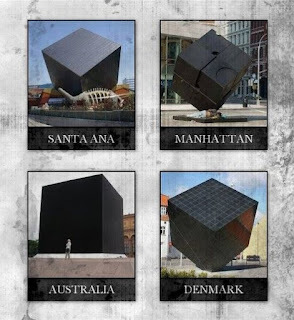 "However named, all waters are simply portions of the same heaven-descending stream. The other innumerable waters and rivers, springs and channels, are one in origin with those, so in various districts and various places they call them by various names. Even plant-sap, and blood, and milk, are parts of the one cosmic current. All these, through growth, or the body which is formed, mingle again with the rivers, for the body which is formed and the growth are both one. Everything of a liquid nature, therefore, in the whole world is conceived of as proceeding from one source high in the north-polar sky. Into such a marvelously complete cosmical circulatory water system did the Iranic imagination develop the primitive head-stream of Eden. But never, even in the most extravagant mythological adornments of the idea, was it for a moment forgotten that the original undivided stream originates in the north polar sky; and that its division into earthly streams and rivers is on the holy mount which stands in the centre." -Dr. William Warren, “Paradise Found: The Cradle of the Human Race at the North Pole” (254)
"However named, all waters are simply portions of the same heaven-descending stream. The other innumerable waters and rivers, springs and channels, are one in origin with those, so in various districts and various places they call them by various names. Even plant-sap, and blood, and milk, are parts of the one cosmic current. All these, through growth, or the body which is formed, mingle again with the rivers, for the body which is formed and the growth are both one. Everything of a liquid nature, therefore, in the whole world is conceived of as proceeding from one source high in the north-polar sky. Into such a marvelously complete cosmical circulatory water system did the Iranic imagination develop the primitive head-stream of Eden. But never, even in the most extravagant mythological adornments of the idea, was it for a moment forgotten that the original undivided stream originates in the north polar sky; and that its division into earthly streams and rivers is on the holy mount which stands in the centre." -Dr. William Warren, “Paradise Found: The Cradle of the Human Race at the North Pole” (254) This concept of "holy water" exists in nearly all of the world's religions from Christianity, Islam and Sikhism, to Buddhism, Hinduism, and Jainism. The Christian cross itself is the same shape as the 4 rivers at the North Pole and before entering church the parishoner dips their fingers in holy water and touches 4 points on their bodies. To bless the water, the priest first makes the sign of the cross over the basin, touches the surface with the palm of his hand, and says "I bless thee, creature of water, by the God that made thee issue from the earthly Paradise in four rivers." Christian baptism also takes place "ex aqua et spiritu sancto," or "of water and of the holy spirit" where the holy spirit is transported into the "born again" Christian through the medium of water. In Buddhism monks similarly bless vessels of holy water then use special wooden fans to sprinkle the water over temple-goers. In Islam, followers drink or wash in water from their sacred "Zamzam" Well in Mecca.
This concept of "holy water" exists in nearly all of the world's religions from Christianity, Islam and Sikhism, to Buddhism, Hinduism, and Jainism. The Christian cross itself is the same shape as the 4 rivers at the North Pole and before entering church the parishoner dips their fingers in holy water and touches 4 points on their bodies. To bless the water, the priest first makes the sign of the cross over the basin, touches the surface with the palm of his hand, and says "I bless thee, creature of water, by the God that made thee issue from the earthly Paradise in four rivers." Christian baptism also takes place "ex aqua et spiritu sancto," or "of water and of the holy spirit" where the holy spirit is transported into the "born again" Christian through the medium of water. In Buddhism monks similarly bless vessels of holy water then use special wooden fans to sprinkle the water over temple-goers. In Islam, followers drink or wash in water from their sacred "Zamzam" Well in Mecca. How could these detailed parallel mythologies and concepts all rise and flourish independently of one another thousands of years ago? What could be the origin and impetus of these ideas of world trees, celestial rivers, and polar mountains if not their literal existence? The next section will explore the metaphorical meanings of these ancient allegories, how modern man can make sense of them, and why this important information is so suppressed.


December 31, 2021
Polar Astronomy and Anthropology

The North Pole is the inherent geographical focal point of all creation. It is the perfect center of the bullseye, the magnetic attractor of all the world's compasses, the originator of all the world's tides, and home to the only motionless star in the heavens, around which all the other stars, the Sun, and the Moon revolve. In ancient times it was also claimed to be home to the tallest mountain and the tallest people on Earth. As recently as the 19th century, explorers like Olaf Jansen have continued telling so-called "tall tales" of meetings with races of giant human beings who live at the Pole.
In his book "The Smoky God," Olaf Jansen claimed to have journeyed to the North Pole with his father in 1829 where they met and mingled 2 years with a race of 12 foot tall giants who lived up to 800 years, spoke a language similar to Sanskrit, and inhabited a paradisical capital city named "Eden." This particular story is most likely a piece of fiction, but echoes a long-standing tradition of similar claims that the North Pole is or was once home to a paradisical Edenic abode inhabited by races of gigantic and/or miniature human beings.
In Heylin's 1659 book "Cosmographie," he states that on the North of Lappia and Biarmia, near the Pole, lives a race of Pygmies, the tallest of which are not above four feet high. Gerardus Mercator's 1595 polar map includes this island of Pygmies with a caption mentioning their tiny four-foot stature. Johannes Ruysch's 1508 world map also shows the many surrounding polar islands claiming 2 of them inhabited, but without mentioning the alleged inhabitant's size or stature. In the book "Gesta Hammaburgensis Ecclesiae Pontificum," Archbishop Adalbert's team of Frisian explorers told of encountering giant human beings living in caves and underground hollows during their 1035 Polar expedition.
In ancient Greek and Roman texts from Pindar, Herodotus, Hesoid and Homer, to Virgil and Cicero, it was universally claimed that the North Pole was home to a race of giants called the "Hyperboreans" who lived for over a thousand years and enjoyed lives of perfect happiness. Hyperborea was allegedly bathed in 24 hour sunlight with the Sun only ever rising or setting once every year! Pliny the Elder wrote in his Natural History book IV that, "The farthest of all, which are known and spoke of, is Thule; in which there be no nights at all, as we have declared, about mid-summer, namely when the Sun passes through the sign Cancer; and contrariwise no days in mid-winter: and each of these times they suppose, do last six months, all day, or all night."

For observers standing at the Pole, the heavens would appear to have been created just for them. Their unique perspective places Polaris, the only motionless star in the sky, perfectly situated directly above them, with all the other visible stars rotating horizontal left to right paths 360 degrees around, all at an apparently equal distance away. The Sun and Moon also rotate horizonally around the polar observer, with the Sun rising and setting only once per year, creating 6 month days and 6 month nights!
"If an observer is stationed at the North Pole, the first thing that will strike him is the motion of the celestial sphere above his head. Living in the temperate and tropical zones we see all heavenly objects rise in the east and set in the west, some passing over our head, others traveling obliquely. But to the man at the Pole, the heavenly dome above will seem to revolve round him, from left to right, somewhat like the motion of a hat or umbrella turned over one’s head. The stars will not rise and set, but will move round and round, in horizontal planes, turning like a potter’s wheel, and starting on a second round when the first is finished, and so on, during the long night of six months. The sun, when he is above the horizon for 6 months, would also appear to revolve in the same way. The centre of the celestial dome over the head of the observer will be the celestial North Pole, and naturally enough his north will be over-head, while the invisible regions below the horizon would be in the south." -Lokamanya Bal Gangadhar Tilak, “The Arctic Home in the Vedas” (42)
For polar observers the Sun rises in the South, not the East, and circles horizontally around rising ever so slightly in the sky, about a quarter degree per day. This creates an extended morning twilight with its brilliant colors which instead of lasting for the usual 45 minutes, lasts around 45 days! Every year at the spring equinox, after a long winter night, dawn begins to break and the first traces of the Sun creep above the horizon. By summer solstice the Sun reaches its highest point in the polar sky, around 23.5 degrees, and begins its slow, almost imperceptible descent. At the autumnal equinox, the last traces of the Sun disppear beyond the horizon, and an extended evening twilight persists for a month and half, after which the polar observer will not see sunlight again until spring. Thanks to abundant starlight, regular aurora borealis activity, and two weeks of moonlight per month, the long polar nights are not pitch black, but actually quite well lit and beautiful.
"We have stated that to an observer at the North Pole, there will be a night of 6 months, and one is likely to infer therefrom that there will be total darkness at the Pole for one half the portion of the year. Indeed one is likely to contemplate with horror, the perils and difficulties of a long night of six months, during which not only the light but the warmth of the sun has to be artificially supplied. As a matter of fact, such a supposition is found to be erroneous. First of all, there will be the electric discharges, known as Aurora Borealis, filling the polar night with their charming glories, and relieving its darkness to a great extent. Then we have the moon, which, in her monthly revolution, will be above the polar horizon for a continuous fortnight, displaying her changing phases, without intermission, to the polar observer. But the chief cause, which alleviates the darkness of the polar night, is the twilight before the rising and after the setting of the sun. The dawn in the tropical or the temperate zone is but brief and evanescent, and it recurs after every 24 hours. But still it has formed the subject of poetical descriptions in different countries. If so, how much more the spectacle of a splendid long dawn, after a darkness of two months, would delight the heart of a Polar observer, and how he will yearn for the first appearance of the light on the horizon." -Lokamanya Bal Gangadhar Tilak, “The Arctic Home in the Vedas” (44-46)
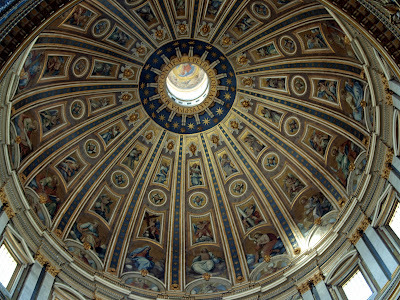
In all, a year at the Pole sees approximately six months of continuous daylight, followed by a month and a half of evening twilight, then three months of relative darkness, ending in a month and half long spring dawn. The exact number of days for each portion of the polar year is disputed among various authorities, however, which raises the question again as to whether or not modern man truly has attained the Pole. If we have research bases and encampments built all over at and around the North Pole as claimed, why is there not a single video online or anywhere else showing a year-long continuous time-lapse of this world wonder!? To see Polaris unmoving directly 90 degrees overhead while all the other stars rotate horizontally around uninterrupted by sunlight for months at a time, then to watch the first rays of the longest, most beautiful dawn lighting the horizon and revolving 360 degrees around without setting for many more months, would be an absolute spectacle to behold, worthy of an Imax documentary, and a true wonder of the world, but somehow no such video exists.
“First of all appears low in the horizon of the night-sky a scarcely visible flush of light. At first it only makes a few stars’ light seem a trifle fainter, but after a little it is seen to be increasing, and to be moving laterally along the yet dark horizon. Twenty-four hours later it has made a complete circuit around the observer, and is causing a larger number of stars to pale. Soon the widening light glows with the luster of ‘Orient pearl.’ Onward it moves in its stately rounds, until the pearly whiteness burns into ruddy rose-light, fringed with purple and gold. Day after day, as we measure days, this splendid panorama circles on, and, according as atmospheric conditions and, clouds present more or less favorable conditions of reflection, kindles and fades, kindles and fades, — fades only to kindle next time yet more brightly as the still hidden sun comes nearer and nearer his point of emergence. At length, when for two long months such prophetic displays have been filling the whole heavens with these increscent and revolving splendors, the sun begins to emerge from his long retirement, and to display himself once more to human vision. After one or two circuits, during which his dazzling upper limb grows to a full-orbed disk, he clears all hill-tops of the distant horizon, and for six full months circles around and around the world’s great axis in full view, suffering no night to fall upon his favored home-land at the Pole. Even when at last he sinks again from view he covers his retreat with a repetition of the deepening and fading splendors which filled his long dawning, as if in these pulses of more and more distant light he were signaling back to the forsaken world the promises and prophecies of an early return.” -Dr. William Warren
You would think such a sight would be worthy of recording, yet somehow, no one in history has ever bothered to do so. If we have truly attained the North Pole and have permanent and semi-permanent structures with people stationed at and around there year-round, why in the flat world has no one ever recorded an annual time-lapse of this incredible occurance?
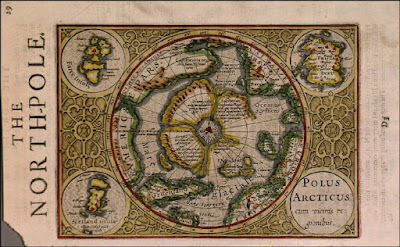
The polar 6 month day and 6 month night has been written about by diverse cultures throughout history, many insisting that their ancestors or gods were the original inhabitants. In the ancient Indian Vedas, the "day of the gods," and "night of the gods," were each six months in duration, and their gods lived atop Mount Meru at the North Pole. The Surya Siddhanta XII, 67 states that "At Meru, Gods behold the sun after but a single rising during the half of his revolution beginning with Aries," and the Institutes of Vishnu says, "The southern progress of the sun is (with them) a night and a year is (with them) a day and a night." In Norse mythology, it is claimed that before the present established order of the world, their Sun rose in the South, which is what would have been experienced by their polar ancestors. In ancient Iranian mythology, Yima, the first man and King of the Golden Age lived in an Edenic abode called Vara, where the Sun only rose and set once per year.
"A phenomenon like this cannot fail to be permanently impressed on the memory of a Polar observer, and it will be found later on that the oldest traditions of the Aryan race have preserved the recollection of a period, when its ancestors witnessed such wonderful phenomenon, — a long and continuous dawn of several days, with its lights laterally revolving on the horizon, in their original home." -Lokamanya Bal Gangadhar Tilak, “The Arctic Home in the Vedas” (46-7)
The heavenly dome rotating perfectly horizontally overhead for polar observers is another unique peculiarity of polar astronomy found in ancient mythology. In Greek mythology, the gods rule from Mount Olympus and as the Iliad states, "from the upper sky, the celestial dome in which sun, moon and stars wheel silently around the Pole." In the Vedas, Indra "supports the heavens as on a pole," and "upholds heaven and earth, and turns the widest expanse, as the wheels of a chariot are held by the axle." An imaginary line from the North Pole to Polaris, would appear perfectly vertical and like a handle supporting the twirling umbrella of the heavens, or an axis supporting the wheel of a chariot.
"If we combine the two statements, that the heavens are supported as on a pole and that they move like a wheel, we may safely infer that the motion referred to is such a motion of the celestial hemisphere as can be witnessed only by an observer at the North Pole. In the Rig-Vedas I, 24, 10 the constellation of Ursa Major (Rikshah) is described as being placed “high” (uchhâh), and, as this can refer only to the altitude of the constellation, it follows that it must then have been over the head of the observer, which is possible only in the Circum-Polar regions." -Lokamanya Bal Gangadhar Tilak, “The Arctic Home in the Vedas” (60-1)
In the Mahabharata, during Arjuna's visit to Mount Meru, chapters 163 and 164 of the Vanaparvan state that, "At Meru, the sun and the moon go round from left to right every day, and so do all the stars. The day and the night are together equal to a year to the residents of that place." The ancient Laws of Manu I, 67 state, "A human year is a day and a night of the Gods; thus are the two divided, the northern passage of the sun is the day and the southern the night." And the Taittiriya Brahmana says, "That which is a year is but a single day of the Gods."
In the collection of ancient Zoroastrian texts known as the "Avesta," the Aryan Paradise, known as "Airyana Vaêjo" is described as a blissful place where the Sun rose only once per year and was destroyed by relentless snow and ice forcing the inhabitants, Earth's original progenitors, to migrate southwards. This same idea that the first humans devolved from God or gods at the North Pole is replete within ancient scriptures, and starkly contrasts modern mainstream claims that the first humans evolved from primates in Africa.
Two excellent books were written on this subject, one by Boston University president and professor Dr. William Warren entitled, "Paradise Found: The Cradle of the Human Race at the North Pole," and another by the renouned Indian teacher and activist Lokamanya Bal Gangadhar Tilak entitled, "The Arctic Home in the Vedas." In both well-researched publications Warren and Tilak present convincing arguments with abundant supporting evidence suggesting that our most ancient ancestors lived at the North Pole and spread outwards southwards from there likely due to climate changes.
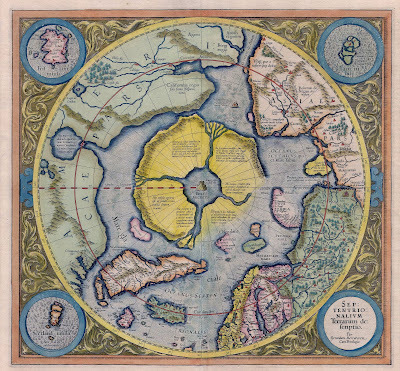
"Our hypothesis calls for an antediluvian continent at the Arctic Pole. It is interesting to find that a writer upon the Deluge writing more than forty years ago advanced the same postulate. Is the supposition that there existed such a continent scientifically admissible? Until very recently too little was known of the geology of the high latitudes to warrant or even to occasion the discussion of such a question. Even now, with all the contemporary interest in Arctic exploration, it is difficult to find any author who has distinctly propounded to himself and discussed the question as to the geologic age of the Arctic Ocean. It will not be strange, therefore, if we have here to content ourselves with showing, first, that geologists and paleontologists do not think the present distribution of Arctic sea and land to be the primeval one ; and secondly, that in their opinion, incidentally expressed, a 'continent' once existed within the Arctic Circle of which at present only vestiges remain. Mr. Alfred Russel Wallace incidentally shows that the facts of Arctic paleontology call for the supposition of a primitive Eocene continent in the highest latitudes, a continent which no longer exists. His language is, 'The rich and varied fauna which inhabited Europe at the dawn of the Tertiary period as shown by the abundant remains of mammalia wherever suitable deposits of Eocene age have been discovered proves that an extensive Palearctic continent then existed.' Another most eminent authority in Arctic paleontology, the late Professor Heer, of Zurich, fully fifteen years ago arrived at and published the conclusion that the facts presented in the Arctic fossils plainly point to the existence in Miocene time of a no longer existing polar continent. On another and more lithological line of evidence Baron Nordenskjold, the eminent Arctic explorer, has arrived at the same conclusion. Speaking of certain rock strata north of the 68th degree of north latitude, he says, 'An extensive continent occupied this portion of the globe when these strata were deposited.' Elsewhere he speaks of this 'ancient polar continent' as something already accepted and universally understood among scientific men." -William Warren, “Paradise Found: The Cradle of the Human Race at the North Pole” (73)
"It has been already stated that the beginnings of Aryan civilization must be supposed to date back several thousand years before the oldest Vedic period; and when the commencement of the post-Glacial epoch is brought down to 8000 B.C., it is not at all surprising if the date of primitive Aryan life is found to go back to it from 4500 B.C., the age of the oldest Vedic period. There are many passages in the Rig-Veda, which, though hitherto looked upon as obscure and unintelligible, do, when interpreted in the light of recent scientific researches, plainly disclose the Polar attributes of the Vedic deities, or the traces of an ancient Arctic calendar; while the Avesta expressly tells us that the happy land of Airyana Vaêjo, or the Aryan Paradise, was located in a region where the sun shone but once a year, and that it was destroyed by the invasion of snow and ice, which rendered its climate inclement and necessitated a migration southward. These are plain and simple statements, and when we put them side by side with what we know of the Glacial and the post-Glacial epoch from the latest geological researches, we cannot avoid the conclusion that the primitive Aryan home was both Arctic and inter Glacial. The discovery of the intimate relationship between Sanskrit and Zend on the one hand and the languages of the principal races of Europe on the other, a complete revolution took place in the views commonly entertained of the ancient history of the world. It was perceived that the languages of the principal European nations — ancient and modern — bore a close resemblance to the languages spoken by the Brahmans of India and the followers of Zoroaster; and from this affinity of the Indo-Germanic languages it followed inevitably that all these languages must be the off-shoots or dialects of a single primitive tongue, and the assumption of such a primitive language further implied the existence of a primitive Aryan people." -Lokamanya Bal Gangadhar Tilak, “The Arctic Home in the Vedas” (1-2)
In 1786 Sir William Jones, a Supreme Court judge who could speak 30 languages, gave his Third Anniversary Discourse to the Asiatic Society where he declared that the similarities between Sanskrit, Greek, Latin, German, Celtic and Persian languages could only be explained on the hypothesis that they all shared a common parentage. His contemporary, the German philosopher Hegel, compared the consequences of Jones' revelation to the discovery of a whole new world and his ground-breaking work on this subject established him as the founder of comparative linguistics. Jones wrote that, "The Sanscrit language, whatever be its antiquity, is of a wonderful structure; more perfect than the Greek, more copious than the Latin, and more exquisitely refined than either, yet bearing to both of them a stronger affinity, both in the roots of verbs and the forms of grammar, than could possibly have been produced by accident; so strong indeed, that no philologer could examine them all three, without believing them to have sprung from some common source, which, perhaps, no longer exists; there is a similar reason, though not quite so forcible, for supposing that both the Gothic and the Celtic, though blended with a very different idiom, had the same origin with the Sanscrit; and the old Persian might be added to the same family."
Scholar and renowned linguist Charles Berlitz of Berlitz language schools spoke an amazing 32 languages and just like Sir William Jones, his life's research in comparative linguistics led him to the inescapable conclusion that all the world's languages must trace back to a single, lost, ancient dialect. Berlitz actually wrote several books about Atlantis and believed the primary language of the human race originated there. In my previous book, "The Atlantean Conspiracy," I also included a large section on Atlantean Etymology, showing how an inordinate number of words and prefixes from languages worldwide share the exact same or incredibly similar meanings and pronunciations, strongly suggesting a common ancient eytmological ancestor.
Researcher and Author John G. Bennett also wrote a paper entitled "The Hyperborean Origin of the Indo-European Culture" in which he argues that ancient languages were more advanced, have devolved into our current languages, and likely originally trace back to a lost polar civiliazation. This idea has also been promoted by esotericists like Helena Blavatsky, Rene Guenon, and Julius Evola who all shared a belief in the Hyperborean, polar origins of mankind. According to them, during a golden age humanity solidified into this material realm and has since undergone devolution. Rather than evolving from apes, they insist humanity has progressively devolved into an apelike condition.
"It is admitted that many of the present explanations of these traditions and legends are unsatisfactory, and as our knowledge of the ancient man is increased, or becomes more definite, by new discoveries in archaeology, geology or anthropology, these explanations will have to be revised from time to time and any defects in them, due to our imperfect understanding of the sentiments, the habits and even the surroundings of the ancient man, corrected. That human races have preserved their ancient traditions is undoubted, though some or many of them may have become distorted in course of time, and it is for us to see if they do or do not accord with what we know of the ancient man from latest scientific researches. In the case of the Vedic traditions, myths and beliefs, we have the further advantage that they were collected thousands of years ago, and handed down unchanged from that remote time. It is, therefore, not unlikely that we may find traces of the primeval Polar home in these oldest books. If the Aryan man did live within the Arctic circle in early times, especially as a portion of the Rig-Veda is still admittedly unintelligible on any of the existing methods of interpretation, although the words and expressions are plain and simple in many places. Dr. Warren has quoted some Vedic traditions along with those of other nations, in support of his theory that the Arctic regions were the birth-place of the human race." -Lokamanya Bal Gangadhar Tilak, “The Arctic Home in the Vedas” (39-40)


May 20, 2021
LEVEL (Flat Earth Film)

It's time for the world to get on our LEVEL:
Produced by Hibbeler Productions: https://www.youtube.com/user/HibbelerProductions
Narrated by Eric Dubay: http://www.youtube.com/c/flateartheric
Featuring O.D.D TV: https://www.youtube.com/user/MrDoseman
Dave Murphy: https://www.youtube.com/user/dmurphy25
Eddie Bravo: https://www.instagram.com/eddiebravo10p/
Santos Bonacci: https://www.youtube.com/user/MrAstrotheology
Tanner Stewart: https://www.youtube.com/c/TStew
Johnny Giampapa: https://www.instagram.com/inkbyjohnnyg/
and more!
If you'd like to support Hibbeler Productions, visit www.levelthefilm.com and stream in HD

January 27, 2021
Modern Polar Discovery Frauds
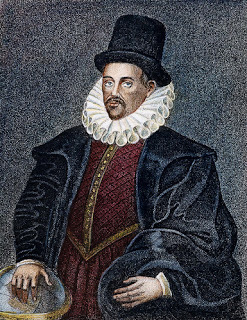
At the turn of the 17th century, shortly after Queen Elizabeth's advisor John Dee was corresponding with Gerardus Mercator regarding the Polar magnetic mountain, Queen Elizabeth's personal physician and knighted President of the College of Physicians, "Sir" William Gilbert, wrote his Opus "De Magnete," in which he argued against the prevailing belief of a polar magnetic mountain, claiming instead the Earth itself to be a great magnet. Coming in the wake of the Copernican revolution, Gilbert's new model in stark contrast to the long-held, now deemed "unscientific" notion that compass needles were attracted to a loadstone mountain at the Pole, proposed that the Copernican ball-Earth actually generated magnetism from a hypothetical molten metal core, which caused a constantly moving di-polar magnetic field over the globe.
To this day Gilbert's hypothesis remains pure speculation since no one in history has ever come close to penetrating or perceiving the supposed 3950 miles to the ball-Earth's core. In reality the deepest drilling operation in history, the Russian Kola Ultradeep, after decades of work and dozens of broken drills managed to penetrate only 8 miles down, so the entire ball-Earth model taught in schools showing detailed descriptions of a crust, outer-mantle, inner-mantle, outer-core and inner-core layers are all purely speculative as we have never even broken through beyond the crust. Furthermore, there is nowhere in nature that molten metal retains any significant magnetic properties once heated past the "Curie Point," let alone create some convoluted constantly moving di-polar field as Gilbert claimed then and proponents of the globe still maintain today.
 Several decades after Gilbert's De Magnete made its impression on the world, another knighted president of the Royal Society, "Sir" Isaac Newton, would write the influential "Principia Mathematica," where he proposed the concept of "gravity" to account (among other things) for how people could exist without falling off the under-side of Copernicus' ball-Earth. Coincidentally (or perhaps conspiratorially) a couple centuries later, it would be yet another royally knighted man, "Sir" Ernest Shackleton of the Royal Navy, who would allegedly complete that upside-down journey under the globe becoming the first person to reach the so-called "Southern Magnetic Pole."
Several decades after Gilbert's De Magnete made its impression on the world, another knighted president of the Royal Society, "Sir" Isaac Newton, would write the influential "Principia Mathematica," where he proposed the concept of "gravity" to account (among other things) for how people could exist without falling off the under-side of Copernicus' ball-Earth. Coincidentally (or perhaps conspiratorially) a couple centuries later, it would be yet another royally knighted man, "Sir" Ernest Shackleton of the Royal Navy, who would allegedly complete that upside-down journey under the globe becoming the first person to reach the so-called "Southern Magnetic Pole."
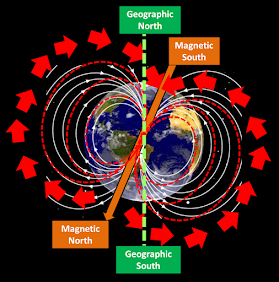 Back when the Earth was perceived as a level plane, there was only one Pole, the North Pole, directly below Polaris, which was both geographically and magnetically the center-point of Earth. Due to the hypothetical globe's hypothetical di-polar magnetic core, however, there suddenly became new frontiers to discover. Not only did Earth have a geographic North Pole in the Arctic, but now its geographic antipode, the South Pole in the Antarctic. Since Gilbert's magnetic poles were caused by perpetually shifting molten metal, there now also came into existence, constantly moving Northern and Southern Magnetic Poles as well. And lastly, Earth's magnetic field was claimed asymmetrical, so that the constantly moving North/South magnetic poles were not even antipodal, meaning a straight line drawn from one to the other failed to pass through the geometric center of their globe. To account for this, two more theoretical poles known as the Geomagnetic North and Geomagnetic South Poles were also added into the convoluted mix.
Back when the Earth was perceived as a level plane, there was only one Pole, the North Pole, directly below Polaris, which was both geographically and magnetically the center-point of Earth. Due to the hypothetical globe's hypothetical di-polar magnetic core, however, there suddenly became new frontiers to discover. Not only did Earth have a geographic North Pole in the Arctic, but now its geographic antipode, the South Pole in the Antarctic. Since Gilbert's magnetic poles were caused by perpetually shifting molten metal, there now also came into existence, constantly moving Northern and Southern Magnetic Poles as well. And lastly, Earth's magnetic field was claimed asymmetrical, so that the constantly moving North/South magnetic poles were not even antipodal, meaning a straight line drawn from one to the other failed to pass through the geometric center of their globe. To account for this, two more theoretical poles known as the Geomagnetic North and Geomagnetic South Poles were also added into the convoluted mix.
 With this, after centuries of failed expeditions to the Pole, the first decade of the 20th century would suddenly claim the discoveries of the Northern Magnetic Pole, the Southern Magnetic Pole, and shortly thereafter, both the Geographic and Geomagnetic North/South poles as well. This turn of the century rush to the Poles was not without its problems, however, and many explorer's supposed polar achievements during this era are now regarded even by mainstream historians as being riddled with fraud and falsehoods.
With this, after centuries of failed expeditions to the Pole, the first decade of the 20th century would suddenly claim the discoveries of the Northern Magnetic Pole, the Southern Magnetic Pole, and shortly thereafter, both the Geographic and Geomagnetic North/South poles as well. This turn of the century rush to the Poles was not without its problems, however, and many explorer's supposed polar achievements during this era are now regarded even by mainstream historians as being riddled with fraud and falsehoods. Before the alleged 20th century successes, many attempts were made to reach the North Pole during the 19th century all of which failed. In 1827 knighted British Royal Navy Rear-Admiral "Sir" William Parry reached a record 82°45′N latitude before being forced to turn back due to impassable thick ice. In 1845 another knighted British Royal Navy Officer "Sir" John Franklin and his ill-fated two-ship, 129-man crew all died during their attempt at the Pole, after becoming stuck in the ice and everyone subsequently succumbing to starvation, hypothermia, tuberculosis, lead poisoning, zinc deficiency, and/or scurvy. In 1875 yet another knighted British Royal Navy Officer, in fact, the Knight Commander of the Royal Order of Bath, Admiral "Sir" Albert Markham made an attempt at the Pole, reaching a new record 83°20′N latitude before turning back due to rampant scurvy and lack of equipment. In 1895 Norwegian explorers Fridtjof Nansen and Hjalmar Johansen made a record breaking 86°14′N attempt before turning back because of lack of food and supplies. Then in 1899 Duke of the Abruzzi, member of the Royal House of Savoy, and Italian Navy Admiral Prince Luigi Amedeo set another record just barely beating out the Norwegians reaching 86°34′N latitude before becoming stuck in the ice and losing two fingers to frostbite.
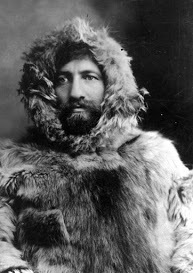 Finally on September 1st, 1909, Arctic explorer Frederick Cook became the first person in modern times to claim attainment of the North Pole when he cabled from the Shetland Islands after a 15-month trek back, alleging to have reached the Pole on April 21st, 1908. That day the Evening Mail headlined: "Dr. Cook Reaches North Pole," and the next day The New York Herald headlined "The North Pole is Discovered by Dr. Frederick A. Cook, Who Cables to the Herald an Exclusive Account of How He Set the American Flag on the World's Top." The news sent America and the rest of the world into a frenzy of media-fueled excitement hailing Cook as a hero.
Finally on September 1st, 1909, Arctic explorer Frederick Cook became the first person in modern times to claim attainment of the North Pole when he cabled from the Shetland Islands after a 15-month trek back, alleging to have reached the Pole on April 21st, 1908. That day the Evening Mail headlined: "Dr. Cook Reaches North Pole," and the next day The New York Herald headlined "The North Pole is Discovered by Dr. Frederick A. Cook, Who Cables to the Herald an Exclusive Account of How He Set the American Flag on the World's Top." The news sent America and the rest of the world into a frenzy of media-fueled excitement hailing Cook as a hero.
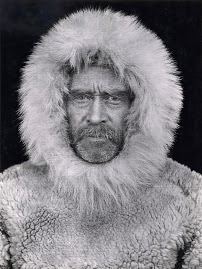 Meanwhile, another Arctic explorer, U.S Navy Admiral Robert Peary happened to be at that very moment traveling home from his own polar expedition. Just five days after Cook's cable, on September 6th, 1909, Peary cabled from Labrador that he too had recently "Nailed the American Flag to the Pole," on April 6th, 1909, a year after Cook's claim. When informed of Cook's news, Peary cabled that Cook's claim "should not be taken seriously," as he just stood atop the Pole and found no trace of Cook or anyone else having been there. On September 7th, The New York Herald headlined, "Robert E. Peary, After 23 Year Siege, Reaches North Pole," but to Peary's utter disappointment his claim to be first to the Pole was not widely accepted. Peary immediately sprang into action obtaining and cabling confessions from Cook's Eskimo guides making the Evening Telegram headline for September 8th, 1909, "Peary Quotes Eskimos as Saying Cook was Not Out of Sight of Land," and with this began a heated rivalry between two former friends and Arctic travel companions that would eventually end with both men and their polar attainment claims being completely discredited.
Meanwhile, another Arctic explorer, U.S Navy Admiral Robert Peary happened to be at that very moment traveling home from his own polar expedition. Just five days after Cook's cable, on September 6th, 1909, Peary cabled from Labrador that he too had recently "Nailed the American Flag to the Pole," on April 6th, 1909, a year after Cook's claim. When informed of Cook's news, Peary cabled that Cook's claim "should not be taken seriously," as he just stood atop the Pole and found no trace of Cook or anyone else having been there. On September 7th, The New York Herald headlined, "Robert E. Peary, After 23 Year Siege, Reaches North Pole," but to Peary's utter disappointment his claim to be first to the Pole was not widely accepted. Peary immediately sprang into action obtaining and cabling confessions from Cook's Eskimo guides making the Evening Telegram headline for September 8th, 1909, "Peary Quotes Eskimos as Saying Cook was Not Out of Sight of Land," and with this began a heated rivalry between two former friends and Arctic travel companions that would eventually end with both men and their polar attainment claims being completely discredited.
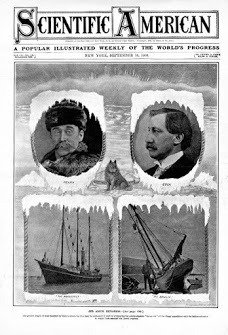 “The claimed attainment of the North Pole generated enormous controversy and acrimony. Both Cook and Peary boasted that they were the first to reach the pole. Cook’s North Polar Expedition, which dates from July 3, 1907 to September 21, 1909 began from Gloucester, Massachusetts, and was sponsored by John Bradley. Cook visited Etah in northwest Greenland and then proceeded north to Anoritoq. Here he became convinced that he could reach the North Pole. Subsequently he returned to Etah in order to prepare for the journey, and solicited assistance from Inuit. They advanced again to Anoritoq, and on February 19, 1908 set out for the North Pole. Cook’s route took him and his men via Smith Sound to Cape Sabine, to Flagler Bay, and then across Ellesmere Island to Bay Fiord. From there they proceeded to Eureka Sound, and established a camp at Cape Stallworthy, located at the northern extremity of Axel Heiberg Island where most of his party remained. Cook himself set out for the Pole with two Inuit, Ahwelah and Etukishook, two sledges and twenty-six dogs. He insisted that he reached the North Pole on April 21, 1908. Peary’s polar venture occurred between July 6, 1908 and September 21, 1909. It was sponsored by the Peary Arctic Club, and the party strived to reach the North Pole from Ellesmere Island. Peary’s ships, the Roosevelt and Erik, collected 22 Inuit men and 17 Inuit women in addition to 246 dogs in northwest Greenland. Winter quarters were at Cape Sheridan in northeast Ellesmere Island. After arriving there on September 5, 1908, Peary transferred stores to Cape Columbia, located on the north of the island, and the selected place from which the assault on the Pole was to be made. Peary’s polar advance commenced in February, 1909. Support parties led by Bartlett, Borup, Marvin, Macmillan and Godsell had the task of carrying provisions, establishing a trail, and providing igloos for Peary and Henson who were to lead the assault on the Pole. The support parties turned back. The last to do so was led by Bartlett who retreated on April 1, 1909 from latitude 87.47N. Peary, Henson and four Inuit continued their approach to the Pole, which they claimed to reach on April 6, 1909. A Cook/Peary controversy resulted. On September 2, 1909 Cook published his claim to have reached the Pole. Peary’s rival claim was submitted four days subsequently.” -Paul Simpson-Housley, “The Arctic, Enigmas and Myths” (120-1)
“The claimed attainment of the North Pole generated enormous controversy and acrimony. Both Cook and Peary boasted that they were the first to reach the pole. Cook’s North Polar Expedition, which dates from July 3, 1907 to September 21, 1909 began from Gloucester, Massachusetts, and was sponsored by John Bradley. Cook visited Etah in northwest Greenland and then proceeded north to Anoritoq. Here he became convinced that he could reach the North Pole. Subsequently he returned to Etah in order to prepare for the journey, and solicited assistance from Inuit. They advanced again to Anoritoq, and on February 19, 1908 set out for the North Pole. Cook’s route took him and his men via Smith Sound to Cape Sabine, to Flagler Bay, and then across Ellesmere Island to Bay Fiord. From there they proceeded to Eureka Sound, and established a camp at Cape Stallworthy, located at the northern extremity of Axel Heiberg Island where most of his party remained. Cook himself set out for the Pole with two Inuit, Ahwelah and Etukishook, two sledges and twenty-six dogs. He insisted that he reached the North Pole on April 21, 1908. Peary’s polar venture occurred between July 6, 1908 and September 21, 1909. It was sponsored by the Peary Arctic Club, and the party strived to reach the North Pole from Ellesmere Island. Peary’s ships, the Roosevelt and Erik, collected 22 Inuit men and 17 Inuit women in addition to 246 dogs in northwest Greenland. Winter quarters were at Cape Sheridan in northeast Ellesmere Island. After arriving there on September 5, 1908, Peary transferred stores to Cape Columbia, located on the north of the island, and the selected place from which the assault on the Pole was to be made. Peary’s polar advance commenced in February, 1909. Support parties led by Bartlett, Borup, Marvin, Macmillan and Godsell had the task of carrying provisions, establishing a trail, and providing igloos for Peary and Henson who were to lead the assault on the Pole. The support parties turned back. The last to do so was led by Bartlett who retreated on April 1, 1909 from latitude 87.47N. Peary, Henson and four Inuit continued their approach to the Pole, which they claimed to reach on April 6, 1909. A Cook/Peary controversy resulted. On September 2, 1909 Cook published his claim to have reached the Pole. Peary’s rival claim was submitted four days subsequently.” -Paul Simpson-Housley, “The Arctic, Enigmas and Myths” (120-1)
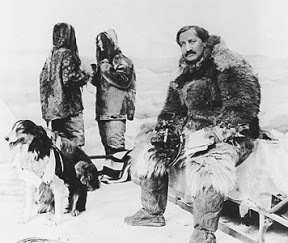 So after centuries of unsuccessful ill-fated attempts at the Pole, within the space of just 4 days, two American explorers claimed to be the first successes. Cook's journal description of his heroic arrival at the Pole reads more like a piece of poetic fiction than an actual experience, however, which has raised questions from skeptics. He wrote, “Constantly and carefully I watched my instruments in recording this final reach. Nearer and nearer they recorded our approach. Step by step my heart filled with a strange rapture of conquest. At last we step over colored fields of sparkle, climbing walls of purple and gold - finally, under skies of crystal blue, with flaming clouds, we touch the mark. The soul awakens to a definite triumph; there is sunrise within us, and all the world of night-darkened trouble fades. We are at the top of the world. The flag is flung to the frigid breezes of the North Pole. The first realization of actual victory, of reaching my lifetime’s goal, set my heart throbbing violently and my brain aglow. I felt the glory which the prophet feels in his vision, with which the poet thrills in his dream. I saw silver and crystal palaces, such as were never built by man, with turrets flaunting ‘pinions glorious, golden.’ The shifting mirages seemed like the ghosts of dead armies, magnified and transfigured, huge and spectral, moving along the horizon and bearing the wind-tossed phantoms of golden blood-stained banners. I was at a spot which was as near as possible, by usual methods of determination, five hundred and twenty miles from Svartevoeg, a spot toward which men hand striven for more than three centuries - a spot known as the North Pole, and where I stood first of white men.”
So after centuries of unsuccessful ill-fated attempts at the Pole, within the space of just 4 days, two American explorers claimed to be the first successes. Cook's journal description of his heroic arrival at the Pole reads more like a piece of poetic fiction than an actual experience, however, which has raised questions from skeptics. He wrote, “Constantly and carefully I watched my instruments in recording this final reach. Nearer and nearer they recorded our approach. Step by step my heart filled with a strange rapture of conquest. At last we step over colored fields of sparkle, climbing walls of purple and gold - finally, under skies of crystal blue, with flaming clouds, we touch the mark. The soul awakens to a definite triumph; there is sunrise within us, and all the world of night-darkened trouble fades. We are at the top of the world. The flag is flung to the frigid breezes of the North Pole. The first realization of actual victory, of reaching my lifetime’s goal, set my heart throbbing violently and my brain aglow. I felt the glory which the prophet feels in his vision, with which the poet thrills in his dream. I saw silver and crystal palaces, such as were never built by man, with turrets flaunting ‘pinions glorious, golden.’ The shifting mirages seemed like the ghosts of dead armies, magnified and transfigured, huge and spectral, moving along the horizon and bearing the wind-tossed phantoms of golden blood-stained banners. I was at a spot which was as near as possible, by usual methods of determination, five hundred and twenty miles from Svartevoeg, a spot toward which men hand striven for more than three centuries - a spot known as the North Pole, and where I stood first of white men.”
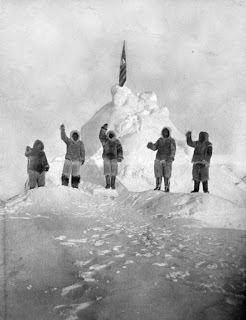 Peary's journal description of his arrival at the pole sounded more down to Earth and believable, but doubt would soon be cast on his claims as well. He wrote, “The Pole at last. The prize of three centuries. My dream and goal for twenty years. Mine at last. I cannot bring myself to realize it. It seems all so simple and commonplace. While we travelled, the sky cleared, and at the end of the journey, I was able to get a satisfactory series of observations at Columbia meridian midnight. These observations indicated that our position was then beyond the Pole … in a march of only a few hours, I had passed from the Western to the Eastern Hemisphere and had verified my position at the summit of the world. It was hard to realize that, on the first miles of this brief march, we had been travelling due North, while, on the last few miles of the same march, we had been travelling South, although we had all the time been travelling precisely in the same direction. In travelling the ice in these various directions, as I had done, I had allowed approximately ten miles for possible errors in my observations, and at some moment during these marches and countermarches, I had passed over or very near the point where the North and South and East and West blend into one.”
Peary's journal description of his arrival at the pole sounded more down to Earth and believable, but doubt would soon be cast on his claims as well. He wrote, “The Pole at last. The prize of three centuries. My dream and goal for twenty years. Mine at last. I cannot bring myself to realize it. It seems all so simple and commonplace. While we travelled, the sky cleared, and at the end of the journey, I was able to get a satisfactory series of observations at Columbia meridian midnight. These observations indicated that our position was then beyond the Pole … in a march of only a few hours, I had passed from the Western to the Eastern Hemisphere and had verified my position at the summit of the world. It was hard to realize that, on the first miles of this brief march, we had been travelling due North, while, on the last few miles of the same march, we had been travelling South, although we had all the time been travelling precisely in the same direction. In travelling the ice in these various directions, as I had done, I had allowed approximately ten miles for possible errors in my observations, and at some moment during these marches and countermarches, I had passed over or very near the point where the North and South and East and West blend into one.”
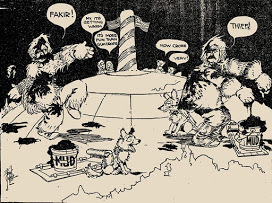 Thus, starting in September 1909 a huge public debate fueled by the newspapers raged over who was truly first to the North Pole with The New York Times showing unwavering support for Peary and The New York Herald doing the same for Cook. The demand of proof in the form of navigational records was issued and subsequently avoided by both sides. Cook never produced any detailed original navigation records to substantiate his polar claim, and on December 21, 1909, after examining what little evidence Cook did submit, a commission at the University of Copenhagen ruled there was no proof he had reached the Pole. Cook's Inuit guides would also testify in hand-written documents that during their final push for the Pole, they actually traveled South, not North, and never once did they travel out of sight of land! Meanwhile Peary outright refused to submit his records for the Copenhagen commission forcing them to also conclude a lack of proof for his claim.
Thus, starting in September 1909 a huge public debate fueled by the newspapers raged over who was truly first to the North Pole with The New York Times showing unwavering support for Peary and The New York Herald doing the same for Cook. The demand of proof in the form of navigational records was issued and subsequently avoided by both sides. Cook never produced any detailed original navigation records to substantiate his polar claim, and on December 21, 1909, after examining what little evidence Cook did submit, a commission at the University of Copenhagen ruled there was no proof he had reached the Pole. Cook's Inuit guides would also testify in hand-written documents that during their final push for the Pole, they actually traveled South, not North, and never once did they travel out of sight of land! Meanwhile Peary outright refused to submit his records for the Copenhagen commission forcing them to also conclude a lack of proof for his claim.
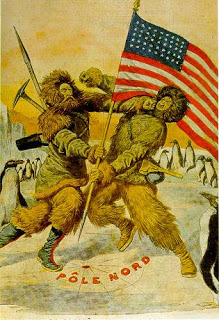 Cook later alleged to have kept copies of his sextant navigation data and in 1911 published some, only to be exposed as having an incorrect solar diameter during his calculations. The National Geographic Society held Peary's papers for decades, refusing researchers any access to them, and when finally independently examined, were also shown to be lacking. The released documentation listed only three solar observations without giving the date, no mention of which limb of the Sun Peary observed, and claimed the star Betelgeux present when it could not have been detected by a sextant during that time of year. Peary never produced records of compass readings, observed data for steering, for his longitudinal position at any time, and for the final stage in his expedition never took latitudinal or transversal readings, and had no accompanying colleagues trained in navigation who could confirm or deny his work.
Cook later alleged to have kept copies of his sextant navigation data and in 1911 published some, only to be exposed as having an incorrect solar diameter during his calculations. The National Geographic Society held Peary's papers for decades, refusing researchers any access to them, and when finally independently examined, were also shown to be lacking. The released documentation listed only three solar observations without giving the date, no mention of which limb of the Sun Peary observed, and claimed the star Betelgeux present when it could not have been detected by a sextant during that time of year. Peary never produced records of compass readings, observed data for steering, for his longitudinal position at any time, and for the final stage in his expedition never took latitudinal or transversal readings, and had no accompanying colleagues trained in navigation who could confirm or deny his work. Even though Cook's own navigational data was found to be flawed, he would still publicly criticize Peary's alleged sextant readings stating, “Mr. Peary’s polar claim rests upon the impossible observations of a sun at an altitude of less than 7 degrees above the horizon. The three armchair geographers, seldom out of reach of dusty book-shelves, passed upon these worthless observations. Not one out of one hundred thousand honest sextant experts would credit such an observation as that upon which Mr. Peary’s case rests - not even in home regions, where for centuries tables for corrections had been gathered.”
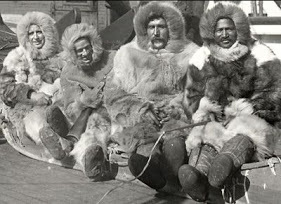 Not only were Cook and Peary's testimonies dubious and navigational records unsatisfactory, but the speeds claimed on their final pushes to the Pole were also incredulous. Cook recorded on the fourth and fifth days before his support party left, that even with full sledge loads, he was able to traverse 29 and 22 miles respectively those days, around double their usual distance covered, yet his Inuit guide Etukishook claimed that they remained in the same place for two nights. Polar researcher and author Randall Osczevski in his book "Frederick Cook and the Forgotten Pole," wrote that, "Cook had needed to invent additional mileage to make up the distance he said he had covered in reaching the Pole, and to bring him back to land on a reasonable date. Some of this padding is found in distances claimed for days when they did not travel, but some could have been created by simply changing the units. Since his mileage figures came from a pedometer, it is likely that he originally recorded these figures as statute miles. Pretending that they had really been nautical miles would add 15% to the distance."
Not only were Cook and Peary's testimonies dubious and navigational records unsatisfactory, but the speeds claimed on their final pushes to the Pole were also incredulous. Cook recorded on the fourth and fifth days before his support party left, that even with full sledge loads, he was able to traverse 29 and 22 miles respectively those days, around double their usual distance covered, yet his Inuit guide Etukishook claimed that they remained in the same place for two nights. Polar researcher and author Randall Osczevski in his book "Frederick Cook and the Forgotten Pole," wrote that, "Cook had needed to invent additional mileage to make up the distance he said he had covered in reaching the Pole, and to bring him back to land on a reasonable date. Some of this padding is found in distances claimed for days when they did not travel, but some could have been created by simply changing the units. Since his mileage figures came from a pedometer, it is likely that he originally recorded these figures as statute miles. Pretending that they had really been nautical miles would add 15% to the distance."
 Peary's supposed speeds during his final push to the Pole were even less believable than Cook's, allegedly averaging up to an implausible 71 miles per day. His last five marches while accompanied by experienced navigator Captain Bob Bartlett averaged no more than 13 miles per day. Once his last supporting party turned back and Captain Bartlett was ordered southward, Peary's alleged speeds immediately doubled for the next five marches. Then Peary claimed during the final eight days that his speed quadrupled from a base camp to the Pole and back, covering 296 miles, 198 of them in just 4 days, giving an average of 49 miles a day. This figure, however, is before factoring many more miles of admitted detours due to navigation errors, drift, avoiding pressure ridges and open water leads, which critics claim bring the figure closer to 71. No other explorer before or since has ever claimed such ridiculous speeds. Polar researcher and author Paul Simpson-Housley wrote in his "The Arctic Enigmas and Myths," that, "those records fail to confirm that Peary reached his goal, and such observations could certainly have been faked. Peary fails to provide a detailed account in his diary. Moreover, he should have presented a well-kept log of his final approach that included checks on compass variation and on his latitude and longitude made by providing altitudes of the sun, planets and stars at various locations. Polar pack-ice is difficult terrain to traverse. The ice-drift deviates from wind direction to the right by 28 degrees to 30 degrees in the northern hemisphere at a speed of 1/50 of the wind forcing it. Peary provided no wind speeds in either his diary or published reports. It is highly likely that he would be propelled to the left of his 70 degree meridian. His desire to reach the Pole was certainly in excess of his intent to produce records. In addition, Peary’s chronometer displayed an error of ten minutes and this would have influenced his heading."
Peary's supposed speeds during his final push to the Pole were even less believable than Cook's, allegedly averaging up to an implausible 71 miles per day. His last five marches while accompanied by experienced navigator Captain Bob Bartlett averaged no more than 13 miles per day. Once his last supporting party turned back and Captain Bartlett was ordered southward, Peary's alleged speeds immediately doubled for the next five marches. Then Peary claimed during the final eight days that his speed quadrupled from a base camp to the Pole and back, covering 296 miles, 198 of them in just 4 days, giving an average of 49 miles a day. This figure, however, is before factoring many more miles of admitted detours due to navigation errors, drift, avoiding pressure ridges and open water leads, which critics claim bring the figure closer to 71. No other explorer before or since has ever claimed such ridiculous speeds. Polar researcher and author Paul Simpson-Housley wrote in his "The Arctic Enigmas and Myths," that, "those records fail to confirm that Peary reached his goal, and such observations could certainly have been faked. Peary fails to provide a detailed account in his diary. Moreover, he should have presented a well-kept log of his final approach that included checks on compass variation and on his latitude and longitude made by providing altitudes of the sun, planets and stars at various locations. Polar pack-ice is difficult terrain to traverse. The ice-drift deviates from wind direction to the right by 28 degrees to 30 degrees in the northern hemisphere at a speed of 1/50 of the wind forcing it. Peary provided no wind speeds in either his diary or published reports. It is highly likely that he would be propelled to the left of his 70 degree meridian. His desire to reach the Pole was certainly in excess of his intent to produce records. In addition, Peary’s chronometer displayed an error of ten minutes and this would have influenced his heading."
 More doubt would eventually be cast on both Cook and Peary through public scrutiny. In 1906 Cook had previously claimed himself the first man to reach the summit of the tallest mountain in North America, Mount McKinley, only to be dethroned upon further investigation. It turned out the picture Cook provided as proof of his summit attainment was actually taken on a small outcrop on a ridge beside the Ruth Glacier, 19 miles away, and at only 5,338 feet high, nearly 15,000 feet lower than McKinley's true peak! Cook's sole companion during the 1906 climb, Ed Barrill, would also later sign an affidavit admitting that they had not reached the summit, including a map showing the location of what would become known as "Fake Peak," where Cook's picture was actually taken. Belmore Browne, an experienced mountaineer who assisted Cook in the weeks before his alleged summit achievement, claimed McKinley too expansive and treacherous to have allowed Cook such quick access in the time frame given. He would later call Cook untrustworthy, and state for the record that he, "knew that Dr. Cook had not climbed Mount McKinley the same way a New Yorker would know that no man could walk from the Brooklyn Bridge to Grant's tomb in ten minutes." Decades later Cook would also be indicted and eventually charged and found guilty of 14 counts of fraud for startup oil companies he promoted and was sentenced to 14 years, 9 months in prison.
More doubt would eventually be cast on both Cook and Peary through public scrutiny. In 1906 Cook had previously claimed himself the first man to reach the summit of the tallest mountain in North America, Mount McKinley, only to be dethroned upon further investigation. It turned out the picture Cook provided as proof of his summit attainment was actually taken on a small outcrop on a ridge beside the Ruth Glacier, 19 miles away, and at only 5,338 feet high, nearly 15,000 feet lower than McKinley's true peak! Cook's sole companion during the 1906 climb, Ed Barrill, would also later sign an affidavit admitting that they had not reached the summit, including a map showing the location of what would become known as "Fake Peak," where Cook's picture was actually taken. Belmore Browne, an experienced mountaineer who assisted Cook in the weeks before his alleged summit achievement, claimed McKinley too expansive and treacherous to have allowed Cook such quick access in the time frame given. He would later call Cook untrustworthy, and state for the record that he, "knew that Dr. Cook had not climbed Mount McKinley the same way a New Yorker would know that no man could walk from the Brooklyn Bridge to Grant's tomb in ten minutes." Decades later Cook would also be indicted and eventually charged and found guilty of 14 counts of fraud for startup oil companies he promoted and was sentenced to 14 years, 9 months in prison.
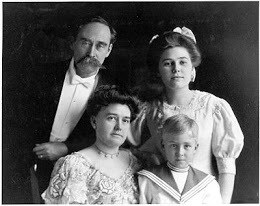 As for Peary, his obsession with the Pole caused him in the first 23 years of his marriage to spend only 3 with his wife and family, missing the birth and tragic death of his son. While in the Arctic, Peary cheated on his wife with a 14 year-old Inuit girl named Aleqasina who would eventually bear him two children named Kaala and Karree. During Peary's 7 long Arctic expeditions made between 1886 and 1909, a black man named Matthew Henson was technically more responsible for their successes than Peary himself. Henson took care of the other men, dogs and supplies, spoke the Inuit language, pulled and fixed the sledges, and Henson even drag Peary himself around during their final expedition since Peary had lost 8 toes to frostbite on their previous journey and could barely walk. Even still, Peary had secretly planned to leave Henson and the Inuit guides behind for the final stint so that he could claim the Pole solely for himself. His plan never came to fruition, however, and upon realizing he would have to share the fame, Peary immediately stopped speaking to Henson, the man who had engineered his success, saved his life on a previous expedition, and remained unwaveringly loyal to him for over two decades. As Peary had once written in a letter to his mother, "I must be the peer or superior of those about me to be comfortable." Historian Fergus Fleming called Peary, "the most unpleasant man in the annals of polar exploration," and polar researcher and author Beau Riffenburgh wrote that, "He was perhaps the most self-serving, paranoid, arrogant, and mean-spirited of all nineteenth-century explorers. He was suspicious of and hateful to those he considered rivals either in actual geographical discovery or as heroic figures. He was condescending and insensitive to his subordinates, and he was ingratiating and servile to those he felt could help his quest for personal glory."
As for Peary, his obsession with the Pole caused him in the first 23 years of his marriage to spend only 3 with his wife and family, missing the birth and tragic death of his son. While in the Arctic, Peary cheated on his wife with a 14 year-old Inuit girl named Aleqasina who would eventually bear him two children named Kaala and Karree. During Peary's 7 long Arctic expeditions made between 1886 and 1909, a black man named Matthew Henson was technically more responsible for their successes than Peary himself. Henson took care of the other men, dogs and supplies, spoke the Inuit language, pulled and fixed the sledges, and Henson even drag Peary himself around during their final expedition since Peary had lost 8 toes to frostbite on their previous journey and could barely walk. Even still, Peary had secretly planned to leave Henson and the Inuit guides behind for the final stint so that he could claim the Pole solely for himself. His plan never came to fruition, however, and upon realizing he would have to share the fame, Peary immediately stopped speaking to Henson, the man who had engineered his success, saved his life on a previous expedition, and remained unwaveringly loyal to him for over two decades. As Peary had once written in a letter to his mother, "I must be the peer or superior of those about me to be comfortable." Historian Fergus Fleming called Peary, "the most unpleasant man in the annals of polar exploration," and polar researcher and author Beau Riffenburgh wrote that, "He was perhaps the most self-serving, paranoid, arrogant, and mean-spirited of all nineteenth-century explorers. He was suspicious of and hateful to those he considered rivals either in actual geographical discovery or as heroic figures. He was condescending and insensitive to his subordinates, and he was ingratiating and servile to those he felt could help his quest for personal glory."
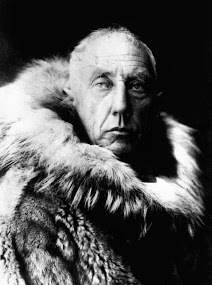 Another man preparing for a North Pole expedition in 1909 was accomplished Norwegian explorer Roald Amundsen. Upon hearing word of Cook and Peary's alleged successes, however, Amundsen decided to turn his attention towards the Antarctic and the South Pole instead. Unsure his patrons and crew would accept this change in plans, for the next two years Amundsen lied to everyone about his true destination, telling even his entire crew that they were traveling North to the Arctic Pole right up until their ship "The Fram" was departing from their final port of call, Madeira, when he let everyone know they would actually be going to the Antarctic in search of the South Pole. After some initial insubordination ultimately everyone went ahead with his drastic change of plans. Upon reaching Antarctica, Amundsen brought 5 men and 52 dogs with him for the final push to the Pole, and instead of bringing enough food along for everyone, Amundsen had his team kill and eat over half of the dogs used to carry them there. On December 14th, 1911 they would allegedly reach the Geographic South Pole to be confirmed by Robert Falcon Scott of the British Royal Navy who just happened to be in the Antarctic about to launch his own polar expedition. Just one month after Amundsen's alleged attainment of the South Pole, Scott's team already en route would arrive and confirm Amundsen's claim.
Another man preparing for a North Pole expedition in 1909 was accomplished Norwegian explorer Roald Amundsen. Upon hearing word of Cook and Peary's alleged successes, however, Amundsen decided to turn his attention towards the Antarctic and the South Pole instead. Unsure his patrons and crew would accept this change in plans, for the next two years Amundsen lied to everyone about his true destination, telling even his entire crew that they were traveling North to the Arctic Pole right up until their ship "The Fram" was departing from their final port of call, Madeira, when he let everyone know they would actually be going to the Antarctic in search of the South Pole. After some initial insubordination ultimately everyone went ahead with his drastic change of plans. Upon reaching Antarctica, Amundsen brought 5 men and 52 dogs with him for the final push to the Pole, and instead of bringing enough food along for everyone, Amundsen had his team kill and eat over half of the dogs used to carry them there. On December 14th, 1911 they would allegedly reach the Geographic South Pole to be confirmed by Robert Falcon Scott of the British Royal Navy who just happened to be in the Antarctic about to launch his own polar expedition. Just one month after Amundsen's alleged attainment of the South Pole, Scott's team already en route would arrive and confirm Amundsen's claim.
 The problem with Amundsen, Scott, and all subsequent South Polar claims, however, is the following: On the globe-Earth model, the Geographic South Pole is located at 90 degrees South latitude where all 360 degrees of longitude converge to one hypothetical point in the middle of an Antarctic continent. In reality though, the Antarctic is not a continent, but an encircling icy perimeter of unknown length, and on our planar Earth, lines of longitude only converge upon the North Pole center-point and project out straight southwards from there. One degree of latitude is approximately 68 miles and the Antarctic ice begins around 70 degrees South latitude (depending on access point), therefore no matter what meridian of longitude followed, after traveling South across the ice significantly far enough to the 90 degree mark (several hundred miles), the "Pole" has been achieved. In other words, the so-called "Geographic South Pole" is just an arbitrary point in the Antarctic, along any line of longitude, significantly far enough south, where all lines of longitude on the globe converge and become 0 degrees. For ease of transportation, supplies and navigation, all South Pole explorers just retrace their paths back to their boats, though if Earth was truly shaped like a ball, conceivably they should be able to simply continue a straight line path and come out the other side of Antarctica. No explorer on foot or by air has ever done such a South-North circumnavigation however because it is impossible, as the Earth is not a globe.
The problem with Amundsen, Scott, and all subsequent South Polar claims, however, is the following: On the globe-Earth model, the Geographic South Pole is located at 90 degrees South latitude where all 360 degrees of longitude converge to one hypothetical point in the middle of an Antarctic continent. In reality though, the Antarctic is not a continent, but an encircling icy perimeter of unknown length, and on our planar Earth, lines of longitude only converge upon the North Pole center-point and project out straight southwards from there. One degree of latitude is approximately 68 miles and the Antarctic ice begins around 70 degrees South latitude (depending on access point), therefore no matter what meridian of longitude followed, after traveling South across the ice significantly far enough to the 90 degree mark (several hundred miles), the "Pole" has been achieved. In other words, the so-called "Geographic South Pole" is just an arbitrary point in the Antarctic, along any line of longitude, significantly far enough south, where all lines of longitude on the globe converge and become 0 degrees. For ease of transportation, supplies and navigation, all South Pole explorers just retrace their paths back to their boats, though if Earth was truly shaped like a ball, conceivably they should be able to simply continue a straight line path and come out the other side of Antarctica. No explorer on foot or by air has ever done such a South-North circumnavigation however because it is impossible, as the Earth is not a globe.
 For posterity Roald Amundsen would be credited not only with being first to the Geographic South Pole, but also first to winter in the Antarctic, and then subsequent expeditions to the Arctic would claim for him titles of first through the Northwest Passage, first to cross and first to circumnavigate the Arctic Ocean, first to the Ice Pole (the Arctic Ocean point farthest from land-masses), and after widespread distrust and dispute of Cook/Peary's claims, a 1926 expedition would see Amundsen reclaim being first to the Geographic North Pole as well!
For posterity Roald Amundsen would be credited not only with being first to the Geographic South Pole, but also first to winter in the Antarctic, and then subsequent expeditions to the Arctic would claim for him titles of first through the Northwest Passage, first to cross and first to circumnavigate the Arctic Ocean, first to the Ice Pole (the Arctic Ocean point farthest from land-masses), and after widespread distrust and dispute of Cook/Peary's claims, a 1926 expedition would see Amundsen reclaim being first to the Geographic North Pole as well! Reminiscent of the 1909 Cook/Peary controversy, however, a similar media-fueled heated debate raged in 1926 as U.S. Admiral Richard Byrd allegedly reached the Pole by plane just 3 days before Roald Amundsen did by dirigible! Both Byrd and Amundsen were aware of each other's concurrent expeditions, and due to recent advances in aviation technology, both decided to reach the Pole via air rather than land/sea as previous explorers attempted. Similar to Scott's follow-up confirmation of Amundsen's South Pole claim, the plan was for Admiral Byrd to fly over first and dump a load of hundreds of large American flags directly at the Pole, which Amundsen would then find and confirm a few days later during his own polar flight.
 So on May 9th, 1926 Byrd and his co-pilot departed in their Fokker tri-motor airplane, "The Josephine Ford," from the Norwegian island Spitzbergen and attempted to fly over the Pole. Just 15 hours and 57 minutes later, including an alleged 13 minutes of circling the Pole, Byrd landed back at Spitzbergen claiming to have reached the Pole and traveled a distance of 1,535 miles. Upon return to the United States, Byrd became a national hero, promoted to the rank of Commander, and was awarded a Presidential Medal of Honor at the White House. Roald Amundsen's airship "the Norge," allegedly floated over the Pole 3 days later on May 12th, but was unable to confirm Byrd's attainment, because Byrd never ended up dropping his cargo of U.S. flags over the Pole, nor provide a public explanation of why.
So on May 9th, 1926 Byrd and his co-pilot departed in their Fokker tri-motor airplane, "The Josephine Ford," from the Norwegian island Spitzbergen and attempted to fly over the Pole. Just 15 hours and 57 minutes later, including an alleged 13 minutes of circling the Pole, Byrd landed back at Spitzbergen claiming to have reached the Pole and traveled a distance of 1,535 miles. Upon return to the United States, Byrd became a national hero, promoted to the rank of Commander, and was awarded a Presidential Medal of Honor at the White House. Roald Amundsen's airship "the Norge," allegedly floated over the Pole 3 days later on May 12th, but was unable to confirm Byrd's attainment, because Byrd never ended up dropping his cargo of U.S. flags over the Pole, nor provide a public explanation of why.
 At first Byrd's polar claim was widely accepted and Amundsen reduced to second-fiddle, but after new evidence came to light, and further investigations made clear, Byrd never dropped the flags because he never actually reached the Pole. The first public skepticism of Byrd began a year after his death in 1958 when Byrd's colleague, personal pilot during his South Pole flight, and helper in Spitzbergen for the North Pole flight, Bernt Balchen, published his book "Come North With Me," which questioned the feasibility of Byrd's 1926 polar claim. Essentially, Byrd's sextant-locked 61 knot mean-speed for the first 6 1/4 hours of the flight, per his own records in a recorded 7:07 GCT sextant shot, required that to reach the Pole at the reported time he would need to have suddenly after taking the reading jumped his average speed over double from 61 to an implausible 148 knots in order to cover the final 284 miles in the alleged time allotted. In addition, once supposedly reaching the Pole and circling around it for 13 minutes, his written calculations contradictorily still claimed constant 85mph straight-line speed northward. Apologists and defenders of Byrd dismissed Balchen's objections insisting prevailing winds may have helped him along, until in 1960 Gosta Liljquist, Professor of Meteorology at University of Uppsala, examined the meteorological records and concluded there were absolutely no polar winds strong enough on May 9th, 1926 to propel Byrd so swiftly to his destination.
At first Byrd's polar claim was widely accepted and Amundsen reduced to second-fiddle, but after new evidence came to light, and further investigations made clear, Byrd never dropped the flags because he never actually reached the Pole. The first public skepticism of Byrd began a year after his death in 1958 when Byrd's colleague, personal pilot during his South Pole flight, and helper in Spitzbergen for the North Pole flight, Bernt Balchen, published his book "Come North With Me," which questioned the feasibility of Byrd's 1926 polar claim. Essentially, Byrd's sextant-locked 61 knot mean-speed for the first 6 1/4 hours of the flight, per his own records in a recorded 7:07 GCT sextant shot, required that to reach the Pole at the reported time he would need to have suddenly after taking the reading jumped his average speed over double from 61 to an implausible 148 knots in order to cover the final 284 miles in the alleged time allotted. In addition, once supposedly reaching the Pole and circling around it for 13 minutes, his written calculations contradictorily still claimed constant 85mph straight-line speed northward. Apologists and defenders of Byrd dismissed Balchen's objections insisting prevailing winds may have helped him along, until in 1960 Gosta Liljquist, Professor of Meteorology at University of Uppsala, examined the meteorological records and concluded there were absolutely no polar winds strong enough on May 9th, 1926 to propel Byrd so swiftly to his destination.
 Another exposure of Byrd's hoax surfaced in 1971 with Richard Montague's book "Oceans, Poles, and Airmen," in which he interviewed Bernt Balchen, who claimed that Floyd Bennet, Byrd's North Pole co-pilot had confessed to him before his death that the Josephine Ford had actually developed an oil leak early in the flight, lost a motor several hundred miles from the Pole, and subsequently turned back circling out of sight of land without making an effort to reach the Pole.
Another exposure of Byrd's hoax surfaced in 1971 with Richard Montague's book "Oceans, Poles, and Airmen," in which he interviewed Bernt Balchen, who claimed that Floyd Bennet, Byrd's North Pole co-pilot had confessed to him before his death that the Josephine Ford had actually developed an oil leak early in the flight, lost a motor several hundred miles from the Pole, and subsequently turned back circling out of sight of land without making an effort to reach the Pole. The final nail in Byrd's coffin came with the 1996 release of his personal diary and papers recording the May 9th, 1926 flight. His official sextant reading typewritten in his June 22nd report to the National Geographic Society taken at 7:07:10 GCT claimed a solar altitude of 18°18'18". In his diary however, an erased but still legible recording shows his apparent observed solar altitude at 7:07:10 to have been 19°25'30". Not only this, but a scrap piece of paper found in Byrd's diary, also in his hand-writing, shows a third scribbled solar altitude for 7:07:10 as being 18°19'18". This intermediate scrap paper calculation between the diary recording and official typewritten report shows evidence of gradual doctoring of the raw data in an effort to fudge a believable figure. In addition, Byrd's official recorded sextant data was overly precise far beyond the capabilities of his or any other sextant available at the time. Dead-reckoning latitudes were recorded with 1000 times better precision than physically possible, again pointing towards an attempt to over-compensate the perceived accuracy of his inaccurate fudged data.
 To summarize, Byrd's 1926 primary record includes several mysterious erasures, back and forth diary entries, confirmed fabrications and contradictions including two takeoff times, three Pole-arrival times and 7:07 sextant altitudes, and four different speeds! In documents including his diary from the time we see intermediary steps of his forging calculations for the most believable and accurate times, air speeds, distances, and solar altitudes. He never dropped the cargo of U.S. flags as intended and could not have attained the Pole at the speeds recorded.
To summarize, Byrd's 1926 primary record includes several mysterious erasures, back and forth diary entries, confirmed fabrications and contradictions including two takeoff times, three Pole-arrival times and 7:07 sextant altitudes, and four different speeds! In documents including his diary from the time we see intermediary steps of his forging calculations for the most believable and accurate times, air speeds, distances, and solar altitudes. He never dropped the cargo of U.S. flags as intended and could not have attained the Pole at the speeds recorded.
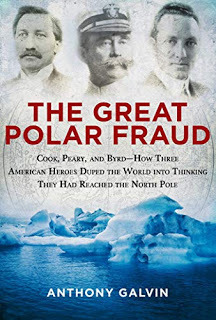 "In brief: Byrd's diary and his typescript describe two quite different trips. Indeed, there are actually FOUR distinct trips, because the diary has three separate and contradictory sections: the sextant-observations are for a 70mph celestially-navigated trip; the radioed distances are for an 80mph dr trip; while the last-minute dr data are for an 85mph trip. But the later neat typescript claims that the mean northward speed was over 90mph. The typescript trip does not agree with ANY of the three disparate diary trips. If you are caught keeping two sets of fiscal books, you go to jail. Not even the wildest defense lawyer would try alibiing the accused by treating the differences between the two documents as exculpatory or mysterious when the whole point of the indictment IS the discrepancies. Question: did any other explorer in history leave us manuscript astronomical observations for position which grossly to his disadvantage invariably differed from his published observations?" -Dennis Rawlins, "Amundsen: Cheated and Uncheated"
"In brief: Byrd's diary and his typescript describe two quite different trips. Indeed, there are actually FOUR distinct trips, because the diary has three separate and contradictory sections: the sextant-observations are for a 70mph celestially-navigated trip; the radioed distances are for an 80mph dr trip; while the last-minute dr data are for an 85mph trip. But the later neat typescript claims that the mean northward speed was over 90mph. The typescript trip does not agree with ANY of the three disparate diary trips. If you are caught keeping two sets of fiscal books, you go to jail. Not even the wildest defense lawyer would try alibiing the accused by treating the differences between the two documents as exculpatory or mysterious when the whole point of the indictment IS the discrepancies. Question: did any other explorer in history leave us manuscript astronomical observations for position which grossly to his disadvantage invariably differed from his published observations?" -Dennis Rawlins, "Amundsen: Cheated and Uncheated" Since Cook, Peary and Byrd's North Pole claims have all been found fraudulent, it is now generally accepted that Roald Amundsen's dirigible flight of May 12th, 1926 did cross the Pole, and he is credited with being the first explorer to both the South and North Poles. Even Wikipedia states that, "three prior expeditions led by Frederick Cook (1908, land), Robert Peary (1909, land) and Richard E. Byrd (1926, aerial) – were once also accepted as having reached the Pole. However, in each case later analysis of expedition data has cast doubt upon the accuracy of their claims." This is also Irish journalist Anthony Galvin's conclusion in his book, “The Great Polar Fraud: Cook, Peary and Byrd - How Three American Heroes Duped the World into Thinking They Had Reached the North Pole.”
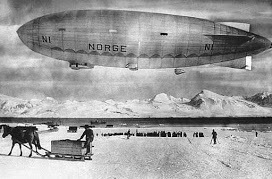 Ever since Amundsen's dirigible "the Norge" allegedly successfully floated over the Pole, many more explorers have also continued the legacy. Norge designer and pilot Umberto Nobile along with several scientists and crew allegedly crossed the Pole a second time on May 24th, 1928 in the airship "Italia," which crashed before returning killing half the people onboard. In May 1937 the Soviet government established the world's first North Pole ice station allegedly just 13 miles from the Pole. Interestingly enough, this station was found by ice-breakers just 9 months later off the Eastern coast of Greenland, over 1700 miles away! This was explained as being caused by swift "ice drifts," which radically displaced them. In May 1945 David Cecil McKinley of the Royal Air Force claimed to flyover both the Geographic and North Magnetic Poles. The Soviet "Sever 2" expedition in May 1948 claimed to set foot on the Pole, and in May 1949 Soviets Vitali Volovich and Andrei Medvedev claimed being first to parachute to the Pole. In May 1952 U.S. Air Force Lieutenants Joseph Fletcher and William Benedict claimed the first aerial landing at the Pole. The U.S. Navy submarine U.S.S. Nautilus allegedly crossed the Pole in August 1958, and in March 1959 the U.S.S. Skate claimed first to surface at the Pole, breaking through the ice above it. An April 1969 British Trans-Arctic expedition claimed first to reach the North Pole by foot, August 1977 the Soviet icebreaker Arktika claimed first surface ship to reach the Pole, and on the list of alleged polar firsts continue from first by dogsled to first by motorcycle! In 1985, for a particularly interesting media-hyped "first," Sir Edmund Hillary, the first man to stand on the summit of Mount Everest, and Neil Armstrong, the alleged first man to stand on the Moon, claimed to land a small twin-engine ski plane and stand together at the North Pole.
Ever since Amundsen's dirigible "the Norge" allegedly successfully floated over the Pole, many more explorers have also continued the legacy. Norge designer and pilot Umberto Nobile along with several scientists and crew allegedly crossed the Pole a second time on May 24th, 1928 in the airship "Italia," which crashed before returning killing half the people onboard. In May 1937 the Soviet government established the world's first North Pole ice station allegedly just 13 miles from the Pole. Interestingly enough, this station was found by ice-breakers just 9 months later off the Eastern coast of Greenland, over 1700 miles away! This was explained as being caused by swift "ice drifts," which radically displaced them. In May 1945 David Cecil McKinley of the Royal Air Force claimed to flyover both the Geographic and North Magnetic Poles. The Soviet "Sever 2" expedition in May 1948 claimed to set foot on the Pole, and in May 1949 Soviets Vitali Volovich and Andrei Medvedev claimed being first to parachute to the Pole. In May 1952 U.S. Air Force Lieutenants Joseph Fletcher and William Benedict claimed the first aerial landing at the Pole. The U.S. Navy submarine U.S.S. Nautilus allegedly crossed the Pole in August 1958, and in March 1959 the U.S.S. Skate claimed first to surface at the Pole, breaking through the ice above it. An April 1969 British Trans-Arctic expedition claimed first to reach the North Pole by foot, August 1977 the Soviet icebreaker Arktika claimed first surface ship to reach the Pole, and on the list of alleged polar firsts continue from first by dogsled to first by motorcycle! In 1985, for a particularly interesting media-hyped "first," Sir Edmund Hillary, the first man to stand on the summit of Mount Everest, and Neil Armstrong, the alleged first man to stand on the Moon, claimed to land a small twin-engine ski plane and stand together at the North Pole.
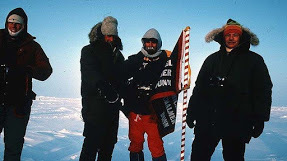 As is abundantly clear to anyone who has objectively studied the NASA Apollo missions, Freemason Neil Armstrong most certainly did NOT land on the Moon, so it is fair and wise to be skeptical of whether he and his royally knighted colleague "Sir" Edmund Hillary actually stood foot on the Geographic Pole as well. As for the Magnetic Poles, the North was allegedly discovered by James Clark Ross in 1831 at the Boothia Peninsula, named after his father's patron "Sir" Felix Booth. This peninsula located at 70 degrees North latitude, however, strangely placed the Magnetic Pole well over a thousand miles from the Geographic Pole. Roald Amundsen during his 1903 Arctic expedition was also credited with discovering a new position of the Magnetic North Pole just 30 miles north from where Ross claimed. It was later in 1947 allegedly found again by Canadian government scientists Paul Serson and Jack Clark, of the Dominion Astrophysical Observatory, who claimed the Pole had moved near Prince of Wales Island at 72 degrees North latitude. Since then the North Magnetic Pole has continued to be "discovered" time and again at random places in the Arctic following no discernable pattern. Likewise the South Magnetic Pole was first allegedly discovered by "Sir" Ernest Shackleton during his 1909 expedition, and has ever since been found randomly moving all over the Antarctic.
As is abundantly clear to anyone who has objectively studied the NASA Apollo missions, Freemason Neil Armstrong most certainly did NOT land on the Moon, so it is fair and wise to be skeptical of whether he and his royally knighted colleague "Sir" Edmund Hillary actually stood foot on the Geographic Pole as well. As for the Magnetic Poles, the North was allegedly discovered by James Clark Ross in 1831 at the Boothia Peninsula, named after his father's patron "Sir" Felix Booth. This peninsula located at 70 degrees North latitude, however, strangely placed the Magnetic Pole well over a thousand miles from the Geographic Pole. Roald Amundsen during his 1903 Arctic expedition was also credited with discovering a new position of the Magnetic North Pole just 30 miles north from where Ross claimed. It was later in 1947 allegedly found again by Canadian government scientists Paul Serson and Jack Clark, of the Dominion Astrophysical Observatory, who claimed the Pole had moved near Prince of Wales Island at 72 degrees North latitude. Since then the North Magnetic Pole has continued to be "discovered" time and again at random places in the Arctic following no discernable pattern. Likewise the South Magnetic Pole was first allegedly discovered by "Sir" Ernest Shackleton during his 1909 expedition, and has ever since been found randomly moving all over the Antarctic. The idea of constantly randomly moving Magnetic Poles divorced from their Geographic counter-parts makes it conveniently impossible to independently confirm or deny polar claims by compass. In other words, since the invention of the video camera, any claim to have found the North or South Magnetic Pole, can and should be easily proven. By holding a compass and walking in a circle around the North Pole, the compass should always point directly towards it, and by walking in a circle around the South Pole, the compass should always point 180 degrees away in the opposite direction. To this day, however, no such simple experiment has been performed to prove to the public that these are truly magnetic poles at all.
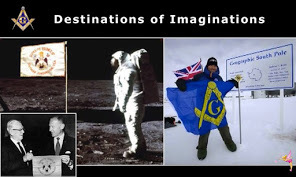 Similarly, there are no videos from the Geographic Poles that provide the public with any concrete evidence that they are anywhere but some indistinct undisclosed snowy tundra. North Pole documentaries always show some man with an icicle mustache and a Garmin counting up their GPS latitude until reaching 90 degrees. There are never stellar readings made showing Polaris exactly 90 degrees above. There is no footage of the 6 months of constant day and 6 months of constant night supposed to exist at the Pole. GPS, the "Global" Positioning System, is based on a non-existent "globe" and created by the U.S. Military, so why should we trust that a GPS 90 degree north reading is truly the North Pole?
Similarly, there are no videos from the Geographic Poles that provide the public with any concrete evidence that they are anywhere but some indistinct undisclosed snowy tundra. North Pole documentaries always show some man with an icicle mustache and a Garmin counting up their GPS latitude until reaching 90 degrees. There are never stellar readings made showing Polaris exactly 90 degrees above. There is no footage of the 6 months of constant day and 6 months of constant night supposed to exist at the Pole. GPS, the "Global" Positioning System, is based on a non-existent "globe" and created by the U.S. Military, so why should we trust that a GPS 90 degree north reading is truly the North Pole? Why are the annals of Polar exploration so abundant with frauds and hoaxes? Why should we accept all these more recent Polar claims as being legitimate when the original discoveries and discoverers continue being exposed as false and liars? Why is there such an inordinate number of royal knights and Freemasons involved in Polar exploration? Admiral Byrd himself was a high-ranking Freemason from Federal Lodge No. 1 in Washington D.C. and financed by none other than fellow 33rd degree Freemason and Illuminati bloodline elite John D. Rockefeller. Roald Amundsen even had Masonic lodge No. 6-48 in Sacramento, California named after him.
If these explorers truly reached the North Pole, then where is the magnetic mountain, encircling whirlpool, four directional rivers, and surrounding inhabited islands mentioned by Adam of Bremen, Paul the Deacon, Gerald of Wales, Guido Guinizelli, Nicholas de Lynn, Jacobus Cnoyen, Gerard Mercator, John Dee, the Hindus, Buddhists, Jains, Shinto, Taoists, Jews, Christians, Muslims, the Norse, the Egyptians, the Persians and literally every single ancient culture on Earth? Are these all to be discounted as completely false stories with no factual impetus? And if the polar magnetic mountain truly is just fanciful mythology and non-sense, how do we account for this same ("false") concept originating and flourishing independently in nearly every ancient culture worldwide?


Buy Flatlantis Now in Paperback, eBook, or ePub

November 17, 2020
Early Polar Maps and Exploration

The ancient world's mythologies regarding a magnetic mountain, four directional rivers, and other more fantastical features at the North Pole are shockingly consistent, but what did the earliest known explorers, historians and cartographers have to say about the subject? Pytheas, the earliest recorded explorer of the North Pole in the 4th century BC, claimed to discover an island he called "Thule," the farthest northern land, and gave an account sounding straight out of ancient mythology. In his lost book entitled "On the Ocean," Pytheas wrote, “the island was more than forty thousand stadia, and in this region there was no longer either land properly so-called, or sea, or air, but a kind of substance concreted from all these elements, resembling a sea-lungs - a thing which, the earth, the sea, and all the elements are held in suspension; and this is a sort of bond to hold all together, which you can neither walk nor sail upon.” Pytheas claimed upon reaching the northern-most point accessible, that land, air, and water somehow became like one substance similar to a jelly-fish and was completely impassable.
Little remains of Pytheas' original account, but second-hand sources like Strabo inform us regarding the inhabitants of the surrounding northern islands, “he says that, of the animals and domesticated fruits, there is an utter dearth of some and scarcity of others, and that the people live on millet and other herbs, and on fruits and roots; and where there are grain and honey, the people get their beverage also, from them. As for the grain, he says - since they have no pure sunshine - they pound it out in large storehouses, after first gathering in the ears thither; for the threshing floors become useless because of this lack of sunshine and because of the rains.”
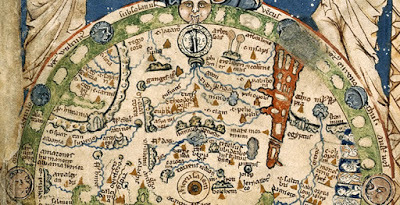
Pliny the Elder also wrote of Pytheas’ journey in his Naturalis Historia (IV.16) stating that, “on summer days the sun approached nearer to the top of the world; owing to a natural circuit of light the underlying parts of the earth have continuous days for six months at a time, and continuous nights when the sun has withdrawn in the opposite direction towards winter. Pytheas of Mareilles writes that this occurs in the island of Thule, 6 days voyage north from Britain. Pytheas states that north of Britain the tides rise 80 cubits. The most remote of all is Thule, in which we have pointed out there are no nights at midsummer when the sun is passing through the sign of the Crab, and on the other hand no days at midwinter; indeed some writers think this is the case for periods of six months at a time without a break. One day’s sail from Thule is the frozen ocean called by some the Cronian Sea.”
“The earliest voyage to the north is that claimed for Pytheus, the distinguished Phenician astronomer and geographer of Marseilles, who flourished 320 B.C. His works were extant in the fifth century, but are no longer found. Pliny and Eratosthenes gave full credit to his narrations, though Strabo shows great hostility to Pytheus, whose accounts he refused to receive, saying that he made ‘use of his acquaintance with astronomy and mathematics to fabricate his false narrative.’ Pliny, however, with more reason, thought that he employed his knowledge in practical exploration. The latest editor of Strabo does not share in his author’s doubt. According to Pliny and others, Pytheus sailed through the Straits of Gibraltar, making his way north to the British isles, whither it was the custom of his countrymen to resort, and, after traveling over England on foot, proceeded northward to a place called ‘Thule,’ six days’ sail from the northern part of Britain.” -Benjamin Franklin DeCosta, "Inventio Fortunata, Arctic Exploration With An Account of Nicholas of Lynn" (4)
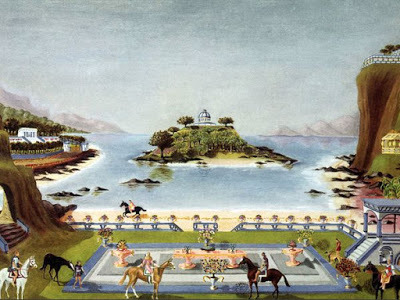
Even before the 4th century BC, similar claims were made by ancient Greek and Roman poets and historians like Pindar, Herodotus, Hesoid, Homer, (then later Virgil and Cicero) regarding "Hyperborea" and the "Hyperboreans," meaning the place/people "beyond the north wind." They said the people of Hyperborea were giants who lived for over a thousand years and enjoyed lives of perfect happiness. In another lost book written in the 4th century BC, Hecataeus of Abdera collated all the known stories written about the Hyperboreans. Diodorus Siculus references this lost work stating that, "In the regions beyond the land of the Celts there lies in the ocean an island no smaller than Sicily. This island, the account continues, is situated in the north and is inhabited by the Hyperboreans, who are called by that name because their home is beyond the point whence the north wind (Boreas) blows; and the island is both fertile and productive of every crop, and has a temperate climate."
 The classical Greek poet Pindar wrote that, "Never the muse is absent from their ways: lyres clash and flutes cry and everywhere maiden choruses whirling. Neither disease nor bitter old age is mixed in their sacred blood; far from labor and battle they live." And reminiscent of Pytheas' strange account Pindar stated that, "neither by ship nor on foot would you find the marvellous road to the assembly of the Hyperboreans."
The classical Greek poet Pindar wrote that, "Never the muse is absent from their ways: lyres clash and flutes cry and everywhere maiden choruses whirling. Neither disease nor bitter old age is mixed in their sacred blood; far from labor and battle they live." And reminiscent of Pytheas' strange account Pindar stated that, "neither by ship nor on foot would you find the marvellous road to the assembly of the Hyperboreans."Similar to Thule and Hyperborea, the Celts also had their northern terrestrial paradise known as "Avalon." St. Brandan, son of Finhlogho, a famous saint of the Irish church, who died in 576 AD, was allegedly the first to reach this land during a sea voyage to the North. Similar to other ancient accounts, St. Brandan mentioned a fountain with four directional streams, and claimed there were "magnificent castles and castle halls lighted with self-luminous stones and adorned with all manner of precious jewels, surpassing decription."
 In 1035 AD Archbishop Adalbert, the vicar of Scandinavia, sent a team of Frisian nobles to explore the northern polar region after which Adam of Bremen recorded their experiences in the book, "Gesta Hammaburgensis Ecclesiae Pontificum." Similar to accounts of the Hyperboreans, the Frisian explorers claimed to reach an island where they encountered giant human beings living in caves and underground hollows. The giants' domiciles were adorned in gold and precious metals which some of the Frisians stupidly attempted to steal and were swiftly chased back to their boats, minus one of their comrades caught by a giant who "in a twinkling tore him to pieces before their eyes."
In 1035 AD Archbishop Adalbert, the vicar of Scandinavia, sent a team of Frisian nobles to explore the northern polar region after which Adam of Bremen recorded their experiences in the book, "Gesta Hammaburgensis Ecclesiae Pontificum." Similar to accounts of the Hyperboreans, the Frisian explorers claimed to reach an island where they encountered giant human beings living in caves and underground hollows. The giants' domiciles were adorned in gold and precious metals which some of the Frisians stupidly attempted to steal and were swiftly chased back to their boats, minus one of their comrades caught by a giant who "in a twinkling tore him to pieces before their eyes." They never reached the North Pole or a magnetic mountain, but did encounter an incredible feature long-alleged to surround them. Ancient Norse legend states that a gigantic violent maelstrom (whirlpool) known as "Hvergelmir" or "the World's Well," surrounds the polar mountain and via four, six-hour daily cycles of pushing and pulling through subterranian channels, cause the rising and falling of tides on Earth. Adam of Bremen recounts the Frisian explorer's deadly encounter with this "abysmal chasm," as such: "of a sudden they fell into that numbing ocean’s dark mist which could hardly be penetrated with the eyes. And behold, the current of the fluctuating ocean whirled back to its mysterious fountainhead and with most furious impetuosity drew the unhappy sailors, who in their despair now thought only of death, on to chaos; this they say is the ‘abysmal chasm’ - that deep in which report has it that all the back flow of the sea, which appears to decrease, is absorbed and in turn revomited, as the mounting fluctuation is usually described. As the partners were imploring the mercy of God to receive their souls, the backward thrust of the sea carried away some of their ships, but its forward ejection threw the rest far behind the others. Freed thus by the timely help of God from the instant peril they had had before their eyes, they seconded the flood by rowing with all their might."
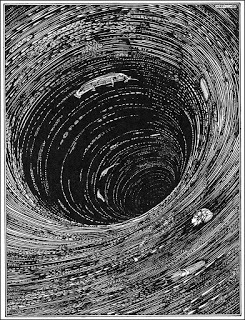 Besides the Norse legends of Hvergelmir, historical records of this "World Well" can be found as early as the 8th century AD when Paulus Diaconus or "Paul the Deacon," Benedictine monk, scribe and historian of the Lombards wrote in his Historia Langobardorum that, "not far from the shore, where the ocean extends without bounds, is that very deep abyss of waters which we commonly call the ocean's navel. It is said twice a day to suck the waves into itself, and to spew them out again; as is proved to happen along all these coasts, where the waves rush in and go back again with fearful rapidity. By the whirlpool of which we have spoken it is asserted that ships are often drawn in with such rapidity that they seem to resemble the flight of arrows through the air; and sometimes they are lost in the gulf with a very frightful destruction. Often just as they are about to go under, they are brought back again by a sudden shock of the waves, and they are sent out again thence with the same rapidity with which they were drawn in."
Besides the Norse legends of Hvergelmir, historical records of this "World Well" can be found as early as the 8th century AD when Paulus Diaconus or "Paul the Deacon," Benedictine monk, scribe and historian of the Lombards wrote in his Historia Langobardorum that, "not far from the shore, where the ocean extends without bounds, is that very deep abyss of waters which we commonly call the ocean's navel. It is said twice a day to suck the waves into itself, and to spew them out again; as is proved to happen along all these coasts, where the waves rush in and go back again with fearful rapidity. By the whirlpool of which we have spoken it is asserted that ships are often drawn in with such rapidity that they seem to resemble the flight of arrows through the air; and sometimes they are lost in the gulf with a very frightful destruction. Often just as they are about to go under, they are brought back again by a sudden shock of the waves, and they are sent out again thence with the same rapidity with which they were drawn in."Giraldus Cambrensis or "Gerald of Wales," archdeacon of Brecon, historian, and royal clerk to King Henry II, wrote in his 1188 work "Topographia Hibernica" that, "Not far from the islands, towards the north, there is an astonishing whirlpool in the sea, towards which there is a set current of the waves from all quarters, until, pouring themselves into nature’s secret recesses, they are swallowed up, as it were, in the abyss. Should a vessel chance to pass in that direction, it is caught and drawn along by the force of the waves, and sucked by the vortex without chance of escape. There are four of these whirlpools in the ocean, described by philosophers as existing in the four different quarters of the world; whence it has been conjectured that the currents of the sea, as well as the winds, are regulated, by fixed principles."
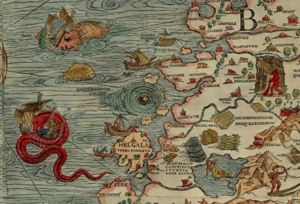
The whirlpool was also mentioned in another late 12th century work "Historia Norwegiae," where the author, an anonymous Norwegian monk gives a particularly detailed description, stating: "The greatest of all whirlpools is to be found there, which engulfs the strongest ships, sucking them in at ebb tide and spewing out their fragments with a belch at flood tide ... There is a very deep abyss in the earth itself and alongside it are open-mouthed caverns containing winds which are said to be brought forth by the breathing of the water, and these are the breath of gales. Indeed, by their breathing these winds draw to them the waters of the sea through hidden passages in the earth; they shut them up in the vaults of the abyss, and then by the same force drive them out again, causing sea-surges, spates and the whirling of waterspouts. Earthquakes also occur and various discharges of vapour and conflagration, for when the winds’ breath, held in the cheeks of earth, presses to burst out, it shakes the foundation of the world with a dreadful roaring and forces it to tremble. So when the winds’ breath contends with fire in the earth’s interior, then even in mid-ocean the depths are fissured and smoky exhalations and sulphurous flames are seen to emerge."
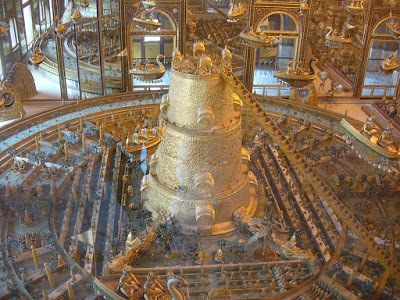
By the 13th century A.D. the idea of a magnetic mountain at the North Pole was widely known enough that Italian poet Guido Guinizelli actually used it as a simile for the power of his woman's love. The section from his poem "Madonna, The Fine Love I Give you," translated reads, "In that land beneath the North Wind / are the magnetic mountains / which transmit to the air their power / to attract the iron, but because it is far away / it needs help from a similar stone / to make the compass needle / turn towards the pole star."
In the 14th century two lost books "Inventio Fortunata" by Nicholas de Lynn and "The Itinerium" of Jacobus Cnoyen mention the magnetic mountain, four directional rivers, and encircling whirlpool said to change every 6 hours causing the tides, comparing them to the “breath of God” at the “naval of the Earth,” inhaling and exhaling the great seas. Many citations from the two books are made by more modern sources, but surviving copies have unfortunately all been lost to antiquity.
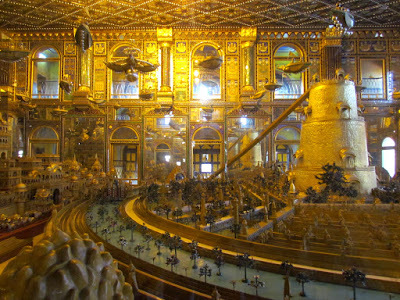
Nicholas de Lynn was an English Minorite friar of Oxford, a mathematician, astronomer and explorer who lived from 1330 to 1390. He was fascinated by the astrolabe and actually produced several of them for patrons and his own personal use. John of Gaunt, Duke of Lancaster, even comissioned Nicholas to produce an astrolabe and a "Kalendarium" of complete astronomical tables covering 1387 to 1463 which were later used to create nautical almanacs. For this Nicholas became famously known as "The Man with the Astrolabe," and was even complimented and lauded as an astronomical genius by Geoffrey Chaucer in his "Treatise on the Astrolabe." His esteem as a knowledgable astronomer and navigator soon reached King Edward III who in the early 1360s sent Nicholas and a team of ships to explore the Arctic.
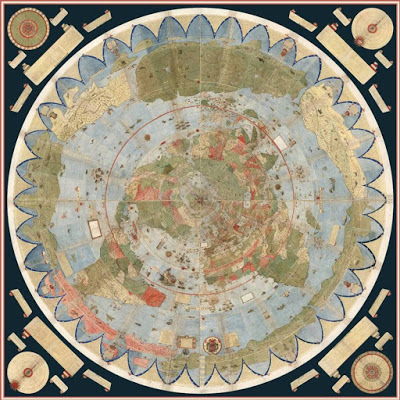
“The work by which Nicholas of Lynn will longest be remembered is not now to be found. Its disappearance under any circumstances is not a matter of surprise, since of many important works once well known no copy remains today, while of others there are only one or two examples. Unfortunately, we know almost as little about the voyages made from Lynn by the fellow townsmen of Nicholas as about the book in question. Many hardy mariners sailed from the port of Lynn, but of their enterprise at the north only the most scanty memorials remain. It is nevertheless clear that their activity was appreciated by Edward III, while their neighbors of Blakeney were several times favored by that king on account of their superior merit.” -Benjamin Franklin DeCosta, "Inventio Fortunata, Arctic Exploration With An Account of Nicholas of Lynn" (19)
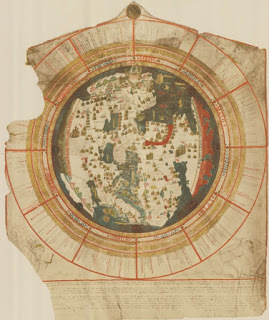 What we know about Nicholas de Lynn, his polar explorations, and his lost book now come from existing citations and quotations from his contemporaries and readers. One such man was Jacobus Cnoyen, a Dutch explorer who composed a book of travel epics in Flemish, also lost to antiquity, but quoted and re-printed in later works still available. Cnoyen is referenced as learning from "the Minorite" (Nicholas de Lynn) that "large parts of the polar indrawing sea did not freeze over in winter." Speaking of Nicholas, Cnoyen wrote, "the priest who had the astrolabe related to the kind of Norway that in 1360 AD there had come to these Northern Islands an English Minorite from Oxford who was a good astronomer. Leaving the rest of the party who had come to the Islands, he journeyed further through the whole of the North and put into writing all the wonders of those islands, and gave the King of England this book, which he called in Latin Inventio Fortunatae, which book began at latitude 54 degrees, continuing to the Pole."
What we know about Nicholas de Lynn, his polar explorations, and his lost book now come from existing citations and quotations from his contemporaries and readers. One such man was Jacobus Cnoyen, a Dutch explorer who composed a book of travel epics in Flemish, also lost to antiquity, but quoted and re-printed in later works still available. Cnoyen is referenced as learning from "the Minorite" (Nicholas de Lynn) that "large parts of the polar indrawing sea did not freeze over in winter." Speaking of Nicholas, Cnoyen wrote, "the priest who had the astrolabe related to the kind of Norway that in 1360 AD there had come to these Northern Islands an English Minorite from Oxford who was a good astronomer. Leaving the rest of the party who had come to the Islands, he journeyed further through the whole of the North and put into writing all the wonders of those islands, and gave the King of England this book, which he called in Latin Inventio Fortunatae, which book began at latitude 54 degrees, continuing to the Pole." 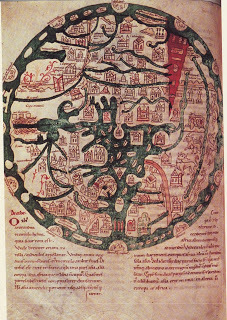 Both Nicholas and Cnoyen's books contained a detailed map of the Arctic derived from Nicholas' journeys which included a magnetic mountain at the North Pole, 4 directional streams, encircling whirlpool, and surrounding islands. Luckily for posterity, a version of this map still survives to this day because it was used for Johannes Ruysch's 1508 map of the world and later reproduced in detail and published in 1595 by the most well-known cartographer in history, responsible for the most popular maps ever created, Gerardus Mercator.
Both Nicholas and Cnoyen's books contained a detailed map of the Arctic derived from Nicholas' journeys which included a magnetic mountain at the North Pole, 4 directional streams, encircling whirlpool, and surrounding islands. Luckily for posterity, a version of this map still survives to this day because it was used for Johannes Ruysch's 1508 map of the world and later reproduced in detail and published in 1595 by the most well-known cartographer in history, responsible for the most popular maps ever created, Gerardus Mercator. On the legend of Ruysch's map Nicholas de Lynn's Inventio Fortunata is referenced as it's source, stating that, "It is written in the Book of the Fortunate Discovery that, under the Arctic Pole, there is a high magnetic rock 33 German miles in circumference. A surging sea surrounds this rock, as if the water were discharged downward from a vase through an opening to four mouths below. Around are islands, of which two are inhabited. Mountains vast and wide surround these islands, 24 of which deny habitation to man." Another inscription on Ruysch's map describes the incredible magnetic effect of the polar lodestone mountain, stating, "Here the ship's compass loses its property, and no vessel with iron on board is able to get away."
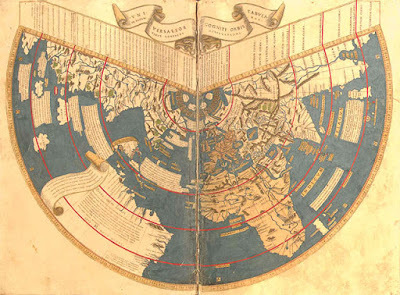
"A world map by Johannes Ruysch, the Universalior cogniti orbis tabula, published in an edition of Ptolemy's Geographia in Rome in 1508, shows four islands around the North Pole; two (the one north of Greenland and its opposite across the Pole) are labeled "Insula Deserta"; the one north of Europe is that of the Hyperboreans; and the one north of America is labeled "Aronphei." He labels the waters within the four islands as the "Mare Sugenum," and speaks of a violent whirlpool that sucks the incoming waters down into the earth; in addition, his map shows a ring of small, very mountainous islands around the four islands, which numerous islands Ruysch says are uninhabited." -Chet Van Duzer, "The Mythic Geography of the Northern Polar Regions"
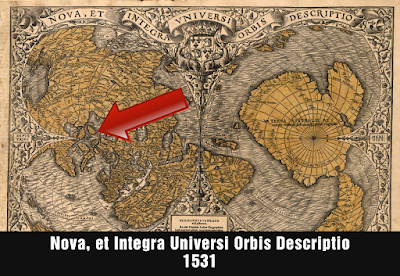
“This would seem to indicate that the book written by Nicholas of Lynn was known to the mapmaker, while, also, it may have been known at Rome. It is evident that the polar region was drawn more or less in accordance with some plan by Nicholas, which was combined with later material. Around the magnetic rock, immediately under the pole, are four islands, ‘Aronphei,’ ‘Insvla deserta,’ ‘Hyperborei Evropa’ and ‘Insvle Deserta.’ Outside of these islands are smaller and mountainous islands, arranged in a semi-circle, while the peninsula of ‘Pilapelanti,’ with its base resting upon Europe, pushes out into this druidic arrangement of islands, bearing up what is intended to represent a church, with the legend ‘Sacte Odulfi.’ Eastward of this peninsula is the ‘Provicia obscura,’ and the ‘Marc Svgenvm.’ Westward of ‘Bergi extrema’ another peninsula enters the groups of islands, which is pierced by ‘planora de Berga’ at the extreme west. The ‘Mare Svgenvm’ also fills the west. South of ‘Grvenlant’ is ‘Terra Nova,’ or New Foundland. From the ‘Mare Svgenvm’ the water flows northward through the four openings into the polar basin. The arrangement is curious, yet not wholly without resemblance to what is found in nature; for what is called the polar basin is fed by several vast streams pouring into it from the warm regions at the south. These streams also create counter currents, which flow southward, bearing enormous quantities of the heaviest ice." -Benjamin Franklin DeCosta, "Inventio Fortunata, Arctic Exploration With An Account of Nicholas of Lynn" (22)
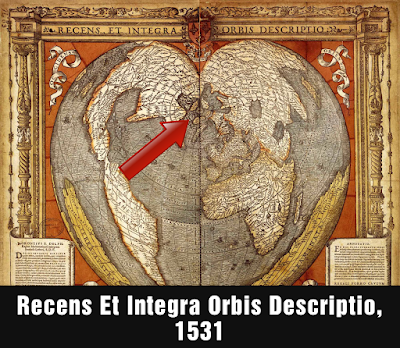
Swedish historian Olaus Magnus wrote of both the magnetic mountain and surrounding whirlpool in his 1555 work "Historia de Gentibus Septentrionalibus" (A Description of the Northern Peoples) stating it to be a well-known fact that ships in the north must be built with wooden pegs, as iron nails would be pulled out by the northern lodestone mountain, and that, "between Roest and Lofoten is so great an abyss, or rather Charybdis, that it suddenly swamps and swallows up in an instant those mariners who incautiously approach. Pieces of wreckage are very seldom thrown up again, and if they come to light, the hard material shows such signs of wear and chafing through being dashed against the rocks, that it looks as if it were covered with rough wool."

Just two years later in 1557, English explorer Anthony Jenkinson also wrote of the whirlpool, saying, "Note that there is between the said Rost Islands and Lofoot, a whirle poole called Malestrand, which from halfe ebbe untill halfe flood, maketh such a terrible noise, that it shaketh the ringes in the doores of the inhabitants houses of the sayd islands tenne miles off. Also if there commeth any whale within the current of the same, they make a pitifull crie. Moreover, if great trees be carried into it by force of streams, and after with the ebbe be cast out againe, the ends and boughs of them have bene so beaten, that they are like the stalkes of hempe that is bruised."
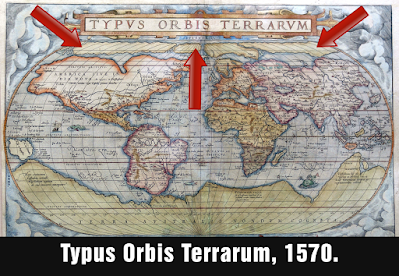
A few decades later in 1591, Schönneböl, a man who was sheriff of Lofoten and Vesteralen for over twenty years, wrote a similar description claiming that, "Iron rings on house doors are shaken hither and thither by the rushing of the current. Whales who cannot go forward on account of the strong stream, give a great cry and then are gone. And great trees, spruce or fir, which disappear in this current, and when at last they come up again, then all the boughs, all the roots and all the bark is torn off, and it is shaped as though it had been cut with a sharp axe."
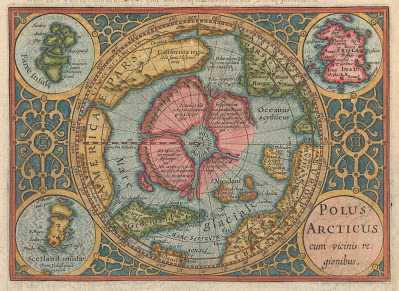
The most famous map-maker who ever lived and likely the only person in the history of cartography to become a household name, Gerardus Mercator, known for his meticulous accuracy and responsible for the popular "Mercator projection," lived from 1512 to 1594 and created hundreds of detailed maps. The year after his death in 1595 his family compiled his life's work into an Atlas which included never before released reproductions of Nicholas de Lynn's maps of the polar regions, specifically the "Septentrionalium Terrarum Descriptio." This incredible map shows the polar magnetic mountain "said to be the highest in the world," named "Rupes Nigra," encircling whirlpool, 4 directional rivers, and surrounding islands in fine detail along with several revealing inscriptions.
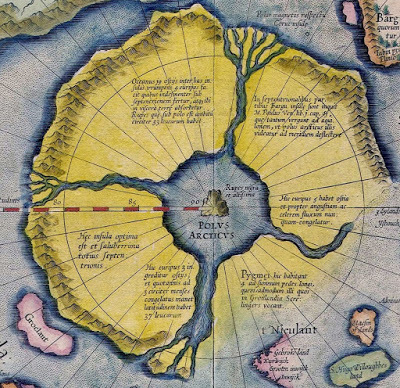
"The map shows a North Pole that is very unfamiliar to modern eyes. At the center of the map, and right at the Pole, stands a huge black mountain; this mountain was made of lodestone, and was the source of the earth's magnetic field. The central mountain is surrounded by open water, and then further out by four large islands that form a ring around the Pole. The largest of these islands perhaps 700 by 1100 miles, and they all have high mountains along their southern rims. These islands are separated by four large inward-flowing rivers, which are aligned as if to the four points of the compass - though of course there is no north, east, or west at the North Pole: every direction from this center is south. Mercator's notes inform us that the waters of the oceans are carried northward to the Pole through these rivers with great force, such that no wind could make a ship sail against the current. The waters then disappear into an enormous whirlpool beneath the mountain at the Pole, and are absorbed into the bowels of the earth. Mercator also tells us that four-foot tall Pygmies inhabit the island closest to Europe." -Chet Van Duzer, "The Mythic Geography of the Northern Polar Regions"
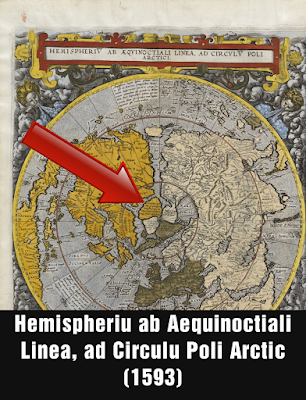 In another inscription made on the map, Mercator informs the reader further regarding the great whirlpool, stating that, "a monstrous gulf in the sea towards which from all sides the billows of the sea coming from remote parts converge and run together as though brought there by conduit, pouring into these mysterious abysses of nature, they are as though devoured thereby and, should it happen that a vessel pass there, it is seized and drawn away with such powerful violence of the waves that this hungry force immediately swallows it up never to appear again."
In another inscription made on the map, Mercator informs the reader further regarding the great whirlpool, stating that, "a monstrous gulf in the sea towards which from all sides the billows of the sea coming from remote parts converge and run together as though brought there by conduit, pouring into these mysterious abysses of nature, they are as though devoured thereby and, should it happen that a vessel pass there, it is seized and drawn away with such powerful violence of the waves that this hungry force immediately swallows it up never to appear again." 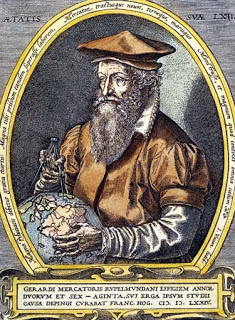 Gerardus Mercator studied at the University of Louvain in 1549 where he met and befriended another very influential figure of his time, John Dee, astronomer / astrologer and advisor to Queen Elizabeth I. Dee was convinced that a route to the Indies could be found through the Northwest Passage and while attempting to interest Queen Elizabeth to support an expedition, he contacted Mercator for more information. In Mercator's 1577 letter back to Dee we learn he copied verbatim from Jacobus Cnoyen's Itinerium stating that, “In the midst of the four countries is a whirlpool, into which there empty these four indrawing Seas which divide the North. And the water rushes round and descends into the Earth just as if one were pouring it through a filter funnel. It is four degrees wide on every side of the Pole, that is to say eight degrees altogether. Except that right under the Pole there lies a bare Rock in the midst of the Sea. Its circumference is almost 33 French miles, and it is all of magnetic Stone. And is as high as the clouds, so the Priest said, who had received the astrolabe from this Minorite in exchange for a Testament. And the Minorite himself had heard that one can see all round it from the Sea, and that it is black and glistening. And nothing grows thereon, for there is not so much as a handful of soil on it. This is word for word everything that I copied out of this author years ago.”
Gerardus Mercator studied at the University of Louvain in 1549 where he met and befriended another very influential figure of his time, John Dee, astronomer / astrologer and advisor to Queen Elizabeth I. Dee was convinced that a route to the Indies could be found through the Northwest Passage and while attempting to interest Queen Elizabeth to support an expedition, he contacted Mercator for more information. In Mercator's 1577 letter back to Dee we learn he copied verbatim from Jacobus Cnoyen's Itinerium stating that, “In the midst of the four countries is a whirlpool, into which there empty these four indrawing Seas which divide the North. And the water rushes round and descends into the Earth just as if one were pouring it through a filter funnel. It is four degrees wide on every side of the Pole, that is to say eight degrees altogether. Except that right under the Pole there lies a bare Rock in the midst of the Sea. Its circumference is almost 33 French miles, and it is all of magnetic Stone. And is as high as the clouds, so the Priest said, who had received the astrolabe from this Minorite in exchange for a Testament. And the Minorite himself had heard that one can see all round it from the Sea, and that it is black and glistening. And nothing grows thereon, for there is not so much as a handful of soil on it. This is word for word everything that I copied out of this author years ago.”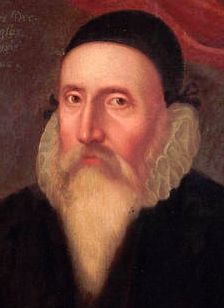 As late as the mid-17th century, aspects of these polar phenomena continued appearing in cartography and cosmography. The "euripi" or 4 indrawing streams, were included or alluded to in Linschoten's 1595 map, the Ortelius of 1599, Quod's Fascicvlvs Geographicvs of 1608, Hondius' 1619 map, Purchas' map of 1625, and in Heylin's 1659 Cosmographie he wrote about the Rupes Nigra and surrounding whirlpool and euripi, stating that, "Under the Arctick Pole is said to be a Black Rock of wonderous height, about 33 leagues in compass; the Land adjoining being torn by the sea into four great islands. For the Ocean violently breaking through it, and disgorging itself by 19 channels, maketh four Euripi, or fierce Whirlpools, by which the waters are finally carried towards the North, and these swallowed into the Bowels of the Earth. That Eurpius or Whirlpool which is made by the Scythic Ocean, hath five Inlets, and by reason of his strait passage, and violent course, is never frozen: the other on the back of Greenland being 37 leagues long, hath three inlets, and remaineth frozen three months yearly. Between these two lieth an Island, on the North of Lappia and Biarmia, inhabited as they say by Pygmies, the tallest of them not above four foot high. A certain Scholer of Oxford reporteth, that these four Euripi are carried with such furious violence towards some Gulf, in which they are finally swallowed up, that no ship is able with never so strong a Gale to stem the Current and yet there is never so strong a wind as to blow a windmill."
As late as the mid-17th century, aspects of these polar phenomena continued appearing in cartography and cosmography. The "euripi" or 4 indrawing streams, were included or alluded to in Linschoten's 1595 map, the Ortelius of 1599, Quod's Fascicvlvs Geographicvs of 1608, Hondius' 1619 map, Purchas' map of 1625, and in Heylin's 1659 Cosmographie he wrote about the Rupes Nigra and surrounding whirlpool and euripi, stating that, "Under the Arctick Pole is said to be a Black Rock of wonderous height, about 33 leagues in compass; the Land adjoining being torn by the sea into four great islands. For the Ocean violently breaking through it, and disgorging itself by 19 channels, maketh four Euripi, or fierce Whirlpools, by which the waters are finally carried towards the North, and these swallowed into the Bowels of the Earth. That Eurpius or Whirlpool which is made by the Scythic Ocean, hath five Inlets, and by reason of his strait passage, and violent course, is never frozen: the other on the back of Greenland being 37 leagues long, hath three inlets, and remaineth frozen three months yearly. Between these two lieth an Island, on the North of Lappia and Biarmia, inhabited as they say by Pygmies, the tallest of them not above four foot high. A certain Scholer of Oxford reporteth, that these four Euripi are carried with such furious violence towards some Gulf, in which they are finally swallowed up, that no ship is able with never so strong a Gale to stem the Current and yet there is never so strong a wind as to blow a windmill."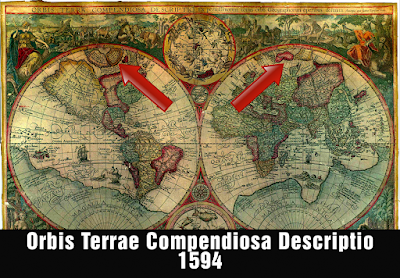
There is modern circumstantial evidence that lends strong credence to this idea as well. The largest publicly-known maelstrom in the world is called Saltstraumen just North of the Arctic circle in Norway, where 400 million cubic meters of water pass through a 3km long, 150-meter wide strait reaching speeds of 10 meters per second. Similar to legends of Hvergelmir, this Northern whirlpool actually arises exactly 4 times per day, every 6 hours, along with the shifting of the tides! In fact, the majority of naturally occuring whirlpools in the world, including the famous Naruto whirlpools in Japan, form 4 times per day, every 6 hours, as the tides change.
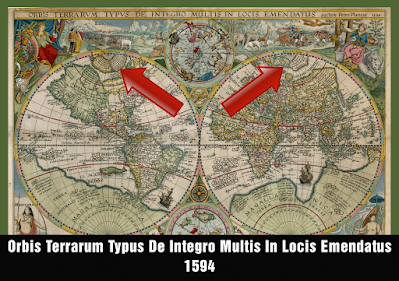
If the entire ancient world's mythologies along with early explorers, historians and cartographers all shared similar accounts of a polar magnetic mountain, encircling whirlpool, four directional streams, and surrounding islands occupied by giants and/or pygmies, why is it that no modern accounts of the North Pole have a single mention of any such thing? How is it possible for such consistency in polar geography to exist throughout the ancient world? Why have all of these features suddenly disappeared from modern maps? Were the ancients all completely mistaken with regards to the North Pole, or are we now in modern times the victims of a concerted cover-up, and being deceived about what is really at the Pole?
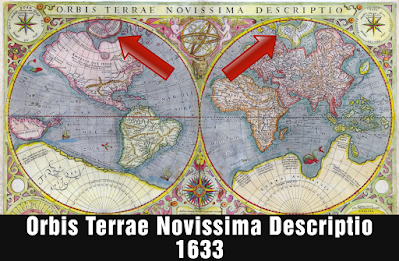
 Buy Flatlantis Now in Paperback, eBook, or ePub
Buy Flatlantis Now in Paperback, eBook, or ePub
October 20, 2020
Telepathy
 The term “telepathy” was coined in 1882 by Frederic Myers, founder of the Society for Psychical Research, during his investigation into what was formerly known as “thought transference.” Reports and documented cases of thought transference abound in almost every culture dating back for millennia, but during the 20th century, the scientific method was applied and repeatable experiments were performed which proved, with combined odds against chance of trillions to one, that telepathy is indeed a genuine phenomenon.
The term “telepathy” was coined in 1882 by Frederic Myers, founder of the Society for Psychical Research, during his investigation into what was formerly known as “thought transference.” Reports and documented cases of thought transference abound in almost every culture dating back for millennia, but during the 20th century, the scientific method was applied and repeatable experiments were performed which proved, with combined odds against chance of trillions to one, that telepathy is indeed a genuine phenomenon. The most common method of testing perceptual-psi (ESP/telepathy) is to isolate a test subject from a hidden target object or person placed at a distance and see if the test subject can accurately describe the target or mentally influence the other person. Hundreds of variations have been performed on experiments following this basic design:
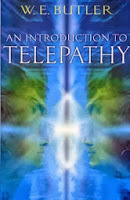 “A classic experiment in telepathy was reported in 1923 by Dr. H. I. F. W. Brugmans and his colleagues in the Department of Psychology at the University of Groningen, The Netherlands. In this experiment, a 23 year-old physics student named Van Dam was investigated for his claimed telepathic abilities. He was placed inside a curtained booth, blindfolded, and asked to place his arm under the curtain to select one square on a 6 x 8 checkerboard placed on a table next to the curtain. The target square Van Dam was attempting to select was determined randomly by the experimenter on each trial. An assistant experimenter knew the target square and tried to mentally influence Van Dam’s arm movements to guide him to select the correct target square … The results of the experiment were extremely significant, with 60 successes out of 187 trials rather than the 4 expected by chance. That’s associated with odds against chance of 121 trillion to 1.” -Dean Radin, “Entangled Minds” (82-3)
“A classic experiment in telepathy was reported in 1923 by Dr. H. I. F. W. Brugmans and his colleagues in the Department of Psychology at the University of Groningen, The Netherlands. In this experiment, a 23 year-old physics student named Van Dam was investigated for his claimed telepathic abilities. He was placed inside a curtained booth, blindfolded, and asked to place his arm under the curtain to select one square on a 6 x 8 checkerboard placed on a table next to the curtain. The target square Van Dam was attempting to select was determined randomly by the experimenter on each trial. An assistant experimenter knew the target square and tried to mentally influence Van Dam’s arm movements to guide him to select the correct target square … The results of the experiment were extremely significant, with 60 successes out of 187 trials rather than the 4 expected by chance. That’s associated with odds against chance of 121 trillion to 1.” -Dean Radin, “Entangled Minds” (82-3)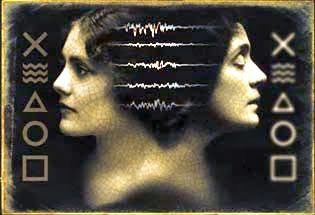 “A second classic experiment that has withstood the test of time is the ESP card test, as popularized by J. B. Rhine’s Parapsychology Laboratory at Duke University. This test involved cards imprinted with one of five symbols: circle, square, wavy lines, star and triangle … In a typical experimental run, the deck was thoroughly shuffled and then one person would select each card in turn and try to mentally send the symbol on that card to a distant person. This technique made it possible to collect hundreds of trials quickly, in a wide variety of environments, and under controlled conditions … Rhine’s 1940 book, Extrasensory Perception After Sixty Years combined his 60 years of ESP research, 188 different experiments with thousands of trials, in which even the most highly controlled studies had odds against chance of 375 trillion to 1.” -Dean Radin, “Entangled Minds” (84-5)
“A second classic experiment that has withstood the test of time is the ESP card test, as popularized by J. B. Rhine’s Parapsychology Laboratory at Duke University. This test involved cards imprinted with one of five symbols: circle, square, wavy lines, star and triangle … In a typical experimental run, the deck was thoroughly shuffled and then one person would select each card in turn and try to mentally send the symbol on that card to a distant person. This technique made it possible to collect hundreds of trials quickly, in a wide variety of environments, and under controlled conditions … Rhine’s 1940 book, Extrasensory Perception After Sixty Years combined his 60 years of ESP research, 188 different experiments with thousands of trials, in which even the most highly controlled studies had odds against chance of 375 trillion to 1.” -Dean Radin, “Entangled Minds” (84-5)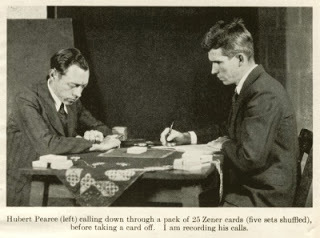 In 1933, Hubert E. Pearce Jr., a student of J.B. Rhine’s at Duke University introduced himself saying that he had inherited his mother’s clairvoyant abilities and would be willing to scientifically test and verify his skills. For the next seven months, Rhine worked with Pearce devising, performing, and documenting the now famous Pearce-Pratt distance telepathy tests at his Duke Parapsychology Lab. The experiment consisted of 700 runs through 25-card ESP decks with Pearce acting as the telepathic receiver while another student, Gaither Pratt, was the sender. Pratt simply laid down one card per minute and concentrated on it, while Pearce, from another building on campus, attempted to telepathically read and/or clairvoyantly see each card. After 1,850 trials, Pearce guessed the correct card 558 times (32%), which is 188 times above chance expectation (20%). Though this 12% difference may not sound like much, it is associated with odds against chance of 10,000,000,000,000,000,000,000,000,000 to 1.
In 1933, Hubert E. Pearce Jr., a student of J.B. Rhine’s at Duke University introduced himself saying that he had inherited his mother’s clairvoyant abilities and would be willing to scientifically test and verify his skills. For the next seven months, Rhine worked with Pearce devising, performing, and documenting the now famous Pearce-Pratt distance telepathy tests at his Duke Parapsychology Lab. The experiment consisted of 700 runs through 25-card ESP decks with Pearce acting as the telepathic receiver while another student, Gaither Pratt, was the sender. Pratt simply laid down one card per minute and concentrated on it, while Pearce, from another building on campus, attempted to telepathically read and/or clairvoyantly see each card. After 1,850 trials, Pearce guessed the correct card 558 times (32%), which is 188 times above chance expectation (20%). Though this 12% difference may not sound like much, it is associated with odds against chance of 10,000,000,000,000,000,000,000,000,000 to 1.  Another popular and often replicated psi experiment is known as the “Ganzfield” telepathy test. In a ganzfield test, Participant A sits in a comfortable, reclining chair, wears headphones playing pink noise (peaceful waterfall sound), has halved ping-pong balls placed over their eyes, and a soft red light shined on them. This type of sensory deprivation results in a dreamy state of awareness in which the subject becomes more open to mental suggestions/impressions. Once Participant 1 is fully immersed in this “ganzfield condition,” Participant 2 sits in another room watching a freeze-frame picture on a TV screen and attempts to telepathically send that image to Participant 1. Later, Participant 1 comes out of the ganzfield state, discusses their impressions, is shown 4 images, and must choose which one they think Participant 2 was sending them.
Another popular and often replicated psi experiment is known as the “Ganzfield” telepathy test. In a ganzfield test, Participant A sits in a comfortable, reclining chair, wears headphones playing pink noise (peaceful waterfall sound), has halved ping-pong balls placed over their eyes, and a soft red light shined on them. This type of sensory deprivation results in a dreamy state of awareness in which the subject becomes more open to mental suggestions/impressions. Once Participant 1 is fully immersed in this “ganzfield condition,” Participant 2 sits in another room watching a freeze-frame picture on a TV screen and attempts to telepathically send that image to Participant 1. Later, Participant 1 comes out of the ganzfield state, discusses their impressions, is shown 4 images, and must choose which one they think Participant 2 was sending them.  “From 1974 through 2004 a total of 88 ganzfield experiments reporting 1,008 hits in 3,145 trials were conducted. The combined hit rate was 32% as compared to the chance-expected 25%. This 7% above-chance effect is associated with odds against chance of 29,000,000,000,000,000,000 (or 29 quintillion) to 1.” -Dean Radin, “Entangled Minds” (120)
“From 1974 through 2004 a total of 88 ganzfield experiments reporting 1,008 hits in 3,145 trials were conducted. The combined hit rate was 32% as compared to the chance-expected 25%. This 7% above-chance effect is associated with odds against chance of 29,000,000,000,000,000,000 (or 29 quintillion) to 1.” -Dean Radin, “Entangled Minds” (120)“The modern ganzfield experiment is as close to the perfect psi experiment as anyone knows how to conduct. Until recently, the ganzfield experiments were largely unknown outside of the discipline of parapsychology. Then, in 1994, psychologists Daryl Bem from Cornell University and Charles Honorton from the University of Edinburgh published a meta-analysis of ganzfield studies in Psychological Bulletin, a well-regarded academic psychology journal. That paper provided strong evidence for a genuine psi effect. Bem and Honorton’s review of earlier ganzfield studies estimated an effect with overall odds against chance of 48 billion to 1.” -Dean Radin, “Entangled Minds” (117-8)
 In Upton Sinclair’s 1930 book Mental Radio he cataloged a series of picture-drawing telepathy experiments performed in collaboration with his ESP-gifted wife Mary Craig Sinclair. During these tests Upton or friends/family would sketch a small object and then Mary, in another room, another house, or even miles away, would mentally perceive the image and reproduce the sketch herself. Mental Radio contains scores of these sketches which show incredible similarities far beyond what anyone would expect by chance. In conclusion to these experiments, Upton Sinclair wrote, “there isn’t a thing in the world that leads me to [write this book] except the conviction which has been forced upon me that telepathy is real, and that loyalty to the nature of the universe makes it necessary for me to say so … It is foolish to be convinced without evidence, but it is equally foolish to refuse to be convinced by real evidence.”
In Upton Sinclair’s 1930 book Mental Radio he cataloged a series of picture-drawing telepathy experiments performed in collaboration with his ESP-gifted wife Mary Craig Sinclair. During these tests Upton or friends/family would sketch a small object and then Mary, in another room, another house, or even miles away, would mentally perceive the image and reproduce the sketch herself. Mental Radio contains scores of these sketches which show incredible similarities far beyond what anyone would expect by chance. In conclusion to these experiments, Upton Sinclair wrote, “there isn’t a thing in the world that leads me to [write this book] except the conviction which has been forced upon me that telepathy is real, and that loyalty to the nature of the universe makes it necessary for me to say so … It is foolish to be convinced without evidence, but it is equally foolish to refuse to be convinced by real evidence.” “A second example of picture-drawing experiments is described in the book Mind to Mind, published in 1948, by French researcher Rene Warcollier … Warcollier was already convinced that telepathy existed through the work of Rhine and others, so his books primarily explored how it worked … He noted that images were not transmitted like photographs but were ‘scrambled, broken up into component elements which are often transmuted into a new pattern.’ What Warcollier demonstrated is compatible with what modern cognitive neuroscience has learned about how visual images are constructed by the brain. It implies that telepathic perceptions bubble up into awareness from the unconscious and are probably processed in the brain in the same way that we generate images in dreams. And thus telepathic ‘images’ are far less certain than sensory-driven images and subject to distortion.” -Dean Radin, “Entangled Minds” (92-93)
“A second example of picture-drawing experiments is described in the book Mind to Mind, published in 1948, by French researcher Rene Warcollier … Warcollier was already convinced that telepathy existed through the work of Rhine and others, so his books primarily explored how it worked … He noted that images were not transmitted like photographs but were ‘scrambled, broken up into component elements which are often transmuted into a new pattern.’ What Warcollier demonstrated is compatible with what modern cognitive neuroscience has learned about how visual images are constructed by the brain. It implies that telepathic perceptions bubble up into awareness from the unconscious and are probably processed in the brain in the same way that we generate images in dreams. And thus telepathic ‘images’ are far less certain than sensory-driven images and subject to distortion.” -Dean Radin, “Entangled Minds” (92-93)A third picture-drawing experiment was conducted in 1941 at Cambridge University by psychologist Whatley Carington. He recruited 250 students to attempt to replicate sketches in a series of 5 experiments, with 10 drawings each, for a total of 50 targets. By the end of the study Carington had collected 2,200 student sketches which he then cross-matched with the original 50 possible targets. Amazingly he found 1,209 drawings (55%) were similar to the targets! And this is from 250 different students with no particular ESP gifts or previous experience.
 Another telepathy test that has been scientifically investigated for nearly a century is the sense of being stared at. In a typical study of this sort, Participant 1 stands with his back turned to Particpant 2, who stands a few meters behind him. Next Partcipant 2 flips a coin to decide whether he will stare at the back of Participant 1’s head for 10 seconds, or look away for 10 seconds. After the 10 seconds pass, Participant 1 records their impression, yes or no, and the coin is flipped again for the next trial.
Another telepathy test that has been scientifically investigated for nearly a century is the sense of being stared at. In a typical study of this sort, Participant 1 stands with his back turned to Particpant 2, who stands a few meters behind him. Next Partcipant 2 flips a coin to decide whether he will stare at the back of Participant 1’s head for 10 seconds, or look away for 10 seconds. After the 10 seconds pass, Participant 1 records their impression, yes or no, and the coin is flipped again for the next trial. “British biologist Rupert Sheldrake has popularized experiments based on this simple design … and under more controlled conditions, such as those involving use of blindfolds, no trial-by-trial feedback, and even more secure conditions such as having [participants] stare through a window from a distance. I found 60 such experiments involving a total of 33,357 trials from publications cited by Sheldrake and others. The overall success rate in these experiments was 54.5% where chance expectation is 50%. The overall odds against chance are a staggering 202 octodecillion (that’s 20,200,000,000,000,000,000,000,000,000,000,000,000,000,000,000,000,000,000,000) to 1.” -Dean Radin, “Entangled Minds” (127)
 In over a dozen scientific experiments over the last 45 years, using EEG and MRI brain scanning technology, pairs of identical twins have been separated into different rooms, and one of them subjected to visual or emotional stimulus which is then found to register on both of their brains simultaneously. This has also been shown to happen (with a lower correlation rate) between family, friends, and complete strangers as well.
In over a dozen scientific experiments over the last 45 years, using EEG and MRI brain scanning technology, pairs of identical twins have been separated into different rooms, and one of them subjected to visual or emotional stimulus which is then found to register on both of their brains simultaneously. This has also been shown to happen (with a lower correlation rate) between family, friends, and complete strangers as well.“The design used in these electroencephalograph or ‘EEG correlation’ experiments asks, in effect, whether poking one person will produce an ouch response in a distant partner. It’s not recommended to poke people in the brain, so instead we use a stimulus like a flashing light to cause one of the brains to jump electrically in a predictable way, and then we look at the other, distant brain to see if it’s jumping at the same time.” -Dean Radin, “Entangled Minds” (136)
“Psychophysiologist Jacobo Grinberg-Zylberbaum and his colleagues from the National Autonomous University of Mexico reported a series of studies in which they claimed to detect simultaneous brain responses in the EEGs of separated pairs of people. One of their studies was published in the journal Physics Essays, stimulating another round of replication attempts. In 2003, a successful replication was reported in Neuroscience Letters by EEG specialist Jiri Wackermann and his colleagues … Wackermann’s team concluded that ‘We are facing a phenomenon which is neither easy to dismiss as a methodological failure or a technical artifact nor understood as to its nature. No biophysical mechanism is presently known that could be responsible for the observed correlations between EEGs of two separated subjects.’ Another successful replication, this time reported by Leanna Standish of Bastyr University and her colleagues, was recently reported in the medical journal Alternative Therapies in Health and Medicine. They conducted an EEG correlation experiment with the receiving participant located in a functional magnetic resonance imaging (fMRI) scanner … They found a highly significant increase in brain activity (odds against chance of 14,000 to 1) in the receiving person’s visual cortex (in the back of the brain) while the distant partner was viewing a flickering light. The same group later successfully replicated this finding.” -Dean Radin, “Entangled Minds” (137-8)
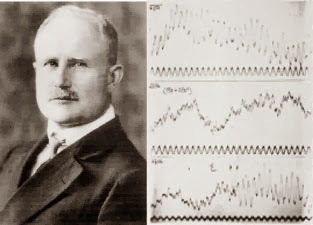 The man who invented the EEG, Hans Berger, actually became interested in the brain and the powers of the human psyche after a telepathic experience he had in early adulthood. It began when one day, as a soldier during a military training exercise, he was thrown off his horse and nearly trampled by a horse-drawn cannon:
The man who invented the EEG, Hans Berger, actually became interested in the brain and the powers of the human psyche after a telepathic experience he had in early adulthood. It began when one day, as a soldier during a military training exercise, he was thrown off his horse and nearly trampled by a horse-drawn cannon:“Miraculously, the driver of the artillery battery managed to stop the horses just in time. The accident left Hans thoroughly shaken but without serious injury. At that very moment, many miles away in his family’s home, Hans’s older sister was suddenly overwhelmed with an ominous certainty that something bad had happened to Hans. She anxiously insisted that their father contact him, and so he did via telegram. That evening, when Hans received the telegram, he was initially concerned, as he had never before received a telegram from his father. Then, upon reading his sister’s urgent concern about his well-being, he knew that his feelings of intense fear earlier in the day had somehow reached his sister. Many years later, Hans wrote, ‘This is a case of spontaneous telepathy in which at a time of mortal danger, and as I contemplated certain death, I transmitted my thoughts, while my sister, who was particularly close to me, acted as the receiver.’” -Dean Radin, “Entangled Minds” (22)
 “If telepathy is a real fact, it is very possible that it is operating at every moment and everywhere, but with too little intensity to be noticed, or else it is operating in the presence of obstacles which neutralize the effect at the same moment that it manifests itself. We produce electricity at every moment, the atmosphere is continually electrified, we move among magnetic currents, yet millions of human beings lived for thousands of years without having suspected the existence of electricity. It may be the same with telepathy.” -French philosopher and Nobel laureate Henri Bergson in presidential address to the Society for Psychical Research in London, May 1913
“If telepathy is a real fact, it is very possible that it is operating at every moment and everywhere, but with too little intensity to be noticed, or else it is operating in the presence of obstacles which neutralize the effect at the same moment that it manifests itself. We produce electricity at every moment, the atmosphere is continually electrified, we move among magnetic currents, yet millions of human beings lived for thousands of years without having suspected the existence of electricity. It may be the same with telepathy.” -French philosopher and Nobel laureate Henri Bergson in presidential address to the Society for Psychical Research in London, May 1913
Order the Spiritual Science 284-page Paperback

Download the Spiritual Science 284-page E-book

September 24, 2020
Ancient Polar Mythologies
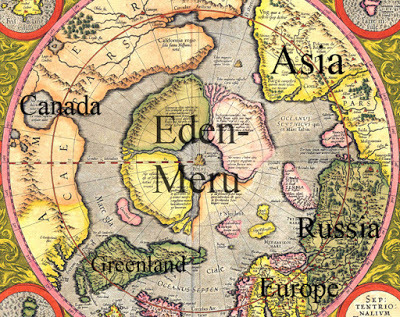
Nowadays and for the past five centuries, since the introduction of the heliocentric globe deception, all world maps and explorers have depicted and described the North Pole and surrounding region as being nothing but an arbitrary point in a semi-frozen tundra. Previous to this however, depictions and descriptions of the North Pole and surrounding regions in world maps and ancient explorers' accounts were very different. Firstly, before the 16th century, the North Pole was never once shown or thought to be just some random, ambiguous point amidst a low salinity Arctic Ocean as it is now. Instead, the North Pole was universally described and depicted, from diverse cultures all across the Earth, as being a gigantic magnetic mountain situated directly below Polaris. The prevailing belief was that compass needles the world over were actually pointing to a huge "loadstone mountain" made of magnetite at the Pole; in contrast to today's prevailing belief that compass needles are pointing to some constantly moving magnetic field generated by hypothetical molten metal existing at the center of a fantastical globe-Earth. While neither claim can be confirmed or denied without independent exploration and experimentation, it should be noted that nowhere in nature can we find molten metal which retains any significant magnetic properties once heated past the "Curie Point," let alone create some convoluted constantly moving di-polar field as is claimed by proponents of the fantasy ball-Earth.
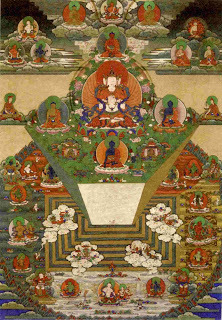 Ancient Buddhist, Vedic and Jain traditional cosmologies all state that at the North Pole magnetic center-point of Earth exists a circular mountain of magnetite called Mount Meru. Puranic and Sumerian traditions also referred to this place calling it "Mount Sumeru." In Ancient Iran they spoke of Mount Hara Berezaiti with a celestial spring on its highest peak in the realm of the stars. In early Chinese writings there is Mount Kunlun with a bronze Pillar of Heaven at the summit where the immortals dwell, often also called "The Pearl Mountain," a paradise home of four great rivers around which the heavens revolve. The Turkmen tribes of Southern Turkestan told of a copper pillar that marks the “Navel of the Earth.” The Mongols wrote of Mount Sumber with the Zambu tree on its summit. The Buryats of Siberia talked of Mount Sumur with the North Polestar fastened to its summit. The Siberian Dalmucks spoke of a mountain lake from which four rivers flow to the points of the compass. The Egyptians wrote of the “Mound of the First Time” which was the first land to appear from the waters and is the dwelling place of the High God, the source of light. The Muslims wrote of Qaf and Zoroastrians wrote of Girnagar, the world encircling mountains. The Navajos spoke of “encircled mountain” which was surrounded by four directional mountains. The Dogon tribe of Nigeria told of a cosmic pillar spanning 14 worlds which was the “roof-post of the house of the high god Amma.” The Warao Indians of the Orinoco Delta in Venezuela speak of a cosmic axis extending above the center of their earth disk. Ancient Greek mythology referred to "Mount Olympus, the Home of the gods." The ancient Germans told of “Irminsul” a universal column which sustains everything. The Norse Edda spoke of "Asgard," the burgh of the gods rising in the center of "Midgard," the circular earth. Ptolemy recounted a legend involving magnetic islands which exerted such strong attraction that ships with metal nails were held in place and unable to leave. In the Arabic legend, "One Thousand and One Nights," a magnetic mountain pulls all the nails right out of their ship causing it to fall apart and sink. The second tallest mountain in Tanzania is even named "Mount Meru" after its primordial partner at the Pole.
Ancient Buddhist, Vedic and Jain traditional cosmologies all state that at the North Pole magnetic center-point of Earth exists a circular mountain of magnetite called Mount Meru. Puranic and Sumerian traditions also referred to this place calling it "Mount Sumeru." In Ancient Iran they spoke of Mount Hara Berezaiti with a celestial spring on its highest peak in the realm of the stars. In early Chinese writings there is Mount Kunlun with a bronze Pillar of Heaven at the summit where the immortals dwell, often also called "The Pearl Mountain," a paradise home of four great rivers around which the heavens revolve. The Turkmen tribes of Southern Turkestan told of a copper pillar that marks the “Navel of the Earth.” The Mongols wrote of Mount Sumber with the Zambu tree on its summit. The Buryats of Siberia talked of Mount Sumur with the North Polestar fastened to its summit. The Siberian Dalmucks spoke of a mountain lake from which four rivers flow to the points of the compass. The Egyptians wrote of the “Mound of the First Time” which was the first land to appear from the waters and is the dwelling place of the High God, the source of light. The Muslims wrote of Qaf and Zoroastrians wrote of Girnagar, the world encircling mountains. The Navajos spoke of “encircled mountain” which was surrounded by four directional mountains. The Dogon tribe of Nigeria told of a cosmic pillar spanning 14 worlds which was the “roof-post of the house of the high god Amma.” The Warao Indians of the Orinoco Delta in Venezuela speak of a cosmic axis extending above the center of their earth disk. Ancient Greek mythology referred to "Mount Olympus, the Home of the gods." The ancient Germans told of “Irminsul” a universal column which sustains everything. The Norse Edda spoke of "Asgard," the burgh of the gods rising in the center of "Midgard," the circular earth. Ptolemy recounted a legend involving magnetic islands which exerted such strong attraction that ships with metal nails were held in place and unable to leave. In the Arabic legend, "One Thousand and One Nights," a magnetic mountain pulls all the nails right out of their ship causing it to fall apart and sink. The second tallest mountain in Tanzania is even named "Mount Meru" after its primordial partner at the Pole. 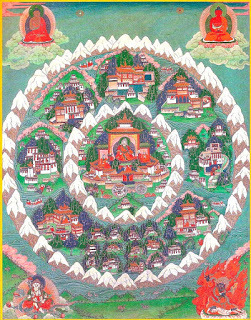 "In many traditions, the world mountain is identified symbolically with some local mountain. This is illustrated by Mount Olympus of the Greeks, Mount Alborz of the Iranians, and Mount Khun-Lun of the Chinese. In Near Eastern tradition, the world mountain is the small hill in Jerusalem known as Mount Zion. Thus the circular continent centered on Jerusalem in medieval maps also possessed a symbolic world mountain." -Richard L. Thompson, “The Cosmology of the Bhagavata Purana” (146)
"In many traditions, the world mountain is identified symbolically with some local mountain. This is illustrated by Mount Olympus of the Greeks, Mount Alborz of the Iranians, and Mount Khun-Lun of the Chinese. In Near Eastern tradition, the world mountain is the small hill in Jerusalem known as Mount Zion. Thus the circular continent centered on Jerusalem in medieval maps also possessed a symbolic world mountain." -Richard L. Thompson, “The Cosmology of the Bhagavata Purana” (146)“Jerusalem was Paul’s lodestone. The ancient mariners who set sail in their little cockleshell boats tended to hug the coastline, not daring to get too far from land. Aids to navigation were few, and their vessels were at the mercy of wind and wave. The slightest sign of a storm would send them scurrying for refuge. Moreover, the dreams of those old-time venturers were haunted by thoughts of the fabled, ‘lodestone mountain.’ They believed it had the power to draw their vessels to shipwreck on its shores against all the pull of tide and wind.” -John Phillips, “Exploring (the Book of) Acts” (402)
 Isaiah wrote about a mountain, set above all other mountains, in the far recesses of the North where the gods meet called Mount Zion in Jerusalem. Genesis, Ezekiel and Enoch all mention a paradisiacal Eden, the mountain of God, and source of four main rivers. Genesis 2: 10-14 reads: “And a river went out of Eden to water the garden; and from thence it was parted, and became into four heads. The name of the first is Pison: that is which compasseth the whole land of Havilah, where there is gold; And the gold of that land is good: there is bdellium and the onyx stone. And the name of the second river is Gihon: the same is it that compasseth the whole land of Ethiopia. And the name of the third river is Hiddekel: that is it which goeth toward the east of Assyria. And the fourth river is Euphrates."
Isaiah wrote about a mountain, set above all other mountains, in the far recesses of the North where the gods meet called Mount Zion in Jerusalem. Genesis, Ezekiel and Enoch all mention a paradisiacal Eden, the mountain of God, and source of four main rivers. Genesis 2: 10-14 reads: “And a river went out of Eden to water the garden; and from thence it was parted, and became into four heads. The name of the first is Pison: that is which compasseth the whole land of Havilah, where there is gold; And the gold of that land is good: there is bdellium and the onyx stone. And the name of the second river is Gihon: the same is it that compasseth the whole land of Ethiopia. And the name of the third river is Hiddekel: that is it which goeth toward the east of Assyria. And the fourth river is Euphrates." 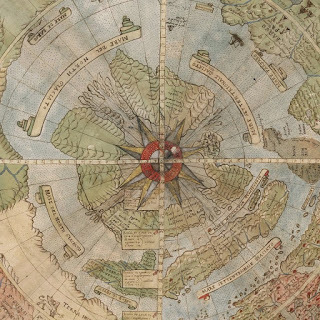 Mohammed also spoke of four rivers and a divine tree. In the Srimad Bhagavatam four branches of the celestial Ganges flow out from Brahmapuri on top of Mount Sumeru. In ancient Canaan, Guri’ili, the mountain of El, was the dwelling of El, the creator, and a place of assembly for the demi-gods. In one Phoenician ivory carving from around 1000 B.C., a deity is shown dressed to represent a mountain with four streams coming out from the mountain-god-man at right angles. Similarly, in an ancient Akkadian hymn to the goddess Ishtar, she is addressed as "the Queen of the Mountain of the World and Queen of the land of the four rivers of Erech," and she says, "I am lord of the steep mountains, which tremble whilst their summits reach to the firmament."
Mohammed also spoke of four rivers and a divine tree. In the Srimad Bhagavatam four branches of the celestial Ganges flow out from Brahmapuri on top of Mount Sumeru. In ancient Canaan, Guri’ili, the mountain of El, was the dwelling of El, the creator, and a place of assembly for the demi-gods. In one Phoenician ivory carving from around 1000 B.C., a deity is shown dressed to represent a mountain with four streams coming out from the mountain-god-man at right angles. Similarly, in an ancient Akkadian hymn to the goddess Ishtar, she is addressed as "the Queen of the Mountain of the World and Queen of the land of the four rivers of Erech," and she says, "I am lord of the steep mountains, which tremble whilst their summits reach to the firmament."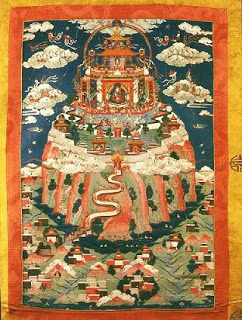 In the Christian apocryphal book of Enoch, Enoch is taken by angels on a tour of the seven heavens and while in the third heaven shown magnificent trees producing wonderful fruits with adjacent springs pumping honey, milk, oil and wine to four directional rivers flowing down into paradisiacal Eden, an abode specially prepared only for the pious and selfless. Similarly, in the Hindu cosmology, four trees in Ilavrta-varsa stand on great mountains producing rivers of nectar and honey, like fountains of youth, providing health and vitality to all who drink of them, while the central tallest "Jambu" tree rises to incredible heights and "seems to cover all the heavens."
In the Christian apocryphal book of Enoch, Enoch is taken by angels on a tour of the seven heavens and while in the third heaven shown magnificent trees producing wonderful fruits with adjacent springs pumping honey, milk, oil and wine to four directional rivers flowing down into paradisiacal Eden, an abode specially prepared only for the pious and selfless. Similarly, in the Hindu cosmology, four trees in Ilavrta-varsa stand on great mountains producing rivers of nectar and honey, like fountains of youth, providing health and vitality to all who drink of them, while the central tallest "Jambu" tree rises to incredible heights and "seems to cover all the heavens."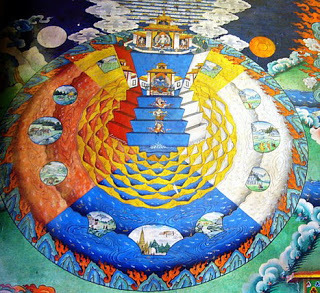 "In the Bhagavata Purana Mount Sumeru is surrounded by four great mountains surmounted by four gigantic trees. These include the Jambu tree after which Jambudvipa is named. Four huge lakes of milk, honey, sugarcane juice and pure water are located between the four mountains, and these lakes confer mystic powers on the celestial beings who bathe in them. There are also four celestial gardens near these lakes. From the foot of each of the four trees, there flows a river that either emerges from the tree itself or from the fruits of the tree. These rivers of honey and different kinds of juice flow throughout the region of Ilavrta-varsa surrounding Mount Sumeru, and they confer freedom from fatigue, disease, and old age on the inhabitants of that region." -Richard L. Thompson, “The Cosmology of the Bhagavata Purana” (132)
"In the Bhagavata Purana Mount Sumeru is surrounded by four great mountains surmounted by four gigantic trees. These include the Jambu tree after which Jambudvipa is named. Four huge lakes of milk, honey, sugarcane juice and pure water are located between the four mountains, and these lakes confer mystic powers on the celestial beings who bathe in them. There are also four celestial gardens near these lakes. From the foot of each of the four trees, there flows a river that either emerges from the tree itself or from the fruits of the tree. These rivers of honey and different kinds of juice flow throughout the region of Ilavrta-varsa surrounding Mount Sumeru, and they confer freedom from fatigue, disease, and old age on the inhabitants of that region." -Richard L. Thompson, “The Cosmology of the Bhagavata Purana” (132)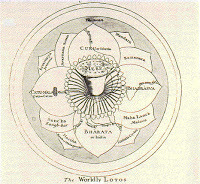 The Yakut people of northeastern Siberia have their own strikingly similar ancient myth where a world tree of immeasurable age exists "at the navel of the Earth," just like the Hindu Jambu tree is "born of the umbilical knot of Brahma." The Yakut world tree reaches into the high heavens with cones nine fathoms long and sap which imparts youthfulness on all who consume it. Near the Yakut tree also lies a lake of sweet milk, which is where the popular modern Japanese milk company "Yakult" doubtless gets its inspiration.
The Yakut people of northeastern Siberia have their own strikingly similar ancient myth where a world tree of immeasurable age exists "at the navel of the Earth," just like the Hindu Jambu tree is "born of the umbilical knot of Brahma." The Yakut world tree reaches into the high heavens with cones nine fathoms long and sap which imparts youthfulness on all who consume it. Near the Yakut tree also lies a lake of sweet milk, which is where the popular modern Japanese milk company "Yakult" doubtless gets its inspiration.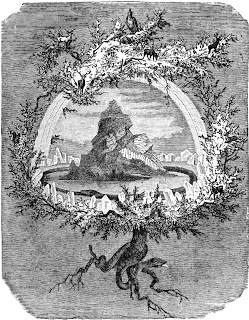 "In different traditions, the upper and lower worlds may be divided into several levels (often seven or nine). In the center of the earth-disk there is a world mountain or world pillar that links middle earth to the lower and upper worlds. The world mountain represents the polar axis, and the dwellings of great demigods are located on its summit. The world mountain may be surrounded by other mountains that define the cardinal directions, and these directions may be associated with certain colors. Four sacred rivers may also flow from the world mountain in the four cardinal directions. There is a world tree that is often situated on the world mountain (or four world trees may be located on the neighboring directional mountains). The world tree extends from the earth to the heavens, and it is nearly immortal. It is the source of rivers of nectar or pure water that give health and longevity to those who drink them. The tree stands in an earthly paradise where there are celestial gardens and rivers of various substances, such as milk, oil, and honey. The tree or world pillar is often associated with a great eagle-like bird that is the enemy of great serpents dwelling in the lower world." -Richard L. Thompson, “The Cosmology of the Bhagavata Purana” (135)
"In different traditions, the upper and lower worlds may be divided into several levels (often seven or nine). In the center of the earth-disk there is a world mountain or world pillar that links middle earth to the lower and upper worlds. The world mountain represents the polar axis, and the dwellings of great demigods are located on its summit. The world mountain may be surrounded by other mountains that define the cardinal directions, and these directions may be associated with certain colors. Four sacred rivers may also flow from the world mountain in the four cardinal directions. There is a world tree that is often situated on the world mountain (or four world trees may be located on the neighboring directional mountains). The world tree extends from the earth to the heavens, and it is nearly immortal. It is the source of rivers of nectar or pure water that give health and longevity to those who drink them. The tree stands in an earthly paradise where there are celestial gardens and rivers of various substances, such as milk, oil, and honey. The tree or world pillar is often associated with a great eagle-like bird that is the enemy of great serpents dwelling in the lower world." -Richard L. Thompson, “The Cosmology of the Bhagavata Purana” (135)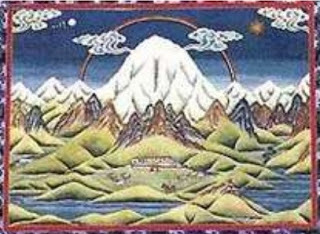 In ancient Iranian thought, a mountain called "Hara Berezaiti," or "Albordj" stands at the center of the Earth, a fixed point around which the Sun, Moon, and stars revolve. At its summit lies the dwelling place of "Ormuzd" the lord of light, complete with a giant miraculous tree, an Edenic "garden of Ahuramazda," and the celestial fountain "Arduisur," which is the mother of all Earthly water and flows down towards four cardinal points into four large streams. The bridge "Tschinevad" reaches from the peak of Albordj to the solid vault of heaven, or "Gorodman," the home of the pious and blessed, whilst underneath lies the great gulf of Duzahk, the abysmal abode of the lord of darkness, "Ahriman."
In ancient Iranian thought, a mountain called "Hara Berezaiti," or "Albordj" stands at the center of the Earth, a fixed point around which the Sun, Moon, and stars revolve. At its summit lies the dwelling place of "Ormuzd" the lord of light, complete with a giant miraculous tree, an Edenic "garden of Ahuramazda," and the celestial fountain "Arduisur," which is the mother of all Earthly water and flows down towards four cardinal points into four large streams. The bridge "Tschinevad" reaches from the peak of Albordj to the solid vault of heaven, or "Gorodman," the home of the pious and blessed, whilst underneath lies the great gulf of Duzahk, the abysmal abode of the lord of darkness, "Ahriman." The earliest cosmogony recorded by the Japanese in their most ancient book, the Koji-ki, once again mirrors this recurring mythology. In the beginning, Izanagi and Izanani, the great god and goddess standing in heaven drove a celestial spear into the endless sea and twisted it around until an island rose from the water. They then descended from heaven to Earth and built a palace around the huge spear using it as the central pillar. This spear became the central axis of the world and their palace the birthplace of the human race. In the Koji-ki and Shinto religion, the Creator and the North Pole are so purposely and inseparably linked that one of the often used names of God translates to: The Lord of the Center of Heaven. The "Ainos," supposed first inhabitants of Japan, whose name means "offspring of the centered," are believed to have arrived onto the archipelago "from the North," and bury their dead facing North to where their ancestors came and to which their spirits would return.
The earliest cosmogony recorded by the Japanese in their most ancient book, the Koji-ki, once again mirrors this recurring mythology. In the beginning, Izanagi and Izanani, the great god and goddess standing in heaven drove a celestial spear into the endless sea and twisted it around until an island rose from the water. They then descended from heaven to Earth and built a palace around the huge spear using it as the central pillar. This spear became the central axis of the world and their palace the birthplace of the human race. In the Koji-ki and Shinto religion, the Creator and the North Pole are so purposely and inseparably linked that one of the often used names of God translates to: The Lord of the Center of Heaven. The "Ainos," supposed first inhabitants of Japan, whose name means "offspring of the centered," are believed to have arrived onto the archipelago "from the North," and bury their dead facing North to where their ancestors came and to which their spirits would return.  In Buddhist funeral ceremonies bodies are cremated in special crematoriums actually called "Meru" which are essentially tall stone pillars with four doors at the peak aligned to the cardinal directions, with the belief that our reincarnated souls will pass Mount Meru before returning to earthly bodies. Literally every temple and the little spirit house shrines found in most Buddhist homes are also representations of Meru, the abode of the gods, aligned to the four cardinal directions, and opulently embellished with gold, jewelry and metaphysical artwork.
In Buddhist funeral ceremonies bodies are cremated in special crematoriums actually called "Meru" which are essentially tall stone pillars with four doors at the peak aligned to the cardinal directions, with the belief that our reincarnated souls will pass Mount Meru before returning to earthly bodies. Literally every temple and the little spirit house shrines found in most Buddhist homes are also representations of Meru, the abode of the gods, aligned to the four cardinal directions, and opulently embellished with gold, jewelry and metaphysical artwork.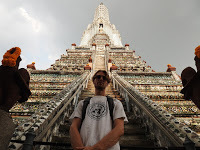 "Koeppen assures us that 'every orthodoxly constructed Buddhist temple either is, or contains, a symbolical representation of the divine regions of Meru, and of the heaven of the gods, saints, and Buddha’s, rising above it.' Lillie says, 'The thirteen pyramidal layers at the top of every temple in Nepal represent the thirteen unchangeable heavens of Amitabha.' Faber develops the evidence of this practice among the ancients with great fullness, and with respect to the Hindus and Buddhists says, 'each pagoda, each pyramid, each montiform high-place is invariably esteemed to be a copy of the holy hill Meru.'" -Dr. William Warren, “Paradise Found: The Cradle of the Human Race at the North Pole” (229-30)
"Koeppen assures us that 'every orthodoxly constructed Buddhist temple either is, or contains, a symbolical representation of the divine regions of Meru, and of the heaven of the gods, saints, and Buddha’s, rising above it.' Lillie says, 'The thirteen pyramidal layers at the top of every temple in Nepal represent the thirteen unchangeable heavens of Amitabha.' Faber develops the evidence of this practice among the ancients with great fullness, and with respect to the Hindus and Buddhists says, 'each pagoda, each pyramid, each montiform high-place is invariably esteemed to be a copy of the holy hill Meru.'" -Dr. William Warren, “Paradise Found: The Cradle of the Human Race at the North Pole” (229-30)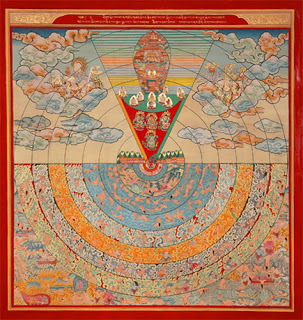 Ancient South American traditions also believed the human race was birthed in the farthest North, upon the highest of mountains, surrounded by perpetual clouds, fountainhead of the world's waters, and home of god Tlaloc, residing on their sacred paradise mountain Tlapallan. The first man, Quetzalcoatl, was said to have drank the water of immortality from Tlaloc's mountain and ruled as king throughout a golden age in Mexico. The many Incan, Mayan, Aztec and other step-pyramids and temples aligned to cardinal directions and devoted to the gods are representative of this world mountain. Interestingly enough, many modern Mexican myths now represent the mountain as crooked or partly turned over.
Ancient South American traditions also believed the human race was birthed in the farthest North, upon the highest of mountains, surrounded by perpetual clouds, fountainhead of the world's waters, and home of god Tlaloc, residing on their sacred paradise mountain Tlapallan. The first man, Quetzalcoatl, was said to have drank the water of immortality from Tlaloc's mountain and ruled as king throughout a golden age in Mexico. The many Incan, Mayan, Aztec and other step-pyramids and temples aligned to cardinal directions and devoted to the gods are representative of this world mountain. Interestingly enough, many modern Mexican myths now represent the mountain as crooked or partly turned over.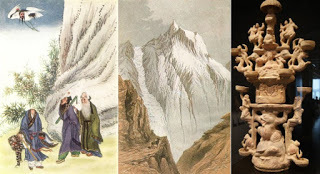 Similarly, in the ancient Chinese Taoist tradition, a myth over 4000 years old refers to Shang-te, the highest of all gods who lives in "Tsze-wei," described as "a celestial space above the North Pole." Shang-te's abode is said to exist directly over the peak of Mount Kunlun, which again places the "highest god" at Polaris. As with the other cosmologies, Mount Kunlun is a primeval paradise, abode of the gods, with a world tree in the middle, and a fountain of immortality from which four rivers flow outwards to the four corners of the Earth.
Similarly, in the ancient Chinese Taoist tradition, a myth over 4000 years old refers to Shang-te, the highest of all gods who lives in "Tsze-wei," described as "a celestial space above the North Pole." Shang-te's abode is said to exist directly over the peak of Mount Kunlun, which again places the "highest god" at Polaris. As with the other cosmologies, Mount Kunlun is a primeval paradise, abode of the gods, with a world tree in the middle, and a fountain of immortality from which four rivers flow outwards to the four corners of the Earth. 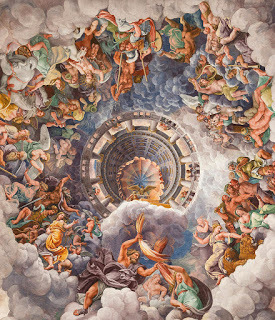 "Sparkling fountains and purling streams contain the far-famed ambrosia. One may there rest on flowery carpeted swards, listening to the melodious warbling of birds, or feasting upon the delicious fruits, at once fragrant and luscious, which hang from the branches of the luxuriant groves. Whatever there is beautiful in landscape or grand in nature may also be found there in the highest state of perfection. All is charming, all enchanting, and whilst nature smiles the company of genii delights the ravished visitor. Where now, is this Paradise Mountain located? At the North Pole ... Immediately over the central peak of Kwen-lun appears the Polar star, which is Shang-te's heavenly abode. In the central place, the Polar star of Heaven, the one Bright One, the Great Monad always dwells. In accordance with this conception, the Emperor and his assistants when officiating before the Altar of Heaven, always face the North. The Pole-star itself is a prominent object of worship." -Dr. William Warren, “Paradise Found: The Cradle of the Human Race at the North Pole” (144, 216)
"Sparkling fountains and purling streams contain the far-famed ambrosia. One may there rest on flowery carpeted swards, listening to the melodious warbling of birds, or feasting upon the delicious fruits, at once fragrant and luscious, which hang from the branches of the luxuriant groves. Whatever there is beautiful in landscape or grand in nature may also be found there in the highest state of perfection. All is charming, all enchanting, and whilst nature smiles the company of genii delights the ravished visitor. Where now, is this Paradise Mountain located? At the North Pole ... Immediately over the central peak of Kwen-lun appears the Polar star, which is Shang-te's heavenly abode. In the central place, the Polar star of Heaven, the one Bright One, the Great Monad always dwells. In accordance with this conception, the Emperor and his assistants when officiating before the Altar of Heaven, always face the North. The Pole-star itself is a prominent object of worship." -Dr. William Warren, “Paradise Found: The Cradle of the Human Race at the North Pole” (144, 216) Both the ancient Orientals and Greeks turned to face north before commencing prayer. Homer states that when addressing the gods of "Mount Olympus" they would stretch their arms towards the Northern sky, and Plato also confirms that this "holy habitation of Zeus was placed in the center of the world." Heraclitus said that "it touches the ether and casts a shadow five thousand stadia in length." Herodotus stated the mountain to be "very tapering and round; so lofty, moreover, that the top cannot be seen, the clouds never quitting it either summer or winter. The natives call this mountain The Pillar of Heaven, and they themselves take their name from it, being called Atlantes. They are reported not to eat any living thing." Strabo claimed it was an earthly paradise with gigantic olive trees and grape clusters a cubit in length. Pliny described a river of milk descending from great heights and called the mountain a "fabulosissimum." Maximus Tyrius claimed the ocean waves stopped short before reaching the mountain, "standing up like a wall around its base, though unrestrained by any earthly barrier. Nothing but the air and the sacred thicket prevent the water from reaching the mountain." In the Phaedo, Socrates is quoted as saying, "all things that grow trees and flowers and fruit are fairer than any here; and there are hills and stones in them smoother and more transparent and fairer in color than our highly-valued emeralds and sardonyx and jaspers and other gems, which are but minute fragments of them: for there all the stones are like our precious stones, and fairer still. The temperament of their seasons is such that the inhabitants have no disease, and live much longer than we do, and have sight and hearing and smell and all the other senses in much greater perfection. And they have temples and sacred places in which the gods really dwell, and they hear their voices, and receive their answers, and are conscious of them, and hold converse with them, and they see the Sun, the Moon, and the stars as they really are."
Both the ancient Orientals and Greeks turned to face north before commencing prayer. Homer states that when addressing the gods of "Mount Olympus" they would stretch their arms towards the Northern sky, and Plato also confirms that this "holy habitation of Zeus was placed in the center of the world." Heraclitus said that "it touches the ether and casts a shadow five thousand stadia in length." Herodotus stated the mountain to be "very tapering and round; so lofty, moreover, that the top cannot be seen, the clouds never quitting it either summer or winter. The natives call this mountain The Pillar of Heaven, and they themselves take their name from it, being called Atlantes. They are reported not to eat any living thing." Strabo claimed it was an earthly paradise with gigantic olive trees and grape clusters a cubit in length. Pliny described a river of milk descending from great heights and called the mountain a "fabulosissimum." Maximus Tyrius claimed the ocean waves stopped short before reaching the mountain, "standing up like a wall around its base, though unrestrained by any earthly barrier. Nothing but the air and the sacred thicket prevent the water from reaching the mountain." In the Phaedo, Socrates is quoted as saying, "all things that grow trees and flowers and fruit are fairer than any here; and there are hills and stones in them smoother and more transparent and fairer in color than our highly-valued emeralds and sardonyx and jaspers and other gems, which are but minute fragments of them: for there all the stones are like our precious stones, and fairer still. The temperament of their seasons is such that the inhabitants have no disease, and live much longer than we do, and have sight and hearing and smell and all the other senses in much greater perfection. And they have temples and sacred places in which the gods really dwell, and they hear their voices, and receive their answers, and are conscious of them, and hold converse with them, and they see the Sun, the Moon, and the stars as they really are."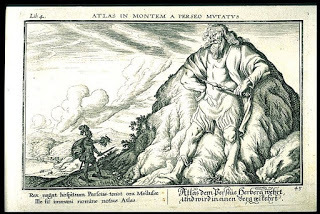 "The evidence that in ancient Hellenic thought, also, the heaven of the gods was in the northern sky is incidental, but cumulative and satisfactory. For example, heaven is upheld by Atlas, but the terrestrial station of Atlas, as we have elsewhere shown, is at the North Pole. Again, Olympos was the abode of the gods; but if the now generally current etymology of this term is correct, Olympos was simply the Atlantean pillar, pictured as a lofty mountain, and supporting the sky at its northern Pole. In fact, many writers now affirm that the Olympos of Greek mythology was originally simply the north polar ‘World-mountain' of the Asiatic nations." -Dr. William Warren, “Paradise Found: The Cradle of the Human Race at the North Pole” (212)
"The evidence that in ancient Hellenic thought, also, the heaven of the gods was in the northern sky is incidental, but cumulative and satisfactory. For example, heaven is upheld by Atlas, but the terrestrial station of Atlas, as we have elsewhere shown, is at the North Pole. Again, Olympos was the abode of the gods; but if the now generally current etymology of this term is correct, Olympos was simply the Atlantean pillar, pictured as a lofty mountain, and supporting the sky at its northern Pole. In fact, many writers now affirm that the Olympos of Greek mythology was originally simply the north polar ‘World-mountain' of the Asiatic nations." -Dr. William Warren, “Paradise Found: The Cradle of the Human Race at the North Pole” (212)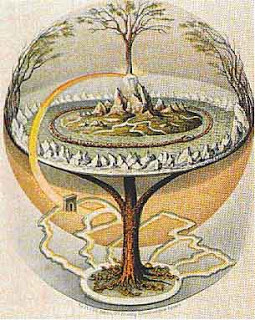 The ancient Germanic and Finnish people also, when praying or sacrificing to the gods, always faced north, and in the Scandinavian Eddas, both Asgard and Idavollr are represented as the "navel" or center of the world. For them, atop the Yggdrasil tree at Earth's center was the heavenly "Asgard," home of the gods. Today we still pay respect to this primitive tradition at Christmas when we top our symbolic world trees with a bright yellow Pole star.
The ancient Germanic and Finnish people also, when praying or sacrificing to the gods, always faced north, and in the Scandinavian Eddas, both Asgard and Idavollr are represented as the "navel" or center of the world. For them, atop the Yggdrasil tree at Earth's center was the heavenly "Asgard," home of the gods. Today we still pay respect to this primitive tradition at Christmas when we top our symbolic world trees with a bright yellow Pole star.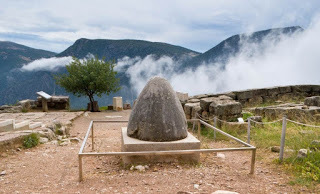 "We have already seen that the term 'navel' was anciently used in many languages for 'centre,' and that the Pole, or central point of the revolving constellations, was the 'Navel of Heaven.' But as to the celestial Pole there corresponds a terrestrial one, so it is only natural that to the term the 'Navel of Heaven' there should be the corresponding expression the 'Navel of the Earth.' Beginning with Christian traditions, let us make a pilgrimage to the Church of the Holy Sepulchre at Jerusalem. There, in the portion belonging to the Greek Christians, we shall discover a round pillar, some two feet high, projecting from the marble pavement, but supporting nothing. If we inquire as to its purpose, we shall be informed that it is designed to mark the exact centre or 'Navel' of the Earth. Early pilgrims and chroniclers refer to this curious monument, but its antiquity no one knows." -Dr. William Warren, “Paradise Found: The Cradle of the Human Race at the North Pole” (227)
"We have already seen that the term 'navel' was anciently used in many languages for 'centre,' and that the Pole, or central point of the revolving constellations, was the 'Navel of Heaven.' But as to the celestial Pole there corresponds a terrestrial one, so it is only natural that to the term the 'Navel of Heaven' there should be the corresponding expression the 'Navel of the Earth.' Beginning with Christian traditions, let us make a pilgrimage to the Church of the Holy Sepulchre at Jerusalem. There, in the portion belonging to the Greek Christians, we shall discover a round pillar, some two feet high, projecting from the marble pavement, but supporting nothing. If we inquire as to its purpose, we shall be informed that it is designed to mark the exact centre or 'Navel' of the Earth. Early pilgrims and chroniclers refer to this curious monument, but its antiquity no one knows." -Dr. William Warren, “Paradise Found: The Cradle of the Human Race at the North Pole” (227)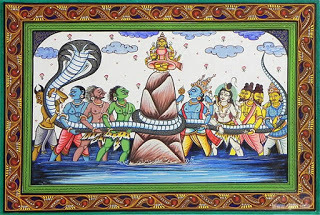 In the Indian Puranas, both the terms "Navel of the Earth," and "Navel of Heaven," are used repeatedly and always referring to a place not in or near India, but rather at the North Pole. Hymns from the Rig Veda speak of the "supporting column of heaven" otherwise known as the Atlas pillar of Vedic cosmology, and describe it as "standing upon the Navel of Earth." In the fifth verse of the one hundred and eighty-fifth hymn, Day and Night are represented as twin sisters in the bosom of their parents Heaven and Earth, where they lock arms and spin circles around a common center point, namely the navel. This is also echoed in a mysterious passage by Quintus Curtius which has baffled modern commentators stating how the object which represented the divine being resembled a "navel set in gems."
In the Indian Puranas, both the terms "Navel of the Earth," and "Navel of Heaven," are used repeatedly and always referring to a place not in or near India, but rather at the North Pole. Hymns from the Rig Veda speak of the "supporting column of heaven" otherwise known as the Atlas pillar of Vedic cosmology, and describe it as "standing upon the Navel of Earth." In the fifth verse of the one hundred and eighty-fifth hymn, Day and Night are represented as twin sisters in the bosom of their parents Heaven and Earth, where they lock arms and spin circles around a common center point, namely the navel. This is also echoed in a mysterious passage by Quintus Curtius which has baffled modern commentators stating how the object which represented the divine being resembled a "navel set in gems." 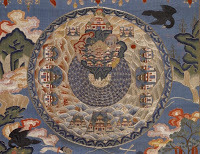 “If anything is needed to disprove the common notion that geographical ignorance and national self-esteem first governed the ancient peoples in locating in their own countries ‘navels’ of the earth, it is furnished by what is, in all probability, the oldest epic in the world, that of Izdhubar, fragments of which have survived in the oldest literature of Babylonia. These fragments show that the earliest inhabitants of the Tigro-Euphrates basin located ‘the Centre of the Earth,’ not in their own midst, but in a far-off land, of sacred associations, where ‘the holy house of the gods’ is situated - a land ‘into the heart whereof man hath not penetrated;’ a place underneath the ‘overshadowing world-tree’ and beside the ‘full waters.’ No description could more perfectly identify the spot with the Arctic Pole of ancient Asiatic mythology. Yet this testimony stands not alone; for in the fragment of another ancient text, translated by Sayce in ‘Records of the Past,’ we are told of a ‘dwelling’ which ‘the gods created for’ the first human beings, - a dwelling in which they ‘became great’ and ‘increased in numbers,’ and the location of which is described in words exactly corresponding to those of Iranian, Indian, Chinese, Eddaic, and Aztec literature; namely, in the Centre of the Earth.” -Dr. William Warren, “Paradise Found: The Cradle of the Human Race at the North Pole” (239-40)
“If anything is needed to disprove the common notion that geographical ignorance and national self-esteem first governed the ancient peoples in locating in their own countries ‘navels’ of the earth, it is furnished by what is, in all probability, the oldest epic in the world, that of Izdhubar, fragments of which have survived in the oldest literature of Babylonia. These fragments show that the earliest inhabitants of the Tigro-Euphrates basin located ‘the Centre of the Earth,’ not in their own midst, but in a far-off land, of sacred associations, where ‘the holy house of the gods’ is situated - a land ‘into the heart whereof man hath not penetrated;’ a place underneath the ‘overshadowing world-tree’ and beside the ‘full waters.’ No description could more perfectly identify the spot with the Arctic Pole of ancient Asiatic mythology. Yet this testimony stands not alone; for in the fragment of another ancient text, translated by Sayce in ‘Records of the Past,’ we are told of a ‘dwelling’ which ‘the gods created for’ the first human beings, - a dwelling in which they ‘became great’ and ‘increased in numbers,’ and the location of which is described in words exactly corresponding to those of Iranian, Indian, Chinese, Eddaic, and Aztec literature; namely, in the Centre of the Earth.” -Dr. William Warren, “Paradise Found: The Cradle of the Human Race at the North Pole” (239-40)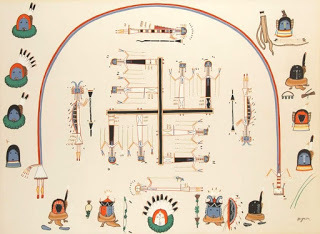 "Among the ancient Inca-subjects of Peru was found the same idea of a Navel of the Earth, and even among the Chickasaws of Mississippi. Thus is all ancient thought full of this legendary idea of a mysterious, primeval, holy, Paradisiac Earth-centre, a spot connected as is no other with the 'Centre of Heaven,' the Paradise of God. Why it should be so no one has ever told us; but the hypothesis which places the Biblical Eden at the Pole, and makes all later earth navels commemorative of that primal one, affords a perfect explanation. In the light of it, there is no difficulty in understanding that Earth-centre in Jerusalem with which we began. The inconspicuous pillar in the Church of the Holy Sepulchre symbolizes and commemorates far more than the geographical ignorance of mediaeval ages. It stands for the Japanese pillar by which the first soul born upon earth mounted to the sky. It stands for the World-column of the East-Aryans and the Chinvat Bridge of Iran. It stands for the law-proclaiming pillar of orichalcum in Atlantis, placed in the centre of the most central land. It stands for that Talmudic pillar by means of which the tenants of the terrestrial Paradise mount to the celestial, and, having spent the Sab- bath, return to pass the week below. It symbolizes Cardo, Atlas, Meru, Hara-berezaiti, Kharsak-Kurra, every fabulous mountain on whose top the sky pivots itself, and around which all the heavenly bodies ceaselessly revolve. It perpetuates a religious symbolism which existed in its region before ever Jerusalem had been made the Hebrew capital, recalling to our modern world the tabbur ha-aretz of a period anterior to the days of Samuel. In tradition it is said to mark the precise spot 'whence the clay was taken, out of which the body of Adam was modeled.' It does so, but it does it in a language and method which were common to all the most ancient nations of the earth. It points not to the soil in which it stands, but to the holier soil of a far-away primitive Eden." -Dr. William Warren, “Paradise Found: The Cradle of the Human Race at the North Pole” (247-9)
"Among the ancient Inca-subjects of Peru was found the same idea of a Navel of the Earth, and even among the Chickasaws of Mississippi. Thus is all ancient thought full of this legendary idea of a mysterious, primeval, holy, Paradisiac Earth-centre, a spot connected as is no other with the 'Centre of Heaven,' the Paradise of God. Why it should be so no one has ever told us; but the hypothesis which places the Biblical Eden at the Pole, and makes all later earth navels commemorative of that primal one, affords a perfect explanation. In the light of it, there is no difficulty in understanding that Earth-centre in Jerusalem with which we began. The inconspicuous pillar in the Church of the Holy Sepulchre symbolizes and commemorates far more than the geographical ignorance of mediaeval ages. It stands for the Japanese pillar by which the first soul born upon earth mounted to the sky. It stands for the World-column of the East-Aryans and the Chinvat Bridge of Iran. It stands for the law-proclaiming pillar of orichalcum in Atlantis, placed in the centre of the most central land. It stands for that Talmudic pillar by means of which the tenants of the terrestrial Paradise mount to the celestial, and, having spent the Sab- bath, return to pass the week below. It symbolizes Cardo, Atlas, Meru, Hara-berezaiti, Kharsak-Kurra, every fabulous mountain on whose top the sky pivots itself, and around which all the heavenly bodies ceaselessly revolve. It perpetuates a religious symbolism which existed in its region before ever Jerusalem had been made the Hebrew capital, recalling to our modern world the tabbur ha-aretz of a period anterior to the days of Samuel. In tradition it is said to mark the precise spot 'whence the clay was taken, out of which the body of Adam was modeled.' It does so, but it does it in a language and method which were common to all the most ancient nations of the earth. It points not to the soil in which it stands, but to the holier soil of a far-away primitive Eden." -Dr. William Warren, “Paradise Found: The Cradle of the Human Race at the North Pole” (247-9) In Freemasonic temples, on Freemasonic tracing boards, and upon Freemasonic aprons can be found similar symbolism pointing to these concepts. Namely, a flat Earth framed by pillars covered by an arch firmament, often with the tallest or most prominent pillar positioned centrally and a single eye representing Polaris situated above it. The Sun and Moon are also usually shown on either side representing their paths/positions over and around the flat Earth. This knowledge was clearly wide-spread among the ancient world but in modern times has become occulted by certain such secret societies and vested interests.
In Freemasonic temples, on Freemasonic tracing boards, and upon Freemasonic aprons can be found similar symbolism pointing to these concepts. Namely, a flat Earth framed by pillars covered by an arch firmament, often with the tallest or most prominent pillar positioned centrally and a single eye representing Polaris situated above it. The Sun and Moon are also usually shown on either side representing their paths/positions over and around the flat Earth. This knowledge was clearly wide-spread among the ancient world but in modern times has become occulted by certain such secret societies and vested interests. 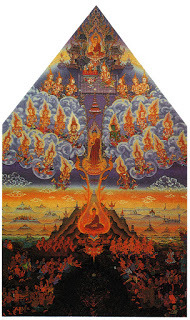 "Everywhere, therefore, in the most ancient ethnic thought, in the Egyptian, Akkadian, Assyrian, Babylonian, Indian, Persian, Chinese, and Greek, everywhere is encountered this conception of what, looked at with respect to its base and magnitude, is called the 'Mountain of the World,' but looked at with respect to its glorious summit and its celestial inhabitants is styled the 'Mountain of the Gods.' We need not pursue the investigation further. Enough has been said to warrant the assertion of Dr. Samuel Beal: 'It is plain that this idea of a lofty central primeval mountain belonged to the undivided human race.' Elsewhere the same learned Sinologue has said, 'I have no doubt that the idea of a central mountain, and of the rivers flowing from it, and the abode of the gods upon its summit, is a primitive myth derived from the earliest traditions of our race.'" -Dr. William Warren, “Paradise Found: The Cradle of the Human Race at the North Pole” (137)
"Everywhere, therefore, in the most ancient ethnic thought, in the Egyptian, Akkadian, Assyrian, Babylonian, Indian, Persian, Chinese, and Greek, everywhere is encountered this conception of what, looked at with respect to its base and magnitude, is called the 'Mountain of the World,' but looked at with respect to its glorious summit and its celestial inhabitants is styled the 'Mountain of the Gods.' We need not pursue the investigation further. Enough has been said to warrant the assertion of Dr. Samuel Beal: 'It is plain that this idea of a lofty central primeval mountain belonged to the undivided human race.' Elsewhere the same learned Sinologue has said, 'I have no doubt that the idea of a central mountain, and of the rivers flowing from it, and the abode of the gods upon its summit, is a primitive myth derived from the earliest traditions of our race.'" -Dr. William Warren, “Paradise Found: The Cradle of the Human Race at the North Pole” (137)"In concluding this sketch of ancient cosmology one further question naturally and inevitably thrusts itself upon us. It is this: How are the rise and the so wide diffusion of this singular world-view to be explained? In other words, how came it to pass that the ancestors of the oldest historic races and peoples agreed to regard the North Pole as the true summit of the earth and the circumpolar sky as the true heaven?" -Dr. William Warren, “Paradise Found: The Cradle of the Human Race at the North Pole” (139)
 Buy Flatlantis Now in Paperback, eBook, or ePub
Buy Flatlantis Now in Paperback, eBook, or ePub
August 26, 2020
The Flu World Order

After decades of ridicule and denial from the masses about the coming New World Order, suddenly in 2020, under the guise of a deadly kung-flu from bat soup in China, the world's richest and most powerful people have brought the world economy to its knees and their long-planned agenda to fruition. This important video was banned and my channel striked within an hour of uploading it to YouTube:
https://www.bitchute.com/video/oFESej1nv112/
https://lbry.tv/@EricDubay:c/The-Flu-World-Order:5
https://www.brighteon.com/b0308cbd-58cc-453b-8acb-a41282b1db4e

August 4, 2020
Flatlantis
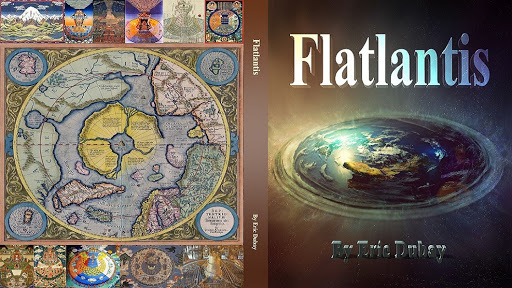
Flatlantis is an exploration into the history of Flat Earth, the mythology of Atlantis, and the mystery of Mount Meru, the alleged magnetic mountain ancient cultures worldwide believed existed at the North Pole. Beginning with a complete history of the geocentric flat Earth cosmology and subsequent gradual adoption of the heliocentric globe Earth model, Flatlantis then delves into ancient polar mythologies, early polar history/cartography, modern polar expeditions, and the myriad problems with claims made by Cook, Peary, Byrd, Scott, Amundsen, and other explorers. Finally, in a metaphysical twist, the book ends with research into Freemasonry, Christian esotericism, the Atlantean legend, Kundalini Yoga, ancient advanced civilizations and how they are all intimately connected to the North Pole.
As with all of my books, Flatlantis will eventually in the coming months be released free as a series of articles and videos available for everyone. If you're able to support me however, please help out by purchasing a copy or two for yourself and family/friends. Thank you!
Buy "Flatlantis" Ebook, Epub or Paperback Now
https://www.lulu.com/spotlight/ericdubay

July 16, 2020
The Biology of Belief
 Our brains are made up of tiny nerve cells called “neurons” which branch out and connect to each other forming a neural network. At each connection point, thoughts and emotions are incubated and holographically stored by associative memory. This means that all ideas, thoughts, feelings, and memories are interconnected and have possible relationships with one another. For instance the concept of motherhood is stored in all our neural networks, but each person’s concept is built from their own unique amalgamation of ideas, emotions and past experiences. Some people may have motherhood connected to unconditional love and forgiveness, so when they think about motherhood, they experience memories/feelings of happiness and acceptance. Other people may have motherhood connected to disappointment and ridicule, so when they think about motherhood, they experience memories/feelings of rejection and depression. We all build our own neural networks based on our own subjective experiences, how we perceive and what we believe.
Our brains are made up of tiny nerve cells called “neurons” which branch out and connect to each other forming a neural network. At each connection point, thoughts and emotions are incubated and holographically stored by associative memory. This means that all ideas, thoughts, feelings, and memories are interconnected and have possible relationships with one another. For instance the concept of motherhood is stored in all our neural networks, but each person’s concept is built from their own unique amalgamation of ideas, emotions and past experiences. Some people may have motherhood connected to unconditional love and forgiveness, so when they think about motherhood, they experience memories/feelings of happiness and acceptance. Other people may have motherhood connected to disappointment and ridicule, so when they think about motherhood, they experience memories/feelings of rejection and depression. We all build our own neural networks based on our own subjective experiences, how we perceive and what we believe.  "What we ultimately do is tell ourselves a story about what the outside world is. Any information that we process, any information that we take in from the environment is always colored by the experiences that we've had and an emotional response that we're having to what we're bringing in. Who is in the driver's seat when we control our emotions or we respond to our emotions? We know physiologically that nerve cells that fire together, wire together. If you practice something over and over, those nerve cells have a long-term relationship. If you get angry on a daily basis, if you get frustrated on a daily basis, if you suffer on a daily basis, if you give reason for the victimization in your life, you're rewiring and reintegrating that neural net on a daily basis, and that neural net now has a long-term relationship with all those other nerve cells called an 'identity.' We also know that nerve cells that don't fire together, no longer wire together. They lose their long-term relationship because every time we interrupt the thought process that produces a chemical response in the body, every time we interrupt it, those nerve cells that are connected to each other start breaking the long-term relationship." -Dr. Joe Dispenza, "What the Bleep Do We Know?"
"What we ultimately do is tell ourselves a story about what the outside world is. Any information that we process, any information that we take in from the environment is always colored by the experiences that we've had and an emotional response that we're having to what we're bringing in. Who is in the driver's seat when we control our emotions or we respond to our emotions? We know physiologically that nerve cells that fire together, wire together. If you practice something over and over, those nerve cells have a long-term relationship. If you get angry on a daily basis, if you get frustrated on a daily basis, if you suffer on a daily basis, if you give reason for the victimization in your life, you're rewiring and reintegrating that neural net on a daily basis, and that neural net now has a long-term relationship with all those other nerve cells called an 'identity.' We also know that nerve cells that don't fire together, no longer wire together. They lose their long-term relationship because every time we interrupt the thought process that produces a chemical response in the body, every time we interrupt it, those nerve cells that are connected to each other start breaking the long-term relationship." -Dr. Joe Dispenza, "What the Bleep Do We Know?" Inside our brains, the hypothalamus acts like a tiny factory assembling various chemicals called “peptides,” small chain amino acid sequences that match the different emotions we experience. There are quite literally chemical combinations for sadness, chemical combinations for anger, chemical combinations for fear, and chemical combinations for love. There are chemical combinations to match every emotional state we experience. So the moment we feel anger, the hypothalamus immediately assembles a complementary neuro-peptide or neuro-hormone and releases it through the pituitary gland into the blood stream. Once in the bloodstream, the peptides/hormones work their way through the body and we begin developing long-term relationships between thoughts/emotions and our physical biochemistry.
Inside our brains, the hypothalamus acts like a tiny factory assembling various chemicals called “peptides,” small chain amino acid sequences that match the different emotions we experience. There are quite literally chemical combinations for sadness, chemical combinations for anger, chemical combinations for fear, and chemical combinations for love. There are chemical combinations to match every emotional state we experience. So the moment we feel anger, the hypothalamus immediately assembles a complementary neuro-peptide or neuro-hormone and releases it through the pituitary gland into the blood stream. Once in the bloodstream, the peptides/hormones work their way through the body and we begin developing long-term relationships between thoughts/emotions and our physical biochemistry.  “Candace Pert, former chief of brain biochemistry at the National Institute of Mental Health, believes the separation of mind and body is also an illusion. She and her co-workers have discovered that neuropeptides previously thought to exist only in the brain are found throughout the body. Neuropeptides are known to be important in the flow of electrical activity, resulting in transmission of electrical signals from one neuron to another when emotional activity is going on. Thus, they are believed to be messenger molecules literally carrying information around the brain. Finding them throughout the body suggests that mind is present throughout the body and that emotions are the links between matter and mind.” -Fred Alan Wolf, Ph.D., “The Spiritual Universe” (193)
“Candace Pert, former chief of brain biochemistry at the National Institute of Mental Health, believes the separation of mind and body is also an illusion. She and her co-workers have discovered that neuropeptides previously thought to exist only in the brain are found throughout the body. Neuropeptides are known to be important in the flow of electrical activity, resulting in transmission of electrical signals from one neuron to another when emotional activity is going on. Thus, they are believed to be messenger molecules literally carrying information around the brain. Finding them throughout the body suggests that mind is present throughout the body and that emotions are the links between matter and mind.” -Fred Alan Wolf, Ph.D., “The Spiritual Universe” (193) “Thoughts change brain chemistry. That sounds so simple but that’s the way it is, with our thoughts changing neurotransmitters on a daily basis. If a man walks into a room with a gun, we think “threat”, and the brain releases norepinephrine. We become tense, alert, develop sweaty palms, and our heart beats faster. If he then bites the barrel of the gun, telling us the gun is actually chocolate, the brain rapidly changes its opinion and we relax and laugh — the joke is on us… We feel what we think! Positive thinking works. As the above example suggests, what we think about a situation actually creates our mood. Passed over for a promotion, we can either think we’ll never get ahead in this job (lowering serotonin and making us depressed) or assume that we are being held back for another promotion or job transfer (makes a better mood).” -Dr. Joseph M. Carver PhD, “Emotional Memory Management: Positive Control Over Your Memory”
“Thoughts change brain chemistry. That sounds so simple but that’s the way it is, with our thoughts changing neurotransmitters on a daily basis. If a man walks into a room with a gun, we think “threat”, and the brain releases norepinephrine. We become tense, alert, develop sweaty palms, and our heart beats faster. If he then bites the barrel of the gun, telling us the gun is actually chocolate, the brain rapidly changes its opinion and we relax and laugh — the joke is on us… We feel what we think! Positive thinking works. As the above example suggests, what we think about a situation actually creates our mood. Passed over for a promotion, we can either think we’ll never get ahead in this job (lowering serotonin and making us depressed) or assume that we are being held back for another promotion or job transfer (makes a better mood).” -Dr. Joseph M. Carver PhD, “Emotional Memory Management: Positive Control Over Your Memory” Every single cell in the body has thousands of peptide receptors scattered around its surface. When a peptide enters a receptor it sends a signal to the cell which actually alters its physical and chemical makeup. If we are constantly bombarding our cells with the same negative attitudes, emotions, and beliefs, our biochemistry adapts by creating more receptor sites for those particular peptides. This leaves less receptors for essentials like nutrients, vitamins, minerals, fluid exchange, detoxing and as a result we start becoming physically/chemically addicted to the peptides produced by our negative emotions.
Every single cell in the body has thousands of peptide receptors scattered around its surface. When a peptide enters a receptor it sends a signal to the cell which actually alters its physical and chemical makeup. If we are constantly bombarding our cells with the same negative attitudes, emotions, and beliefs, our biochemistry adapts by creating more receptor sites for those particular peptides. This leaves less receptors for essentials like nutrients, vitamins, minerals, fluid exchange, detoxing and as a result we start becoming physically/chemically addicted to the peptides produced by our negative emotions. “We bring to ourselves situations that will fulfill the biochemical craving of the cells of our body by creating situations that meet our chemical needs. And the addict will always need a little bit more in order to get a rush or a high of what they’re looking for chemically. So my definition really means that if you can’t control your emotional state, you must be addicted to it … It’s biochemical. Think about this. Heroin uses the same receptor mechanisms on the cells that our emotional chemicals use. It’s easy to see then that if we can be addicted to heroin then we can be addicted to any neural peptide, any emotion.” -Dr. Joe Dispenza, “What the Bleep Do We Know?”
Much like drug addicts, people often become physically/chemically addicted and dependent on various negative states of being such as depression, victimization, frustration, or jealousy. Over time we crave more of the peptides we’re addicted to and create repetitive dramas in our lives in order to receive our next dose. As this behavior continues and our unhealthy cells divide, they create sickly offspring with more receptors for neuropeptides, less receptors for essential nutrients, and become unable to carry on proper protein production.
 “Now, all aging is the result of improper protein production. What happens when we age? Our skin loses elasticity. Well, elastin is a protein. What happens to our enzymes? We don’t digest as well. What happens to our synovial fluid? Those are proteins that become brittle and stiff. What happens to our bones? They become thin. So all aging is a result of improper protein production. So then the question arises … does nutrition really have an effect if the cell doesn’t even have the receptor sites after years of emotional abuse to even receive or to let in the nutrients that are necessary for its health?” -JZ Knight, “What the Bleep Do We Know?”
“Now, all aging is the result of improper protein production. What happens when we age? Our skin loses elasticity. Well, elastin is a protein. What happens to our enzymes? We don’t digest as well. What happens to our synovial fluid? Those are proteins that become brittle and stiff. What happens to our bones? They become thin. So all aging is a result of improper protein production. So then the question arises … does nutrition really have an effect if the cell doesn’t even have the receptor sites after years of emotional abuse to even receive or to let in the nutrients that are necessary for its health?” -JZ Knight, “What the Bleep Do We Know?”Here we see once again how negative thoughts/emotions/beliefs, especially habitual patterns, lead to physical disease and degeneration. On the flip side however, living with positive, life-affirming, non-limiting thoughts/emotions/beliefs leads to physical health, wellness, and even miraculous supernormal abilities.
 One such ability of mind over matter is known as “Inedia” or “Breatharianism.” While normal people die after a couple months without food, or a few days without water, breatharians have lived for years without either! For example, a devout Christian named Therese Neumann did not eat or drink for 35 years. In 1923 she began to drink only liquids and by 1927 she stopped even that. Under the close eye of a medical doctor and four Franciscan nurses, she was watched 24 hours a day and confirmed not to have eaten or drank anything for 2 weeks with no ill-effects, dehydration or weight loss.
One such ability of mind over matter is known as “Inedia” or “Breatharianism.” While normal people die after a couple months without food, or a few days without water, breatharians have lived for years without either! For example, a devout Christian named Therese Neumann did not eat or drink for 35 years. In 1923 she began to drink only liquids and by 1927 she stopped even that. Under the close eye of a medical doctor and four Franciscan nurses, she was watched 24 hours a day and confirmed not to have eaten or drank anything for 2 weeks with no ill-effects, dehydration or weight loss. 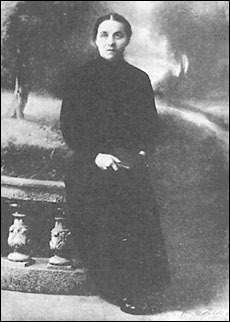 “When the local bishop in Regensburg first learned of Neumann’s fast, he sent a commission into her home to investigate. From July 14, 1927, to July 29, 1927, and under the supervision of a medical doctor named Seidl, four Franciscan nursing sisters scrutinized her every move. They watched her day and night, and the water she used for washing and rinsing her mouth was carefully measured and weighed. The sisters discovered several unusual things about Neumann. She never went to the bathroom (even after a period of six weeks she only had one bowel movement, and the excrement, examined by a Dr. Reismanns, contained only a small amount of mucus and bile, but no traces of food). She also showed no signs of dehydration, even though the average human expels about four hundred grams of water daily in the air he or she exhales, and a like amount through the pores. And her weight remained constant … At the end of the inquiry Dr. Seidl and the sisters were completely convinced that Neumann had not eaten or drunk a thing for the entire fourteen days. The test seems conclusive, for while the human body can survive two weeks without food, it can rarely survive half that time without water. Yet this was nothing for Neumann; she did not eat or drink a thing for the next thirty-five years.” -Michael Talbot, “The Holographic Universe” (153)
“When the local bishop in Regensburg first learned of Neumann’s fast, he sent a commission into her home to investigate. From July 14, 1927, to July 29, 1927, and under the supervision of a medical doctor named Seidl, four Franciscan nursing sisters scrutinized her every move. They watched her day and night, and the water she used for washing and rinsing her mouth was carefully measured and weighed. The sisters discovered several unusual things about Neumann. She never went to the bathroom (even after a period of six weeks she only had one bowel movement, and the excrement, examined by a Dr. Reismanns, contained only a small amount of mucus and bile, but no traces of food). She also showed no signs of dehydration, even though the average human expels about four hundred grams of water daily in the air he or she exhales, and a like amount through the pores. And her weight remained constant … At the end of the inquiry Dr. Seidl and the sisters were completely convinced that Neumann had not eaten or drunk a thing for the entire fourteen days. The test seems conclusive, for while the human body can survive two weeks without food, it can rarely survive half that time without water. Yet this was nothing for Neumann; she did not eat or drink a thing for the next thirty-five years.” -Michael Talbot, “The Holographic Universe” (153)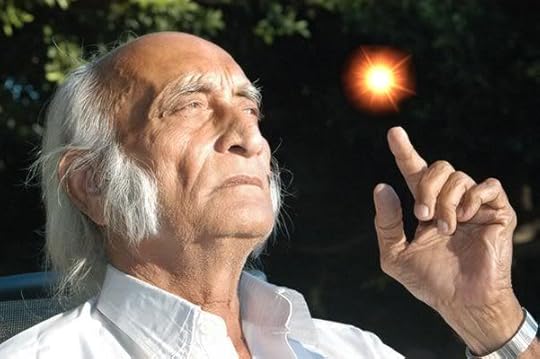 Jainist Hira Ratan Manek claims not to have eaten anything since 1995. He has been studied under controlled conditions by teams of scientists and doctors many times and was never observed to eat or drink at all. One time he went 211 days under careful supervision, another time 411 days. Even more impressive, 81 year-old Indian Sadhu Prahlad Jani claims not to have eaten or drunk anything for 70 years! He was also studied carefully under 24 hour CCTV surveillance for weeks at a time by medical professionals and didn’t eat, drink, urinate, or deficate. Many more examples of documented inedia can be found in Herbert Thurston’s book “The Physical Phenomena of Mysticism.”
Jainist Hira Ratan Manek claims not to have eaten anything since 1995. He has been studied under controlled conditions by teams of scientists and doctors many times and was never observed to eat or drink at all. One time he went 211 days under careful supervision, another time 411 days. Even more impressive, 81 year-old Indian Sadhu Prahlad Jani claims not to have eaten or drunk anything for 70 years! He was also studied carefully under 24 hour CCTV surveillance for weeks at a time by medical professionals and didn’t eat, drink, urinate, or deficate. Many more examples of documented inedia can be found in Herbert Thurston’s book “The Physical Phenomena of Mysticism.” “In the 1970s, Jack Schwarz, a Dutch-born author and lecturer, astounded researchers in laboratories across the United States with his ability to willfully control his body’s internal biological processes. In studies conducted at the Menninger Foundation, the University of California’s Langley Porter Neuropsychiatric Institute, and other, Schwarz astonished doctors by sticking mammoth six-inch sailmaker’s needles completely through his arms without bleeding, without flinching, and without producing beta brain waves (the type of brain waves normally produced when a person is in pain). Even when the needles were removed, Schwarz still did not bleed, and the puncture holes closed tightly. In addition, Schwarz altered his brain-wave rhythms at will, held burning cigarettes against his flesh without harming himself, and even carried live coals around in his hands ... He believes anyone can learn voluntary control of their body and thus gain responsibility for his or her own health.” -Michael Talbot, “The Holographic Universe” (102-3)
“In the 1970s, Jack Schwarz, a Dutch-born author and lecturer, astounded researchers in laboratories across the United States with his ability to willfully control his body’s internal biological processes. In studies conducted at the Menninger Foundation, the University of California’s Langley Porter Neuropsychiatric Institute, and other, Schwarz astonished doctors by sticking mammoth six-inch sailmaker’s needles completely through his arms without bleeding, without flinching, and without producing beta brain waves (the type of brain waves normally produced when a person is in pain). Even when the needles were removed, Schwarz still did not bleed, and the puncture holes closed tightly. In addition, Schwarz altered his brain-wave rhythms at will, held burning cigarettes against his flesh without harming himself, and even carried live coals around in his hands ... He believes anyone can learn voluntary control of their body and thus gain responsibility for his or her own health.” -Michael Talbot, “The Holographic Universe” (102-3) In 1947, during public performances at the Corso Theater in Zurich, Mirin Dajo stunned audiences with his extreme piercings. Dajo would have an assistant stab a fencing sword completely through his abdomen, clearly piercing vital organs, yet somehow causing him no pain or lasting injury. When the sword was removed he did not bleed and had only two small red spots at the entry and exit points. Dajo’s performances were so gut-wrenching and nerve-racking that one spectator actually suffered a heart attack while watching. Having piqued the interest of one Swiss doctor named Hans Naegeli-Osjord, Dajo was invited to Switzerland to have his abilities formally studied under laboratory conditions. In front of a group of doctors and journalists, Dajo had his assistant stab him through with the steel rapier and as always he did not bleed or even flinch. He then calmly walked upstairs with doctors to take his X-ray which undeniably proved that no trickery was involved and he was indeed impaled. Dajo was later tested again by scientists in Basel and allowed them to personally stab him. He even insisted that they treat him roughly and jogged several blocks while impaled to show his tolerance for pain.
In 1947, during public performances at the Corso Theater in Zurich, Mirin Dajo stunned audiences with his extreme piercings. Dajo would have an assistant stab a fencing sword completely through his abdomen, clearly piercing vital organs, yet somehow causing him no pain or lasting injury. When the sword was removed he did not bleed and had only two small red spots at the entry and exit points. Dajo’s performances were so gut-wrenching and nerve-racking that one spectator actually suffered a heart attack while watching. Having piqued the interest of one Swiss doctor named Hans Naegeli-Osjord, Dajo was invited to Switzerland to have his abilities formally studied under laboratory conditions. In front of a group of doctors and journalists, Dajo had his assistant stab him through with the steel rapier and as always he did not bleed or even flinch. He then calmly walked upstairs with doctors to take his X-ray which undeniably proved that no trickery was involved and he was indeed impaled. Dajo was later tested again by scientists in Basel and allowed them to personally stab him. He even insisted that they treat him roughly and jogged several blocks while impaled to show his tolerance for pain.  Mirin Dago and Jack Schwartz’s stories are certainly amazing but far from unique. Hawaiian Kahunas, Indian Yogis, African Shamans and others have traditionally trained to control their pain receptors so as to perform extreme piercings, lie on beds of nails, and walk on burning hot coals.
Mirin Dago and Jack Schwartz’s stories are certainly amazing but far from unique. Hawaiian Kahunas, Indian Yogis, African Shamans and others have traditionally trained to control their pain receptors so as to perform extreme piercings, lie on beds of nails, and walk on burning hot coals. “For thousands of years, people of many different cultures and religions from all parts of the world have practiced fire walking. A recent Guinness World Record for longest fire walk was set by 23-year-old Canadian Amanda Dennison in June 2005. Amanda walked 220 feet over coals that measured 1,600 to1,800 degrees Fahrenheit. Amanda didn’t jump or fly, which means her feet were in direct contact with the glowing coals for the full 30 seconds it took her to complete the walk. Many people attribute the ability to remain burn-free during such a walk to paranormal phenomena. In contrast, physicists suggest that the presumed danger is an illusion, claiming the embers are not great conductors of heat and that the walker’s feet have limited contact with the coals. Yet, very few scoffers have actually removed their shoes and socks and traversed the glowing coals, and none have matched the feat of Amanda’s feet. Besides, if the coals are really as benign as the physicists suggest, how do they account for severe burns experienced by large numbers of ‘accidental tourists’ on their firewalks?” -Dr. Bruce Lipton, “Spontaneous Evolution”
 For most people, fire walking will burn their feet, extreme piercings will cause severe pain/bleeding, and prolonged dry fasting will result in certain death, but for people who have reprogrammed their psyches with non-limiting beliefs, such feats become attainable. Another example is extreme weight lifting. The strongest record-holding bodybuilders can dead lift about 700-800 pounds (400-500 for females) but under intense psychological pressure untrained unathletic people have actually lifted several times this weight and held it for minutes at a time!
For most people, fire walking will burn their feet, extreme piercings will cause severe pain/bleeding, and prolonged dry fasting will result in certain death, but for people who have reprogrammed their psyches with non-limiting beliefs, such feats become attainable. Another example is extreme weight lifting. The strongest record-holding bodybuilders can dead lift about 700-800 pounds (400-500 for females) but under intense psychological pressure untrained unathletic people have actually lifted several times this weight and held it for minutes at a time!“To save her trapped son, Angela Cavallo lifted a 1964 Chevrolet and held it up for five minutes while neighbors arrived, reset a jack, and rescued her unconscious boy. Similarly, a construction worker lifted a 3,000-pound helicopter that had crashed into a drainage ditch, trapping his buddy under water. In this feat captured on video, the man held the aircraft aloft while others pulled his friend from beneath the wreckage. To dismiss these feats as the consequence of an adrenaline rush misses the point. Adrenaline or not, how can an untrained average man or woman lift and hold a half ton or more for an extended duration? These stories are remarkable because neither Ms. Cavallo nor the construction worker could have performed such acts of superhuman strength under normal circumstances. The idea of lifting a car or helicopter is unimaginable. But with the life of their child or friend hanging in the balance, these people unconsciously suspended their limiting beliefs and focused their intention on the foremost belief at that moment: I must save this life!” -Dr. Bruce Lipton, “Spontaneous Evolution”


Order the Spiritual Science 284-page Paperback

Download the Spiritual Science 284-page E-book




